Excellent! Let’s dive into each of these historical events with a brief overview:
Sicilian Expedition (415-413 BC, Sicily)
- What happened: During the Peloponnesian War, Athens launched a massive expedition to conquer Sicily, aiming to gain resources and weaken Sparta. However, the campaign was plagued by poor leadership, logistical problems, and fierce resistance from Syracuse. The Athenian forces were ultimately trapped and annihilated, marking a turning point in the war and the decline of Athenian power.
- Key takeaway: Overambition and strategic miscalculations can have disastrous consequences, even for powerful empires.
Battle of Cannae (216 BC, Italy)
- What happened: During the Second Punic War, the Carthaginian general Hannibal defeated a much larger Roman army. Hannibal’s brilliant tactical envelopment maneuver led to the near-destruction of the Roman legions, shocking Rome and demonstrating Hannibal’s military genius.
- Key takeaway: Tactical brilliance can overcome numerical superiority, and even the mightiest empires can be vulnerable to strategic innovation.
Teutoburg Forest (9 AD, Germany)
- What happened: A coalition of Germanic tribes, led by Arminius, ambushed and destroyed three Roman legions in the Teutoburg Forest. This devastating defeat halted Roman expansion into Germany and highlighted the challenges of fighting in unfamiliar terrain against determined adversaries.
- Key takeaway: Environmental factors and underestimating the enemy can have disastrous consequences, even for highly disciplined armies.
Battle of Red Cliffs (208 AD, China)
- What happened: An alliance of underdog forces, led by Liu Bei and Sun Quan, decisively defeated the numerically superior army of Cao Cao. Clever tactics, including the use of fire ships and exploitation of wind conditions, secured victory and shaped the course of the Three Kingdoms period in China.
- Key takeaway: Strategic alliances and exploiting environmental conditions can be crucial for overcoming seemingly insurmountable odds.
“Kamikaze” or Divine Wind (1274 & 1281, Japan)
- What happened: Typhoons, known as “kamikaze” or “divine wind,” played a crucial role in repelling two Mongol invasion fleets. These storms were interpreted as divine intervention, bolstering Japanese national identity and contributing to the legend of the kamikaze.
- Key takeaway: Natural events can profoundly impact history and shape cultural narratives.
Battle of Agincourt (1415, France)
- What happened: The English army, led by King Henry V, achieved a stunning victory over a much larger French force. The English longbow proved devastating against the heavily armored French knights, demonstrating the power of technological advantages in warfare.
- Key takeaway: Technological superiority and innovative tactics can overcome numerical disadvantages.
Battle of Tenochtitlán (1521, Mexico)
- What happened: Spanish conquistadors, led by Hernán Cortés, conquered the Aztec capital of Tenochtitlán. A combination of superior weaponry, alliances with indigenous enemies of the Aztecs, and disease contributed to the Spanish victory and the fall of the Aztec Empire.
- Key takeaway: Technological advantages, alliances, and unforeseen factors (like disease) can dramatically shift the balance of power.
Battle of Lepanto (1571, Mediterranean)
- What happened: The Holy League, a coalition of European powers, decisively defeated the Ottoman fleet. This victory marked a turning point in the Ottoman advance into Europe and demonstrated the effectiveness of combined naval power.
- Key takeaway: Naval power and strategic alliances can be critical for controlling vital sea lanes and influencing geopolitical dynamics.
Spanish Armada (1588, England Channel)
- What happened: The English navy defeated the Spanish Armada, a massive fleet sent by King Philip II to invade England. English naval tactics and superior gunnery proved decisive, thwarting the invasion and marking a shift in European naval dominance.
- Key takeaway: Naval power and technological innovation can be crucial for national defense and securing maritime supremacy.
Battles of Saratoga (1777, America)
- What happened: American forces, led by General Horatio Gates, defeated the British army in a series of battles. This decisive victory convinced France to formally ally with the Americans, providing crucial support in the Revolutionary War.
- Key takeaway: Strategic victories can have far-reaching diplomatic consequences and alter the course of revolutions.
Battle of Little Bighorn (1876, America)
- What happened: Lakota and Cheyenne warriors, led by Sitting Bull and Crazy Horse, annihilated Lieutenant Colonel George Custer’s detachment of the 7th Cavalry. This Native American victory, though temporary, highlighted the resistance to westward expansion and the complexities of the conflict.
- Key takeaway: Underestimating the enemy and disregarding cultural differences can have devastating consequences.
Battle of Isandlwana (1879, South Africa)
- What happened: Zulu forces, armed with spears and shields, decisively defeated a British force. This shocking defeat exposed British vulnerabilities and fueled the Anglo-Zulu War.
- Key takeaway: Even technologically superior armies can be vulnerable to determined resistance and tactical adaptation.
Battle of Tannenberg (1914, East Prussia)
- What happened: The German army, led by Paul von Hindenburg and Erich Ludendorff, decisively defeated the Russian Second Army. This victory secured Germany’s eastern front in the early stages of World War I.
- Key takeaway: Strategic planning, communication, and decisive leadership can be crucial for success in modern warfare.
Battle of France (1940, France)
- What happened: German forces, employing Blitzkrieg tactics, swiftly conquered France. The Allied armies were outmaneuvered and overwhelmed, leading to the fall of France and the occupation of much of Western Europe.
- Key takeaway: Technological innovation, operational boldness, and strategic surprise can lead to rapid and decisive victories.
Battle of Stalingrad (1942-1943, Russia)
- What happened: One of the bloodiest battles in history, Stalingrad witnessed brutal urban warfare between German and Soviet forces. The German defeat marked a turning point on the Eastern Front, halting the German advance and shifting the momentum toward the Soviets.
- Key takeaway: Resilience, determination, and the ability to endure immense hardship can be decisive factors in warfare.
Sicilian Expedition (415-413 BC, Silicy)
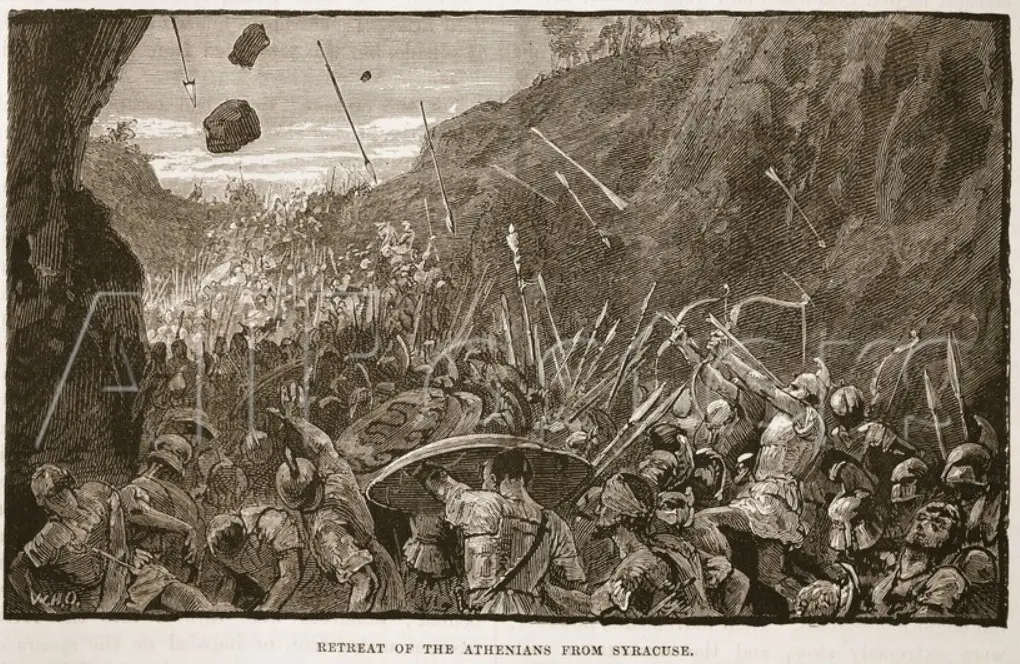
(Wiki Image).
Ten notable quotes:
From Thucydides’ History of the Peloponnesian War:
- “The Athenians, with a view to this expedition, had voted to send sixty ships to Sicily, under the command of Nicias, Alcibiades, and Lamachus.” – This sets the stage, introducing the key Athenian leaders and the initial scope of the expedition.
- “They were to assist the Egestaeans against the Selinuntines, and, if they had time, to regulate the affairs of Sicily in general.” – This reveals the initial, somewhat vague, objectives of the expedition.
- “Nicias was appointed to the command much against his will, for he was already advanced in years, and he thought himself unfit for service.” – This highlights Nicias’ reluctance and foreshadows potential leadership challenges.
- “Alcibiades, on the other hand, was eager to be at the head of the expedition, and hoped to reduce Sicily and Carthage, and after these successes to increase his private fortune and reputation.” – This reveals Alcibiades’ ambition and personal motives, which would later play a role in the expedition’s downfall.
- “The expedition’s departure was a sight that struck the beholders with awe. Never had a single city of Hellas sent forth such a fleet or such a magnificent armament.” – This captures the grandeur and scale of the Athenian expedition, highlighting the initial sense of confidence and power.
From other sources:
- “Our city, strong in its men and its ships, has sent me to you, to free your people from the oppression of the Syracusans.” (Alcibiades, addressing the Sicilian city of Catana) – This illustrates Alcibiades’ persuasive rhetoric and his attempt to gain allies in Sicily.
- “The Athenians, having come with a great fleet and army, have been defeated by the Syracusans and their allies and have lost all their ships. They have mostly perished, some by the sword and some by falling into the hands of the enemy.” (Plutarch, describing the final defeat) – This starkly conveys the magnitude of the Athenian disaster.
- “The Sicilian Expedition was the ruin of Athens.” (Diodorus Siculus) – This emphasizes the long-term impact of the defeat, contributing to the decline of Athenian power.
Reflecting on the disaster:
- “Pride goes before destruction, a haughty spirit before a fall.” (Proverbs 16:18) – This biblical proverb captures the theme of Athenian hubris and the consequences of overconfidence.
- “The greatest life lesson is to know that even fools are right sometimes.” (Winston Churchill) – While not directly related to the Sicilian Expedition, this quote highlights the importance of humility and the dangers of dismissing opposing viewpoints, a lesson the Athenians learned the hard way.
Casualties
| Force | Commander(s) | Ships (Start) | Men (estimated) | Casualties | Prisoners | Ships Lost |
| Athenian Expeditionary Force | Nicias, Alcibiades, Lamachus | 134 Triremes | ~50,000 (including rowers and support staff) | Very high, almost the entire force | Thousands captured by Syracuse | Almost all ships lost |
| Syracusan and Spartan Forces | Hermocrates, Gylippus | Initially fewer, later surpassing Athenian numbers | Initially, fewer later reinforced | Significant, but lower than Athenian losses | Some Athenians were captured, but many were killed | Significant losses, but fewer than Athenian losses |
The Sicilian Expedition: How One Campaign Decided Ancient …
The Sicilian Expedition – Complete Documentary
(YouTube video)
The Sicilian Expedition was a significant military campaign undertaken by the Athenian Empire during the Peloponnesian War against the city-state of Syracuse in 415-413 BC. This ambitious undertaking aimed to expand Athenian power in the western Mediterranean but ultimately resulted in one of the most catastrophic defeats in Athenian history. The expedition reflected the overreach of Athenian imperial ambitions and marked a turning point in the war against the Peloponnesian League, led by Sparta.
Background
The origins of the Sicilian Expedition can be traced to the broader context of the Peloponnesian War, which erupted in 431 BC between Athens and Sparta, along with their respective allies. By 415 BC, Athens had maintained a dominant position in the Aegean Sea but sought to further extend its influence by turning its attention to Sicily. The island, rich in resources and strategically located, was seen as an opportunity to bolster Athenian power and counteract Spartan influence in the region. Influenced by the orator Alcibiades, the Athenian assembly voted in favor of the expedition, leading to the mobilization of a substantial naval force.
The Objectives
The primary objective of the Sicilian Expedition was to conquer Syracuse, a powerful city-state that had the potential to challenge Athenian interests in Sicily and beyond. The Athenians aimed to gain control over Sicily’s rich agricultural land, secure trade routes, and use the island as a base for further military operations in the western Mediterranean. The expedition also hoped to encourage revolts among other Sicilian city-states against Syracuse, weakening its power and influence.
The Initial Stages
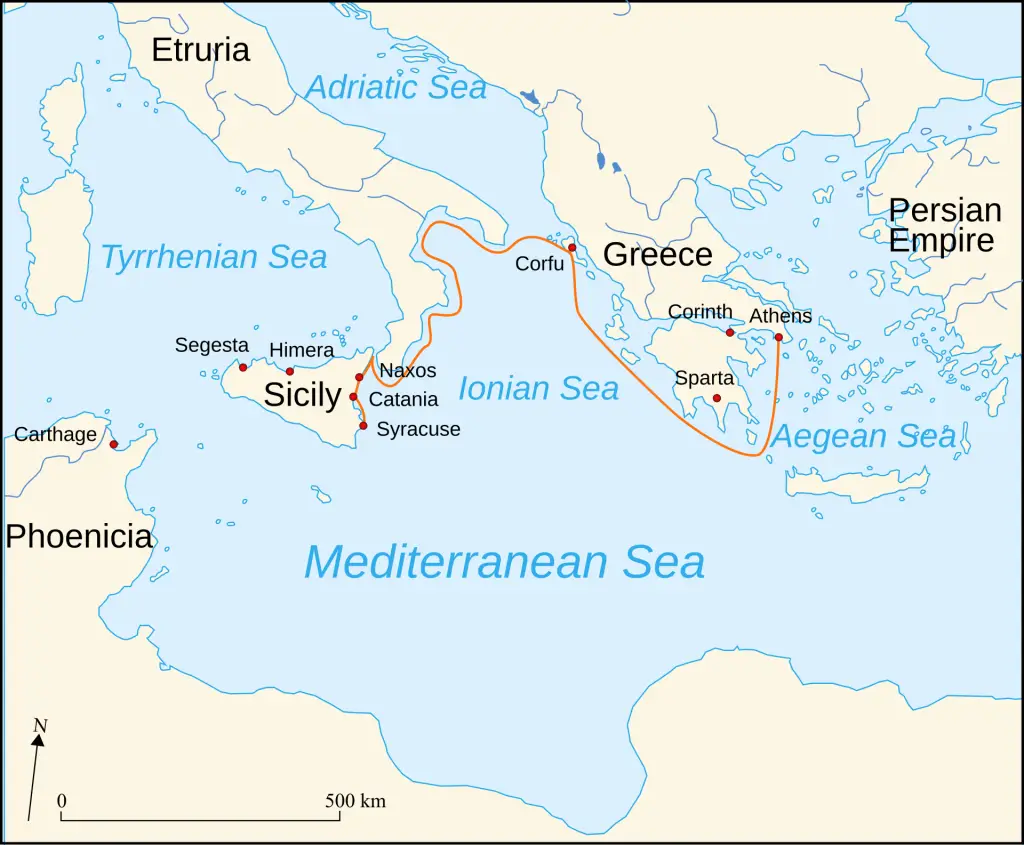
The route the Athenian fleet took to Sicily (Wiki Image).
In the spring of 415 BC, Athens launched the expedition, dispatching a formidable fleet comprising approximately 134 ships and an army of around 20,000 soldiers, including hoplites, light infantry, and cavalry. The campaign’s initial stages were marked by successes, with Athenian forces capturing several coastal cities and gaining local support. The Athenians laid siege to Syracuse, but the Syracusans, bolstered by their military resources and alliances, mounted a determined defense.
The Role of Leadership
Key figures in the expedition included the charismatic leader Alcibiades, who initially played a crucial role in rallying support for the campaign. However, political turmoil in Athens led to his abrupt departure from the expedition due to accusations of sacrilege. His departure marked a significant turning point, as leadership fell into the hands of less experienced commanders, leading to disorganization and a lack of strategic vision. The loss of Alcibiades and subsequent leadership changes significantly undermined the Athenian campaign.
The Turning Point
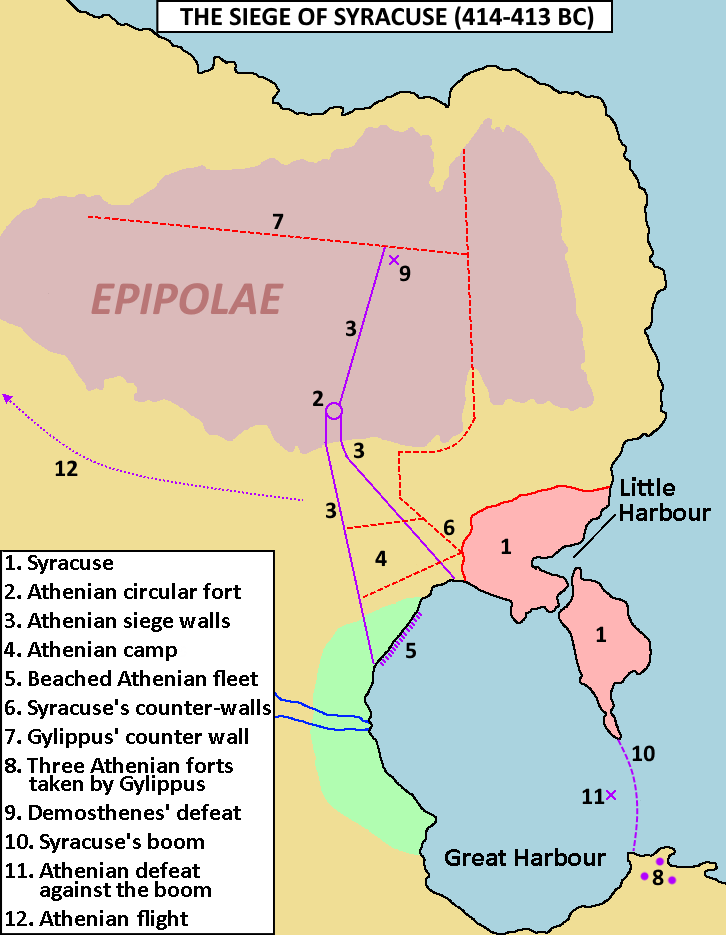
Map of the siege showing walls and counter-walls (Wiki Image).
The tide of the campaign began to turn against the Athenians in 413 BC when the Syracusans, reinforced by Spartan support and skilled military commanders, launched a counteroffensive. The Athenians found themselves increasingly isolated and besieged within their camps. Their supply lines were cut, and morale plummeted as defeat set in. The Battle of Syracuse, which included naval engagements and land battles, showcased the Athenian fleet’s vulnerabilities and the effectiveness of the Syracusan forces.
The Catastrophic Defeat
The Sicilian Expedition culminated in 413 BC when the Athenians faced a devastating defeat at Syracuse. The city’s defenses, bolstered by Spartan and local support, proved insurmountable for the exhausted Athenian forces. The Athenians suffered heavy casualties, with thousands killed or captured, including many soldiers and sailors who had been pivotal to the expedition. The remnants of the Athenian fleet were destroyed, effectively crippling Athens’ naval power in the region.
Aftermath and Consequences
The disastrous outcome of the Sicilian Expedition had far-reaching consequences for Athens and the course of the Peloponnesian War. Losing manpower, resources, and ships severely weakened Athenian military capabilities and morale. Additionally, the failure disillusioned many Athenians, leading to a shift in public opinion regarding imperial ambitions. The campaign’s failure also emboldened Athens’ enemies, notably Sparta, which capitalized on the Athenian defeat to gain an upper hand in the war.
Historical Significance
The Sicilian Expedition is a cautionary tale about the dangers of overextension and imperial ambitions’ hubris. It highlighted the vulnerabilities of even the most powerful states when faced with determined local resistance and effective leadership. The events in Sicily ultimately marked a turning point in the Peloponnesian War, setting the stage for Athens’ eventual defeat in 404 BC and the end of its imperial dominance. The expedition is often studied as a classic example of strategic failure and the consequences of miscalculation in military history.
Battle of Cannae (216 BC, Italy)
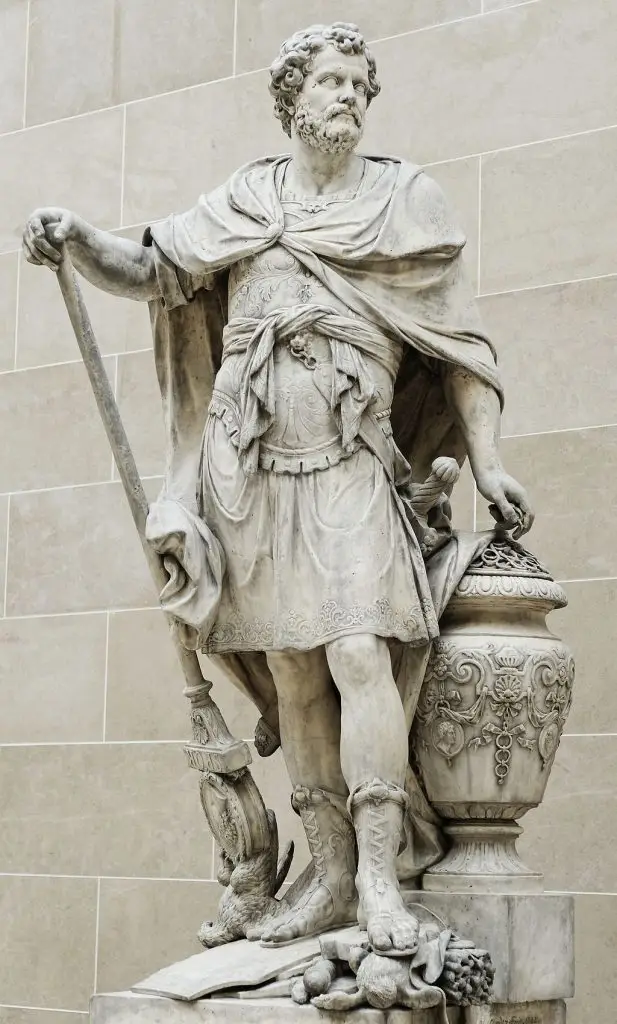
Hannibal counted the Roman knights’ signet rings killed during the battle, statue by Sébastien Slodtz, 1704, Louvre (Wiki Image).
Ten notable quotes:
Here are ten famous quotes relating to the Battle of Cannae (216 BC), one of the most significant military confrontations during the Second Punic War between Rome and Carthage:
- Hannibal Barca: “Let us see whether fear of defeat can make the Romans bolder than the hope of victory.”
– Hannibal’s bold confidence before the battle. - Livy: “There never was a greater slaughter of Romans than this.”
– Livy, a Roman historian, summarizes the magnitude of Roman losses. - Polybius: “The surrounding plain was full of dead bodies, and the adjacent rivers were discolored with blood.”
– A vivid account from the ancient historian Polybius. - Livy: “The greater the defeat, the more dangerous the enemy they faced afterward.”
– Livy commenting on the consequences of Roman defeat. - Hannibal: “The Romans, more than ever, dread Carthage’s armies after this victory.”
– Hannibal reflecting on the psychological impact of his victory. - Polybius: “Never were so many killed in one battle; for of seventy thousand Roman soldiers, not three thousand escaped.”
– Polybius describes the scope of the Roman casualties. - Quintus Fabius Maximus: “It is the strategy, not the sword, that wins wars.”
– Fabius Maximus, a Roman commander who advocated avoiding direct conflict with Hannibal, which was ignored at Cannae. - Appian: “They say the Romans despaired of the war when they heard of the result of the Battle of Cannae.”
– Appian comments on the despair Romans felt following the catastrophic loss. - Cicero: “At Cannae, we lost not only our men but our honor.”
– Cicero’s reflection on the symbolic defeat suffered by Rome. - Hannibal: “Victory is not the outcome of strength alone but strategy and timing.”
– Hannibal’s philosophy on warfare is reflected in his masterful tactics at Cannae.
Casualties
| Forces | Number of Troops | Casualties (Killed) | Prisoners | Wounded |
| Roman Army | ~86,000 | ~50,000–70,000 | ~10,000–15,000 | Unknown |
| Carthaginian Army (Hannibal) | ~50,000 | ~5,700 | Minimal (if any) | Unknown |
Rome’s Bloodiest Battle | The Day Rome Nearly Fell! | Cannae …
The Battle of Cannae (216 B.C.E.)
Rome Vs Carthage: Battle of Cannae 216 BC | Cinematic
(YouTube video)
The Battle of Cannae, fought in 216 BC during the Second Punic War, is one of history’s most significant military engagements. It was a pivotal moment in the conflict between the Roman Republic and Carthage, led by the brilliant general Hannibal Barca. The battle is particularly noted for Hannibal’s tactical genius, which resulted in a devastating defeat for the Romans and had long-lasting implications for the war and Roman military strategy.
Historical Context
The Second Punic War erupted in 218 BC after Hannibal’s daring crossing of the Alps into Italy, following a series of events that stemmed from the First Punic War. By 216 BC, Hannibal had already achieved significant victories against Roman forces, including the Battle of Lake Trasimene. The Romans, intent on avenging their losses and regaining control, mobilized a large army to confront Hannibal. This set the stage for the confrontation at Cannae, a strategic location in southeastern Italy.
The Roman Army
The Roman forces at Cannae were formidable, consisting of an estimated 86,000 soldiers, including legions and auxiliary units. Under the command of Lucius Emilius Paullus and Gaius Terentius Varro, the Romans aimed to encircle and annihilate Hannibal’s much smaller army. Confident in their numbers, the Romans sought to engage Hannibal in a decisive battle, believing a victory would end his threat to Rome and restore Roman pride after previous defeats.
Hannibal’s Strategy
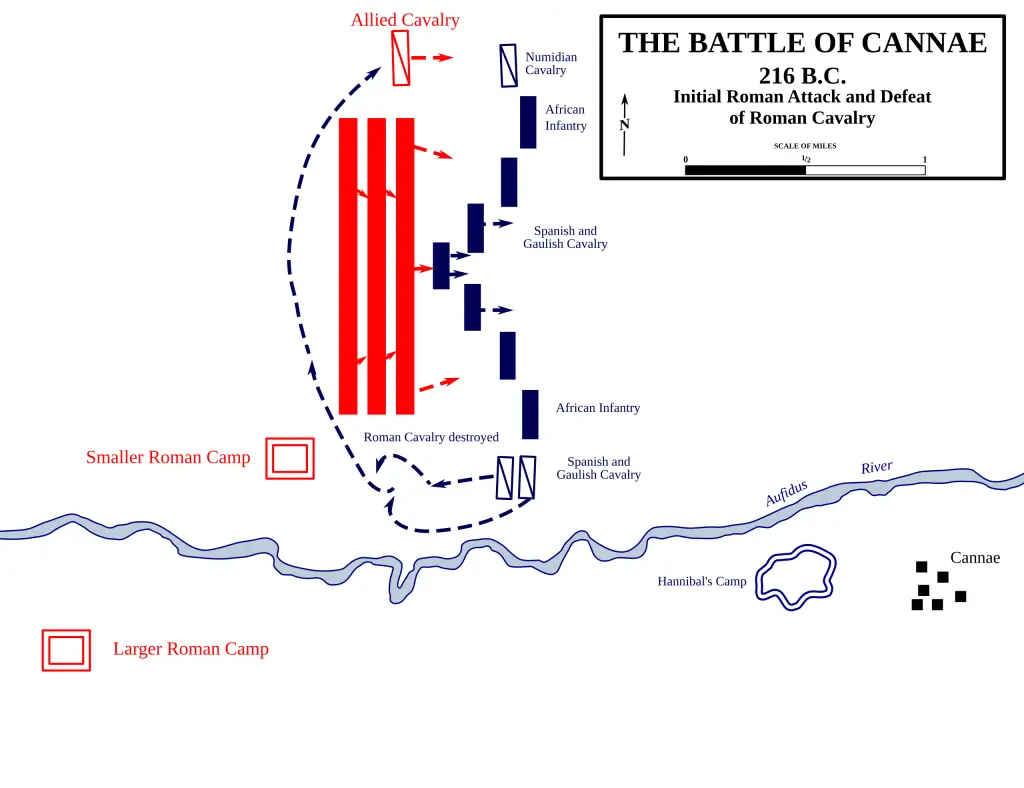
The initial deployment and Roman attack (in red) (Wiki Image).
Hannibal, commanding approximately 50,000 troops, employed a brilliant tactical strategy that would become a hallmark of military instruction for centuries. His army was composed of a diverse mix of Carthaginian soldiers, Numidian cavalry, and Gallic warriors. Understanding the strengths and weaknesses of his forces and the Romans, Hannibal devised a plan that leveraged his troops’ mobility and combat experience. He positioned his army in a crescent formation, inviting the Romans to attack.
The Battle Unfolds
On the day of the battle, Hannibal’s forces engaged the Romans, initially allowing them to advance. As the Romans pressed their attack, they became increasingly overextended, falling into the trap that Hannibal had set. Once the Romans were committed to the assault, Hannibal ordered his cavalry, commanded by Hasdrubal, to engage the Roman flanks. The Carthaginian infantry then pivoted inward, encircling the Roman forces, effectively trapping them in a deadly pincer movement.
The Decisive Moment
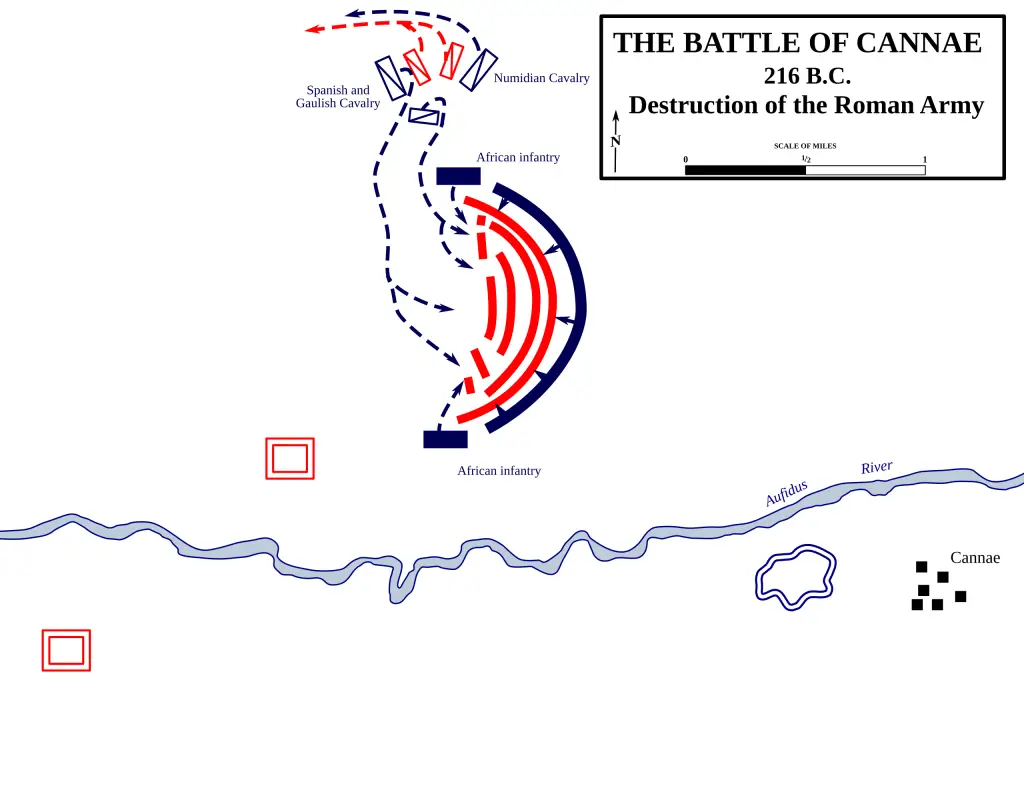
The destruction of the Roman army (Wiki Image).
The combat at Cannae was intense and brutal, with the Romans fighting fiercely to break the encirclement. However, Hannibal’s tactical brilliance and the discipline of his troops proved overwhelming. The Romans, lacking space to maneuver and being attacked from all sides, suffered catastrophic losses. Estimates suggest that around 50,000 to 70,000 Roman soldiers were killed, while many others were captured. This defeat not only decimated the Roman army but also shattered their morale.
Aftermath and Consequences
The aftermath of the Battle of Cannae was profound, with the Carthaginian victory sending shockwaves through Rome and the entire Mediterranean. The Romans were left to grapple with losing a significant portion of their army and the potential for further Carthaginian advances into Italy. Despite the defeat, Rome did not capitulate; instead, they adopted a strategy of attrition, focusing on avoiding large-scale confrontations with Hannibal’s forces while seeking to wear them down over time.
The Legacy of Cannae
Cannae has been studied extensively throughout military history and is often cited as a classic example of the double envelopment tactic. Hannibal’s victory inspired military leaders, and generations of commanders have analyzed the battle’s lessons in strategy and tactics. It also shaped Roman military doctrine, prompting reforms that would eventually lead to Rome’s resurgence and the eventual defeat of Carthage in the Second Punic War.
Conclusion
The Battle of Cannae remains a pivotal event in military history, illustrating the potential for tactical genius to overcome numerical superiority. Hannibal’s victory not only altered the Second Punic War but also left an indelible mark on the principles of warfare. The lessons learned from Cannae resonate in military strategy, serving as a testament to the enduring impact of one of history’s greatest battles.
Teutoburg Forest (9 AD, Germany)
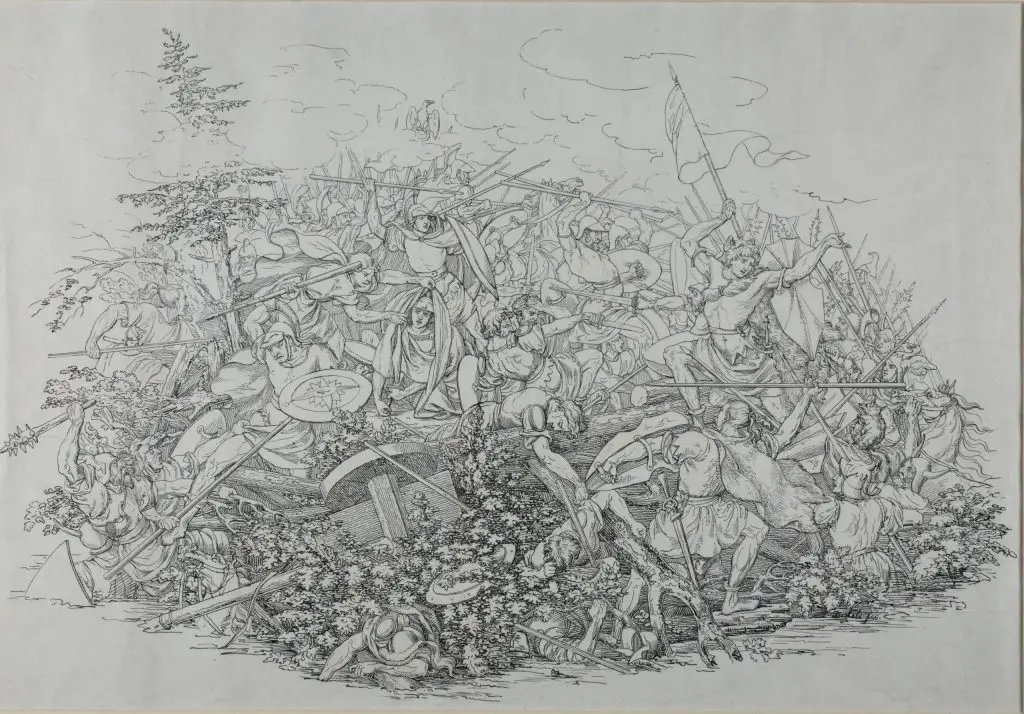
Martin Disteli‘s 1830s lithograph of Varus falling on his sword during the Battle of Teutoburg Forest (Wiki Image).
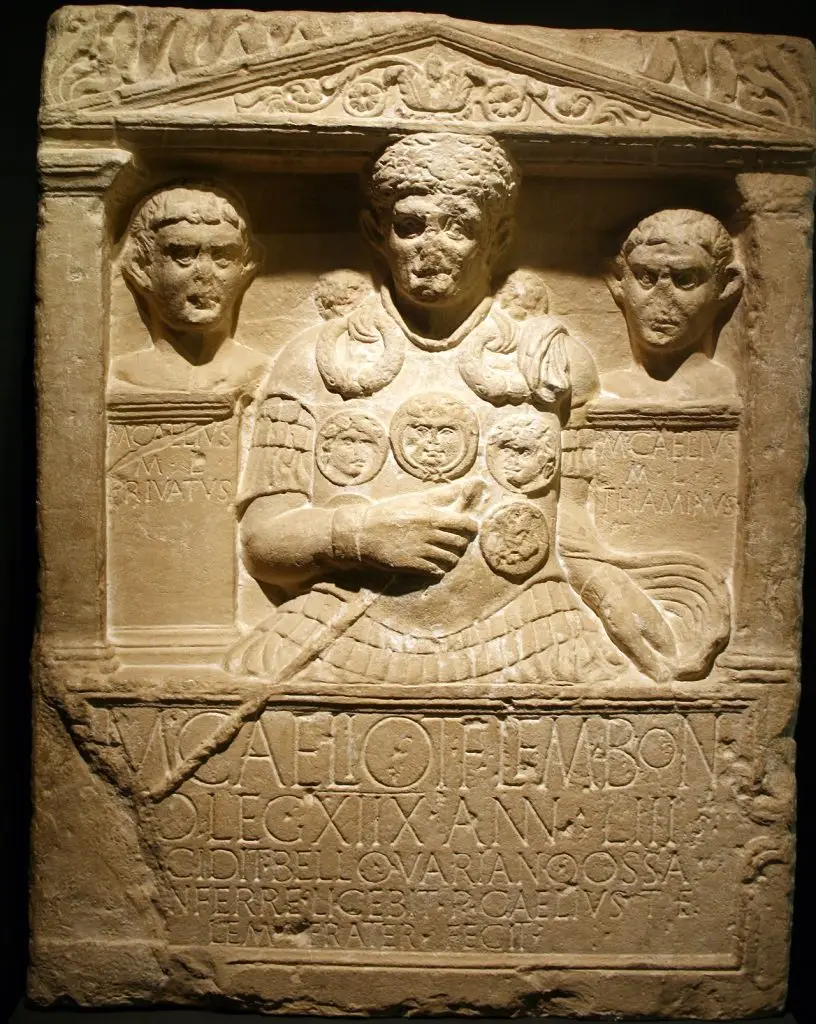
Cenotaph of Marcus Caelius, 1st centurion of XVIII, who “fell in the war of Varus” (‘bello Variano’) (Wiki Image).
Ten notable quotes:
Here are ten famous quotes related to the Battle of Teutoburg Forest (9 AD), one of the most catastrophic defeats for the Roman Empire at the hands of Germanic tribes led by Arminius:
- Emperor Augustus: “Quintilius Varus, give me back my legions!”
– Augustus’s anguished cry upon hearing of the disaster expresses the depth of the loss. - Tacitus: “The soldiers’ bones were still lying unburied in the forest after all these years, scattered where they had fallen.”
– Roman historian Tacitus on the battlefield remains years later. - Velleius Paterculus: “Never was there a disaster more bloody, more shocking than this.”
– Roman historian Velleius describes the sheer magnitude of the Roman defeat. - Arminius: “It is not by power alone that the Romans are overcome but by the subtlety of strategy.”
– Arminius reflecting on the clever tactics he used to defeat the Romans. - Cassius Dio: “All were slaughtered… in the forest, in the swamps, in the ravines; no one survived.”
– Cassius Dio emphasizes the total destruction of the Roman forces. - Tacitus: “He [Arminius] was the liberator of Germany.”
– Tacitus credits Arminius with the unification and liberation of Germanic tribes against Roman domination. - Publius Quinctilius Varus (alleged last words): “We are undone.”
– Varus, the Roman general in command, realized the gravity of the defeat before his death. - Tacitus: “That day changed the destinies of empires.”
– Tacitus summarizes the long-term impact of the battle on both Rome and Germany. - Suetonius: “Three whole legions were destroyed; hardly a man escaped to bring the news.”
– Suetonius outlining the catastrophic losses suffered by Rome. - Arminius: “Freedom is the greatest reward for the fight.”
– Arminius speaking about the motivation of the Germanic tribes in their revolt against Roman rule.
Casualties
| Force | Commander | Men (estimated) | Killed | Wounded | Prisoners | Total Casualties (estimated) |
| Roman Legions | Publius Quinctilius Varus | 17,000 – 20,000 | 15,000 – 20,000 | Few | Several thousand | 15,000 – 20,000+ |
| Germanic Tribes | Arminius | 10,000 – 20,000 | Unknown | Unknown | Few | Unknown |
The Battle of Teutoburg Forest 9 AD: When Trees Start …
Roman Empire Vs Germanic Tribes: Battle of Teutoburg forest …
Teutoburg Forest 9 AD – Roman-Germanic Wars …
(YouTube video)
The Battle of Teutoburg Forest, fought in 9 AD, marks one of the most significant defeats in Roman military history. It resulted in annihilating three Roman legions under Publius Quinctilius Varus’s command. This battle not only halted the expansion of the Roman Empire into Germany but also had profound repercussions for Rome’s political and military strategies. The events surrounding this conflict reflect the complexities of Roman-Germanic relations and the fierce resistance of the Germanic tribes against Roman dominance.
Historical Context
By the late 1st century BC, Rome had significantly expanded its territory and influence across Europe. Under Augustus’s leadership, the Roman Empire sought to consolidate its power and expand into Germany. Various tribes populated the region, collectively referred to as the Germanic peoples, who were known for their fierce warrior culture and resistance to foreign domination. Varus, appointed governor of the newly annexed provinces, aimed to bring Roman civilization to the tribes, but this approach was met with resentment and hostility.
The Setup for Conflict
In the years leading up to the battle, Varus sought to impose Roman law and customs on the Germanic tribes, which fueled tensions. His administration included heavy taxation and the introduction of a Roman military presence in the region. The Germanic chieftain Arminius, a former auxiliary officer in the Roman army who had gained Varus’s trust, played a crucial role in the unfolding conflict. Disguised as a loyal ally, Arminius began to unify the Germanic tribes, including the Cherusci, Chatti, and others, against the Roman threat.
The Betrayal
Arminius’s plan culminated in the summer of 9 AD when he deceived Varus into believing that a minor uprising was occurring in the region. This led Varus to march his legions—comprising the Legions XVII, XVIII, and XIX—deep into the Teutoburg Forest. Confident in his superior military strength, Varus fell into Arminius’s trap. The Germanic tribes had strategically planned an ambush, exploiting their intimate knowledge of the dense forest terrain unfamiliar to the Roman soldiers.
The Ambush
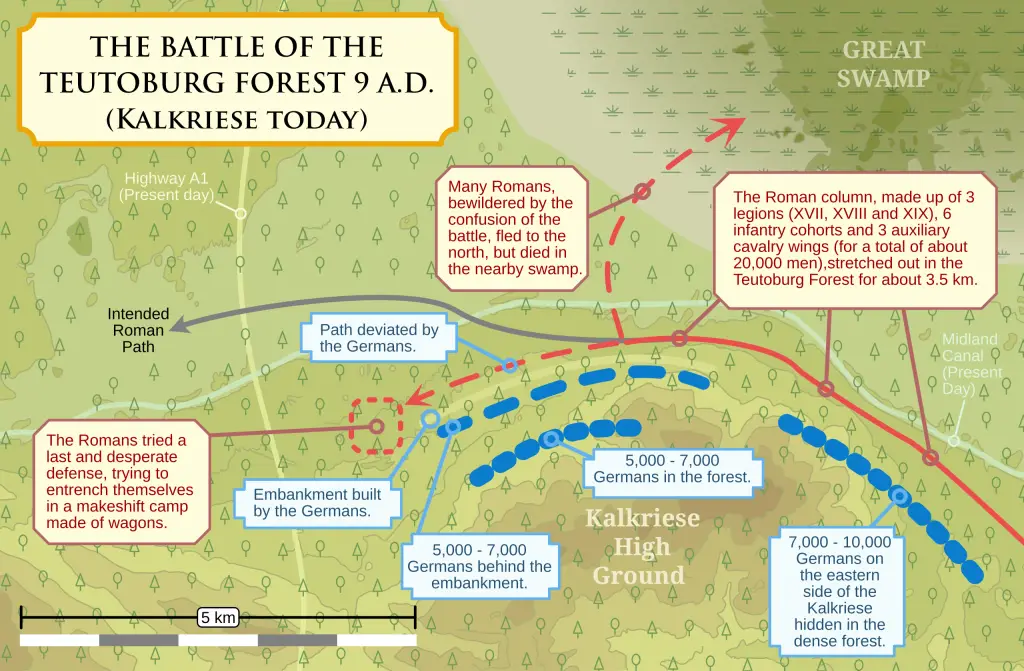
Map showing the defeat of Publius Quinctilius Varus at Kalkriese (Wiki Image).
As the Roman legions advanced through the Teutoburg Forest, Arminius and his confederation of tribes unexpectedly attacked them from all sides. The dense underbrush and narrow pathways hindered the Roman formations’ maneuverability. The Germanic warriors used hit-and-run tactics, launching surprise attacks and retreating into the trees. The Romans, accustomed to open-field combat, found themselves disoriented and vulnerable in the unfamiliar environment.
The Decimation of the Legions
The battle raged for several days, with the Roman legions suffering devastating losses. Realizing the dire situation, Varus attempted to retreat, but the Germanic forces pursued relentlessly. The Romans, who had initially numbered around 20,000, were systematically picked off, with only a fraction managing to escape. The culmination of this catastrophic defeat resulted in the near-total destruction of Varus’s legions, marking a turning point in Rome’s ambitions in Germany.
Aftermath and Consequences
The defeat at Teutoburg Forest had profound implications for the Roman Empire. News of the disaster spread rapidly, causing panic in Rome and leading to a reassessment of imperial policies regarding Germany. After losing, Augustus lamented, “Quintilius Varus, give me back my legions!” The Roman Empire effectively abandoned its ambitions to expand further into Germany, establishing a more defensive stance along the Rhine River, which would become the new frontier.
The Legacy of the Battle
Teutoburg Forest became a symbol of Germanic resistance and national pride. The battle significantly shaped the identity of the Germanic tribes, fostering a sense of unity against external threats. For centuries, the event was memorialized in folklore, literature, and later historical accounts, such as those by the Roman historian Tacitus. The battle’s legacy inspired future generations in their struggles against foreign domination.
Conclusion
The Battle of Teutoburg Forest represents a critical juncture in the history of Rome and Germany, highlighting the complexities of imperial expansion and the fierce determination of indigenous peoples to resist colonization. The defeat had lasting ramifications for the Roman Empire, influencing military strategy and policy in the region for years. The battle remains a testament to the resilience of the Germanic tribes and their ability to unite against a formidable adversary, ultimately altering the course of European history.
Battle of Red Cliffs (208 AD, China)

Engravings on a cliff-side near a widely accepted candidate site for the battlefield, in the vicinity of Chibi, Hubei. The engravings are at least 1000 years old and include the Chinese characters 赤壁 (‘red cliffs’) written from right to left (Wiki Image).
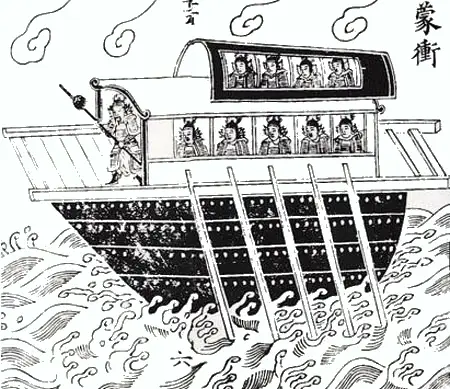
A depiction of a mengchong, an assault warship used in the battle that was covered in leather and designed to break enemy lines – the Wujing Zongyao, c. 1040 (Wiki Image).
Ten notable quotes:
Here are ten famous quotes related to the Battle of Red Cliffs (208 AD), one of the most significant battles in Chinese history during the late Han Dynasty, where the forces of Sun Quan and Liu Bei defeated Cao Cao’s massive army:
- Cao Cao: “I have a million soldiers, and they have nothing but rivers and mountains to protect them. How could they possibly resist me?” – Cao Cao’s overconfidence before the battle, believing his superior numbers would guarantee victory.
- Zhuge Liang: “The strength of the south lies in our waterways. We will use fire to break Cao Cao’s fleet and his will.” – Zhuge Liang, Liu Bei’s brilliant strategist, explaining his plan to take advantage of the environment.
- Sun Quan: “Even if the mountains and rivers burn, we will defend our land.” Sun Quan, the leader of the southern forces, expressed his determination to resist Cao Cao’s invasion.
- Zhou Yu: “A true general must understand both heaven’s timing and the enemy’s weaknesses.” – Zhou Yu, Sun Quan’s commander, reflecting on the importance of strategy and timing in warfare.
- Cao Cao: “The wind, the fire, everything is against me. Heaven has forsaken me!” – Cao Cao’s realization during the battle, as his fleet is set ablaze by fire ships.
- Zhuge Liang: “Cao Cao’s army is like a dragon that has crossed a river, majestic but out of its element.” – Zhuge Liang metaphorically describes Cao Cao’s army as strong but vulnerable in unfamiliar terrain.
- Sima Yi: “Victory is not always in the hands of the greater force.” – Sima Yi, Cao Cao’s advisor, acknowledging that numbers alone do not guarantee victory in warfare.
- Zhou Yu: “Strike when the wind is right, and the flames will devour his ships.” – Zhou Yu’s crucial command to launch the fire attack timed perfectly with the eastern wind.
- Sun Quan: “The unity of our people and the might of our land will never be broken by force.” – Sun Quan rallied his troops to defend the southern states and maintain their independence.
- Zhuge Liang: “This is not the end of our fight; it is merely the beginning of the great divide.” – Zhuge Liang predicted that the victory at Red Cliffs would mark the beginning of the division of China into three kingdoms.
Casualties
| Force | Commander(s) | Ships (estimated) | Men (estimated) | Killed/Wounded | Prisoners | Ships Lost/Captured |
| Cao Cao’s Forces | Cao Cao | 800+ | 220,000 – 800,000 | Heavy | Many | Majority |
| Sun Quan’s Forces | Zhou Yu, Lu Su | 300+ | 50,000 | Moderate | Some | Few |
| Liu Bei’s Forces | Liu Bei, Zhuge Liang | 100+ | 20,000 | Light | Some | Few |
Export to Sheets
The Battle of Red Cliffs |AD 208|(Battle of Chibi) Total War …
The Battle of Red Cliffs
Red Cliffs and Jiangling 208 – THREE KINGDOMS …
(YouTube video)
The Battle of Red Cliffs, fought in the winter of 208 AD, is a pivotal conflict in ancient Chinese history, marking a crucial turning point during the late Eastern Han dynasty. This battle was primarily between the forces of the warlord Cao Cao and the allied forces of Sun Quan and Liu Bei. The confrontation not only showcased strategic military maneuvers but also set the stage for the eventual division of China into the Three Kingdoms, influencing the political landscape for centuries.
Historical Context
In the late 2nd century AD, the Han dynasty was in decline, plagued by corruption and power struggles. Amid this chaos, regional warlords emerged, vying for control over China. Cao Cao, a powerful warlord and the de facto ruler of northern China sought to expand his influence by conquering southern territories. His ambition to unite the country under his rule set the stage for the conflict at Red Cliffs, as the southern warlords, Sun Quan and Liu Bei, allied to resist his advances.
The Lead-Up to Battle
By 208 AD, Cao Cao had successfully conquered the northern territories and marched south with an army of over 200,000. His forces were well-equipped and organized, posing a significant threat to the southern warlords. In response, Sun Quan and Liu Bei, recognizing the danger posed by Cao Cao, allied together despite their previous conflicts. The two leaders strategically positioned their forces along the Yangtze River, specifically near the Red Cliffs, where they planned to use the terrain to their advantage.
Strategic Advantages
The geography of the battlefield played a crucial role in the outcome of the Battle of Red Cliffs. The Yangtze River was a natural barrier against Cao Cao’s larger army. Furthermore, Sun Quan’s forces, predominantly composed of skilled archers and naval troops, were better suited for combat on the water. Liu Bei’s men, although fewer in number, were motivated to defend their homeland. This combination of terrain and morale would prove critical in the upcoming conflict.
The Battle Begins
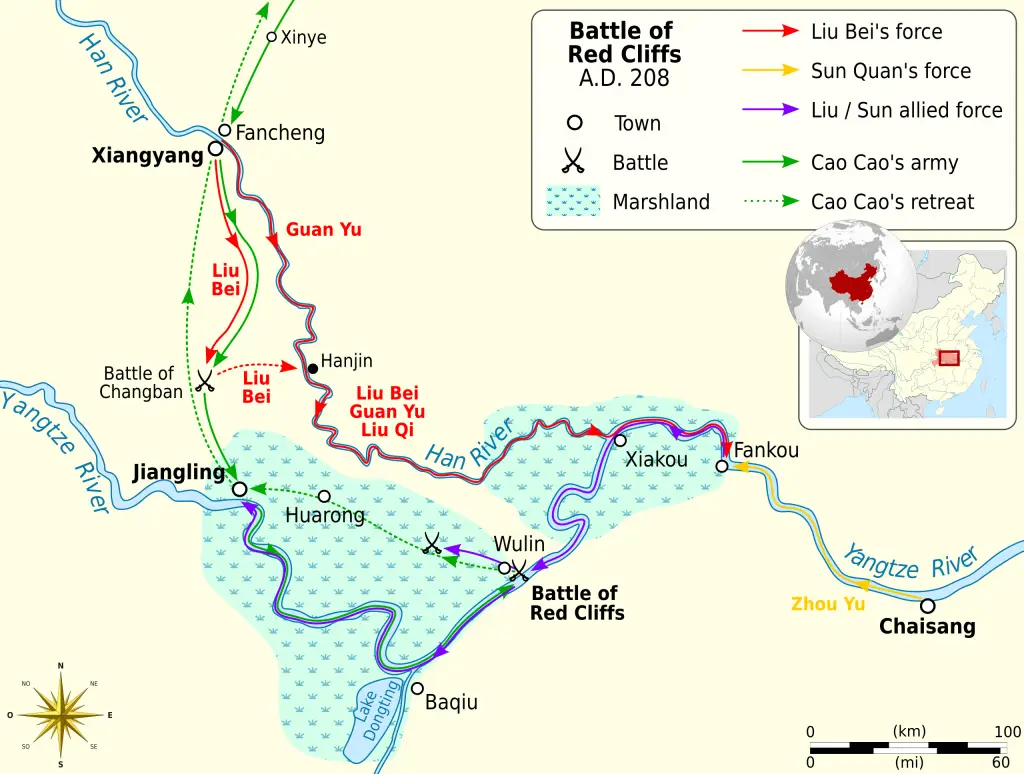
Battle of Red Cliffs and Cao Cao’s retreat (Wiki Image).
The battle commenced with skirmishes along the river as both sides sought to gain the upper hand. Cao Cao attempted to exploit his numerical advantage by launching frontal assaults. However, the southern forces skillfully utilized their river knowledge and naval capabilities, effectively repelling the attacks. The tides turned when Zhou Yu, a prominent general serving under Sun Quan, devised a plan to use fire as a weapon against Cao Cao’s fleet.
The Inferno Strategy
Zhou Yu’s plan involved launching a surprise fire attack against Cao Cao’s ships, which were tightly clustered together for logistical efficiency. Under the cover of night, the southern forces set fire to a fleet of ships loaded with dry timber and flammable materials. The flames quickly spread, engulfing many of Cao Cao’s vessels and causing chaos among his troops. This tactic decimated Cao Cao’s naval strength and demoralized his army, contributing to a rapid decline in their fighting spirit.
Aftermath of the Battle
The defeat at the Battle of Red Cliffs was catastrophic for Cao Cao. With his forces significantly weakened and morale shattered, he retreated to northern China. Sun Quan and Liu Bei’s victory solidified their alliance and began a new power dynamic in China. The battle became a legendary tale of strategy and heroism, encapsulated in the historical novel Romance of the Three Kingdoms, dramatizing the events and personalities involved.
Political Ramifications
In the aftermath of the battle, the power dynamics in China shifted dramatically. Sun Quan emerged as the ruler of the southern territories, establishing the Eastern Wu state, while Liu Bei gained legitimacy and support, ultimately founding the Shu Han state. The battle set the stage for the Three Kingdoms Period, a time characterized by continuous warfare, shifting alliances, and the rise of legendary figures such as Zhuge Liang, Sun Quan, and Liu Bei.
Conclusion
The Battle of Red Cliffs is a significant event in Chinese history for its immediate military outcomes and its long-lasting impact on the political landscape. The alliance between Sun Quan and Liu Bei, forged in the crucible of battle, would shape the trajectory of the Three Kingdoms era. The strategies employed, particularly the innovative use of fire, have been studied and admired for their ingenuity. Ultimately, the Battle of Red Cliffs remains a testament to the complexities of war and the enduring struggle for power in ancient China.
“Kamikaze” or Divine Wind (1274 & 1281, Japan)
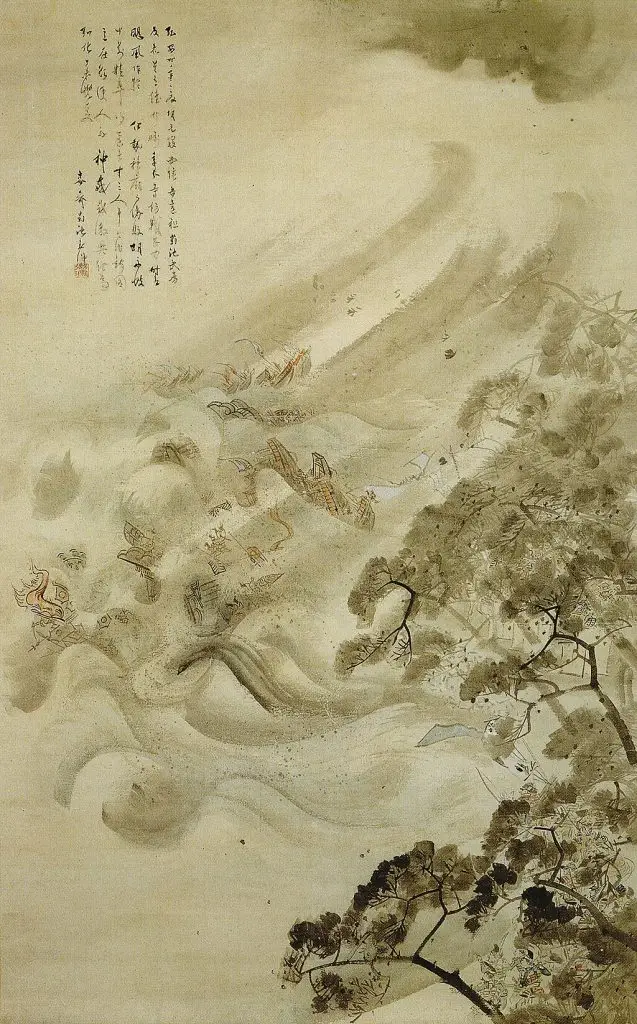
The Mongol fleet was destroyed in a typhoon, ink and water on paper, by Kikuchi Yōsai in 1847 (Wiki Image).
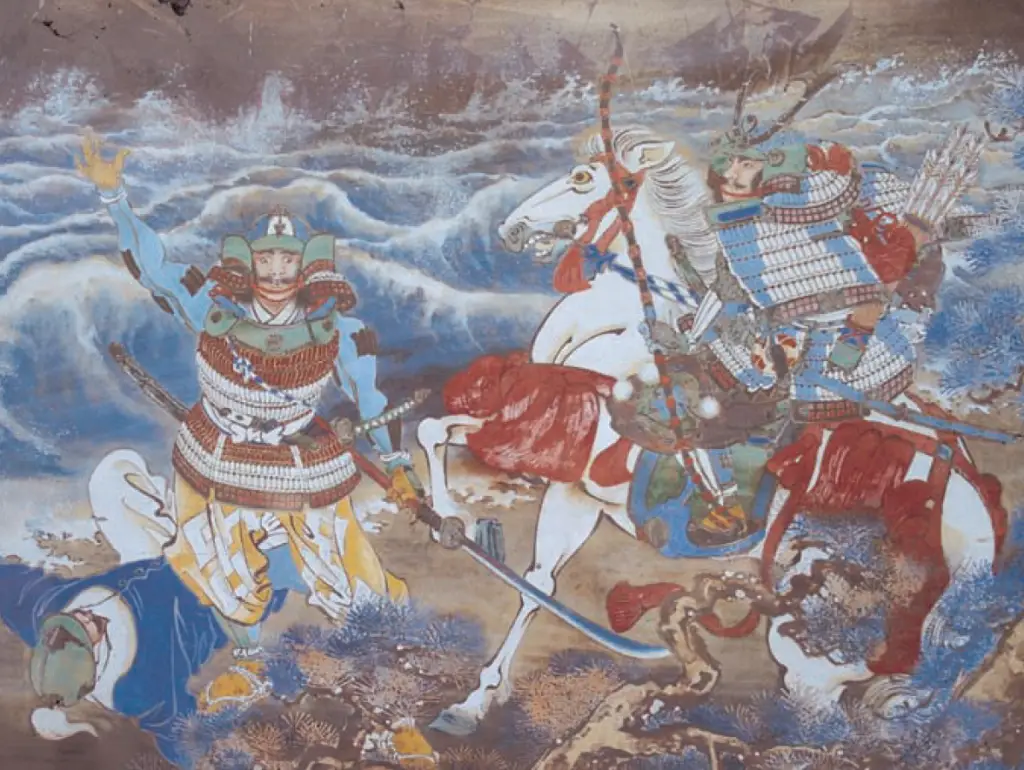
Two Samurai with a dead Mongol at their feet. The one on the right is possibly Sō Sukekuni, the defending commander at Tsushima—votive image (ema) at the Komodahama Shrine at Sasuura on Tsushima (Wiki Image).
Ten notable quotes:
Here are ten quotes related to the “Kamikaze” or “Divine Wind” during the Mongol invasions of Japan in 1274 and 1281:
- “The wrath of the gods swept through the invaders, scattering their mighty fleet like leaves before a storm.” – Traditional Japanese proverb.
- “The divine wind came to our rescue when our swords could not.” – Anonymous samurai warrior reflecting on the Mongol invasions.
- “The winds that saved us were the very breath of the kami, sent from the heavens to protect our sacred land.” – Japanese priest in the storm’s aftermath.
- “The destruction of our ships was not by the hand of men, but by the fury of nature herself.” – Mongol survivor of the failed invasions.
- “The gods have intervened on behalf of their people, ensuring that the land of the rising sun remains untouched by foreign hands.” – Contemporary Japanese historian.
- “In the face of overwhelming force, we prayed for deliverance, and the sea answered our call.” – Samurai account from the invasion of 1274.
- “Our horses would not charge into the heart of the storm; it was as though they could sense the coming tempest.” – Mongol officer before the storm of 1281.
- “The heavens themselves guarded Japan, sending not one, but two tempests to destroy the enemy’s ambitions.” – Scholar describing the two typhoons.
- “For a nation without walls, it was the walls of the storm that protected us.” – Samurai leader after the 1281 invasion attempt.
- “It was not skill or valor that defeated the Mongols, but the will of the wind and the favor of the gods.” – Later Japanese chronicler reflecting on the invasions.
Casualties
| Force | Commander | Ships (Start) | Men (estimated) | Killed/Drowned | Prisoners | Ships Lost |
| 1st Mongol Invasion (1274) | Kublai Khan | 500-900 | 30,000-40,000 | 13,000+ | Unknown | Most |
| 2nd Mongol Invasion (1281) | Kublai Khan | 4,400 | 140,000 | 70,000+ | Unknown | Most |
| Japanese Forces (both invasions) | Hōjō Tokimune | Varies | 40,000 (1281) | Relatively few | Some | Few |
Mongol Invasions of Japan 1274 and 1281 – Full History
Mongol vs Japan: How Khan Army Was Defeated in Japan …
Mongol Invasion of Japan (1281)
(YouTube video)
The term “Kamikaze,” or “Divine Wind,” refers to a series of typhoons that played a pivotal role in two attempted invasions of Japan by Mongol forces in the late 13th century, specifically in 1274 and 1281. These extraordinary storms, which devastated the invading fleets, have become emblematic of divine protection in Japanese culture and a symbol of resistance against overwhelming odds. The events surrounding the kamikaze have left a lasting legacy in Japanese history and mythology.
Historical Context
In the 13th century, the Mongol Empire, under the leadership of Kublai Khan, sought to expand its influence and power across East Asia. Following successful conquests in China and Korea, Kublai Khan turned his attention to Japan, viewing it as a strategic territory for further expansion. In 1274, the Mongol Empire launched its first invasion of Japan, utilizing a fleet composed of ships from various regions, including Korea and China. This initial invasion aimed to subjugate Japan and integrate it into the Mongol Empire.
The First Invasion (1274)
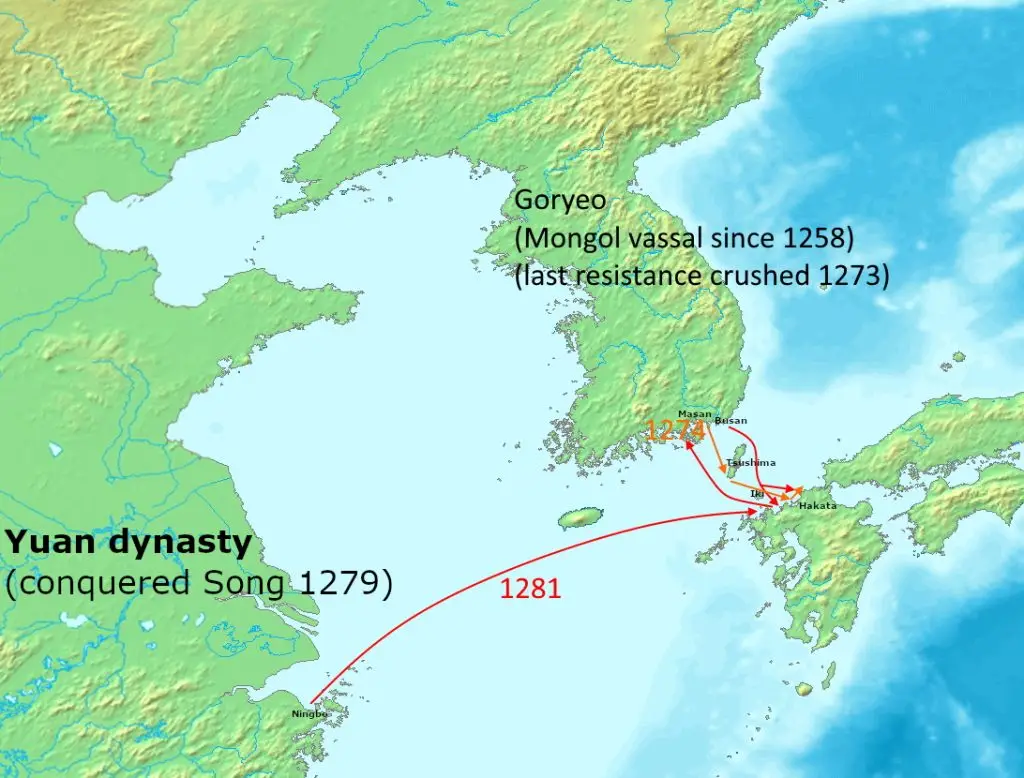
Mongol invasions of Japan in 1274 and 1281 (Wiki Image).
The first invasion of Japan began in November 1274 when approximately 900 ships carrying around 15,000 soldiers arrived at the island of Tsushima. The Japanese defenders, significantly outnumbered, were initially overwhelmed. However, the samurai forces, known for their fighting prowess and determination, rallied and mounted a counterattack against the invaders. After fierce battles, the Mongols could not secure a decisive victory and retreated. Shortly after their withdrawal, a powerful typhoon struck the region, causing catastrophic damage to the Mongol fleet and drowning thousands of soldiers.
The Second Invasion (1281)
Undeterred by the failure of the first invasion, Kublai Khan ordered a second, larger invasion in 1281. This time, the Mongols assembled a massive armada of 4,000 ships and as many as 140,000 troops. This invasion involved two main fleets, one from Korea and another from southern China. As the Mongol forces approached Japan, they again faced resistance from the samurai, who were better prepared following the lessons learned from the previous invasion.
The Divine Wind Strikes Again
As the Mongol fleet gathered off the coast of Kamakura, the Japanese defenders prepared for battle. The two fleets launched an attack on August 15, 1281, but another formidable typhoon soon thwarted their efforts. This storm, which would later be dubbed the second kamikaze, wreaked havoc on the invading fleet, capsizing ships and drowning soldiers. It is estimated that around 100,000 Mongol troops perished in the storm, further ensuring Japan’s safety from foreign invasion.
Cultural Significance
The kamikaze concept transcends mere historical events; it has entered the realm of Japanese folklore and spirituality. The typhoons were interpreted as manifestations of divine intervention, protecting Japan from foreign invasion. As a result, the kamikaze became a symbol of national identity and resilience against overwhelming odds. The samurai’s bravery and the storms’ unexpected role in defending Japan are celebrated in literature, art, and religious practices, emphasizing that Japan was under the gods’ protection.
Political Ramifications
The failure of the Mongol invasions had significant political implications for Japan. Following the invasions, the Kamakura shogunate, which ruled Japan then, solidified its power and authority. The victories over the Mongols fostered a sense of national pride and unity among the Japanese. The shogunate used the successful defense against foreign invaders to strengthen its position and to rally support among the samurai class.
Lasting Legacy
The legacy of the kamikaze is evident in various aspects of Japanese culture and history. The events of 1274 and 1281 are commemorated in numerous monuments, festivals, and literary works. The term “kamikaze” itself resurfaced during World War II, when it was used to describe the suicide pilots of the Imperial Japanese Navy, drawing on the historical significance of the divine winds that had once protected Japan.
Conclusion
In summary, the “Kamikaze” of 1274 and 1281 represents a unique intersection of natural forces and human history, illustrating the impact of environmental conditions on military conflicts. These events thwarted foreign invasions and became integral to Japan’s national identity and cultural heritage. The kamikaze stands as a testament to the resilience of the Japanese spirit and the belief in divine protection, shaping the narrative of Japan’s history for centuries to come.
Battle of Agincourt (1415, France)
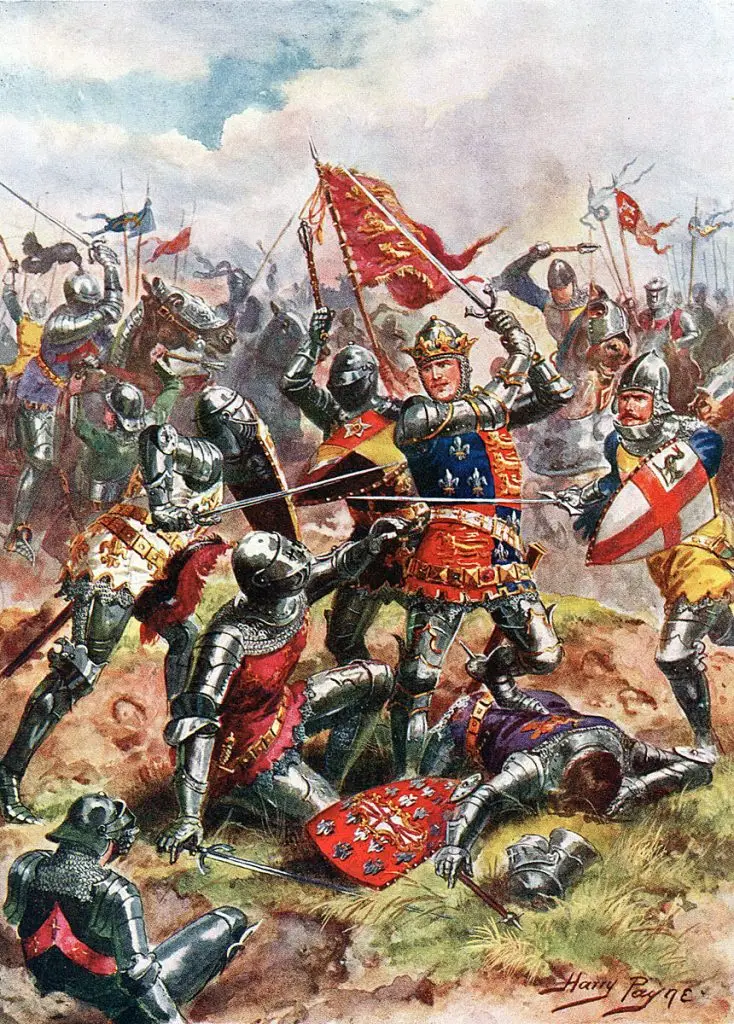
1915 depiction of Henry V at the Battle of Agincourt: The King wears on this surcoat the Royal Arms of England, quartered with the Fleur de Lys of France as a symbol of his claim to the throne of France (Wiki Image).
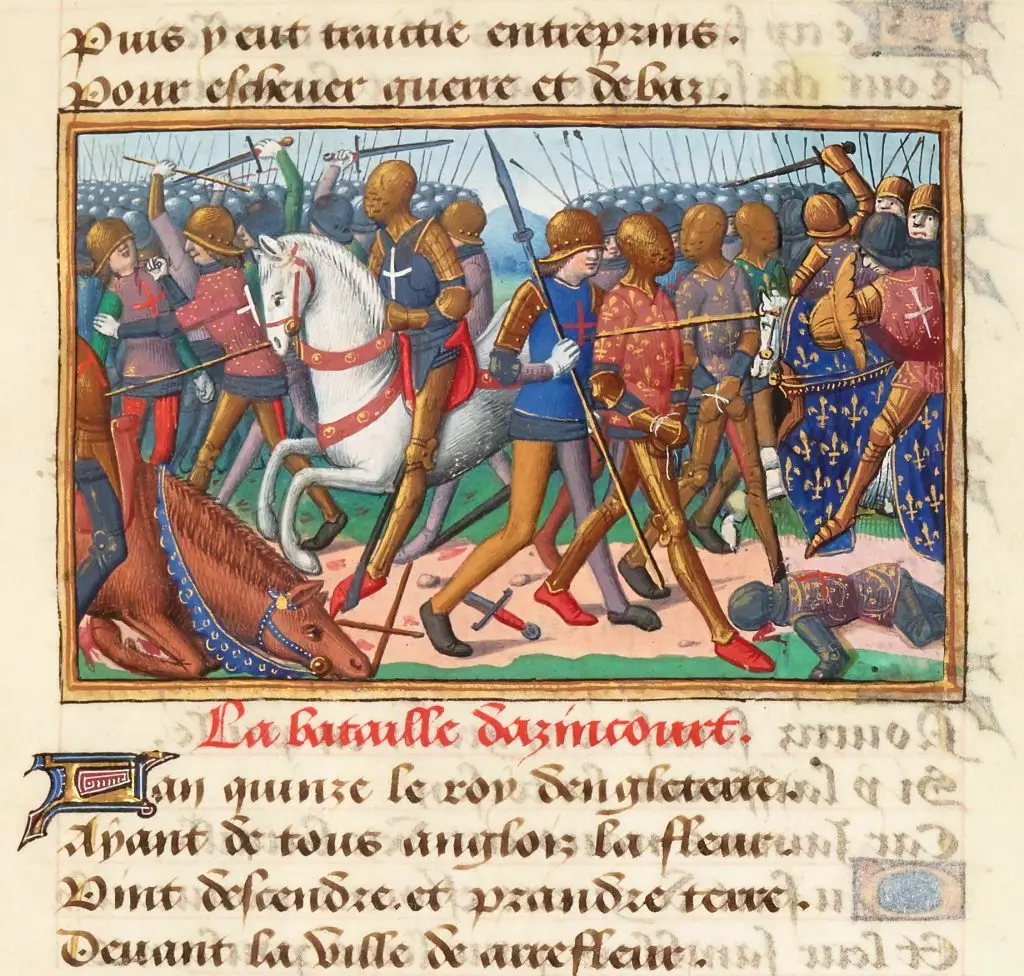
Miniature from Vigiles du roi Charles VII. The battle of Azincourt 1415 (Wiki Image).
Ten notable quotes:
Here are ten notable quotes related to the Battle of Agincourt (1415, France):
- “We few, we happy few, we band of brothers; For he to-day that sheds his blood with me shall be my brother.”
– William Shakespeare, Henry V, Act 4, Scene 3. - “All things are ready, if our minds be so.”
– William Shakespeare, Henry V, highlighting King Henry’s confidence before the battle. - “I would not lose so great an honor as one man more, methinks, would share from me, for the best hope I have.”
– William Shakespeare, Henry V, showing Henry’s defiance in the face of overwhelming odds. - “O God, Thy arm was here.”
– William Shakespeare, Henry V, Act 4, Scene 8, after the victory. - “Then call we this the field of Agincourt, fought on the day of Crispin Crispianus.”
– William Shakespeare, Henry V, marking the victory date. - “The English are so few that if we take them alive, there will be enough to lead them tied in strings.”
– French noble before the battle, underestimating the English. - “On that day, the English did not want prisoners; they slew all who fell into their hands.”
– Jean Froissart, French chronicler, on the brutality of the battle. - “Never was a victory so complete, or gained with so little loss, and yet so decisive in its results.”
– Sir John Fortescue, reflecting on Agincourt’s importance. - “Henry’s men fought as though each of them were worth three Frenchmen.”
– Contemporary chronicler on the incredible performance of the English troops. - “The flower of French nobility perished on the field of Agincourt.”
– Philippe de Mézières, describing the catastrophic loss for the French aristocracy.
Casualties
| Force | Commander | Men (estimated) | Killed | Wounded | Prisoners | Total Casualties (estimated) |
| English Army | King Henry V | 6,000 – 9,000 | 100-400 | ~1,000 | Few | 1,100 – 1,400 |
| French Army | Charles d’Albret | 12,000 – 36,000 | 6,000 – 10,000 | Unknown | ~1,500 | 7,500 – 11,500+ |
Export to Sheets
Battle of Agincourt, 1415 (ALL PARTS) ⚔️ England vs France …
The Battle of Agincourt Brought to Life in Stunning Animation …
Battle of Agincourt 1415 – Hundred Years’ War DOCUMENTARY
(YouTube video)
The Battle of Agincourt, fought on October 25, 1415, during the Hundred Years’ War, is one of English history’s most celebrated military engagements. This conflict saw the English army, led by King Henry V, achieve a stunning victory against the much larger French forces. The battle is notable for its tactical brilliance and enduring legacy in English culture, literature, and national identity.
Context and Prelude to the Battle
By the early 15th century, the Hundred Years’ War had raged for several decades, marked by conflicts between England and France over territorial claims and the right to the French crown. In 1415, King Henry V sought to reclaim English territories in France and assert his claim to the throne. Following a successful siege at Harfleur, Henry’s forces were weakened by disease and fatigue, prompting a retreat toward Calais. However, the French, eager to capitalize on their numerical superiority, gathered an army to intercept the English.
Forces and Preparations
The English army at Agincourt was significantly outnumbered, with estimates suggesting that Henry had around 6,000 to 9,000 men, while the French army could have numbered 20,000 to 40,000 soldiers. Despite these odds, the English forces were primarily composed of skilled longbowmen, whose ranged weaponry played a crucial role in the upcoming battle. The terrain at Agincourt was narrow and muddy, favoring the English strategy of using their longbows to devastating effect. Henry V prepared his men with a mix of discipline and morale, invoking a sense of unity and purpose.
The Battle Begins
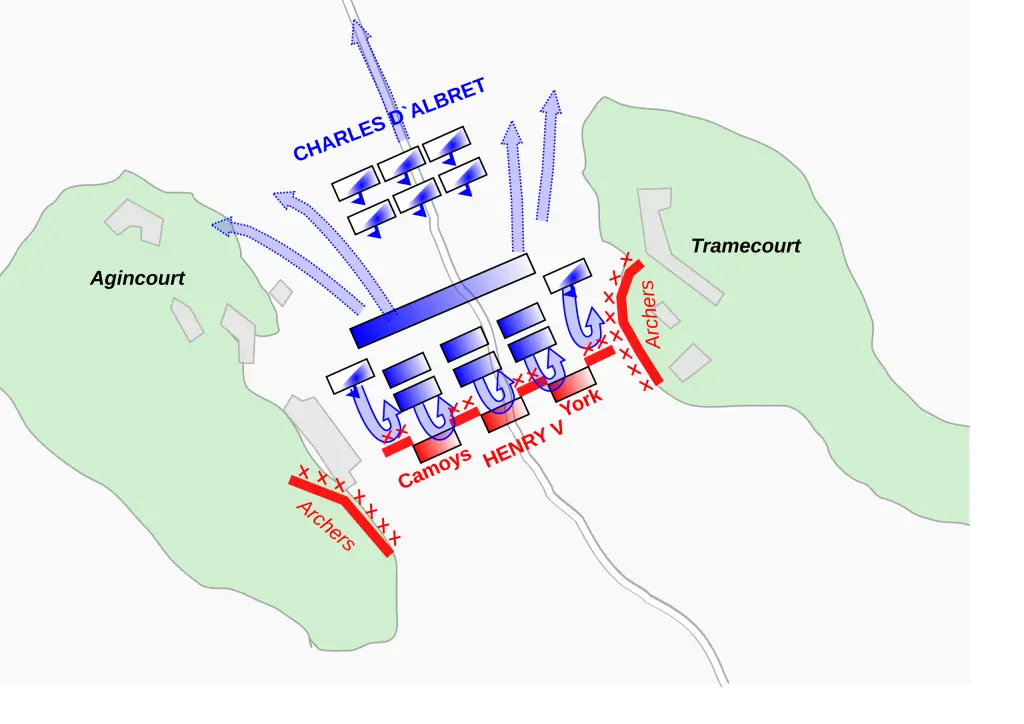
The Battle of Agincourt (Wiki Image).
On the morning of October 25, the battle commenced in the muddy fields of Agincourt. The French forces advanced in heavily armored formations, relying on their cavalry and infantry to crush the English lines. However, the English longbowmen, positioned strategically along the flanks, unleashed a hail of arrows upon the advancing French troops. The muddy terrain hampered the French advance, causing their heavy cavalry to become bogged down, while the agile English soldiers remained more mobile and effective.
Tactical Brilliance of the English
Henry V’s tactical genius became evident as he combined terrain advantage and innovative battlefield strategies. The English longbowmen, who could shoot up to 10 arrows per minute, decimated the French ranks before they could close in for hand-to-hand combat. As the French soldiers struggled through the mud, many fell to the ground, creating a chaotic mass that the English forces exploited. The disciplined English troops, bolstered by their archers, could repel the French charges and maintain their defensive positions.
Turning Point of the Battle
The French suffered catastrophic losses as the battle progressed, and morale plummeted. The turning point came when the French nobility, desperate to turn the tide, charged toward the English lines but faced fierce resistance. Many French knights, encumbered by their heavy armor, fell victim to the longbows or were trapped in the mud. The disarray within the French ranks led to further chaos, and the English seized the opportunity to launch counterattacks, decisively breaking the French advance.
Aftermath of the Battle
The aftermath of Agincourt was devastating for the French, with estimates of casualties ranging from 6,000 to 10,000. The English, on the other hand, suffered relatively few losses, with around 400 to 1,000 men dead. The battle solidified Henry V’s reputation as a military leader and instilled a sense of national pride among the English. The victory at Agincourt boosted English morale and provided a significant advantage in the ongoing conflict, allowing Henry to strengthen his position in France.
Legacy and Cultural Impact
The Battle of Agincourt has left an indelible mark on English history and culture. It has been immortalized in literature, notably in William Shakespeare’s play, Henry V, where King Henry’s inspiring speeches and the valor of his soldiers resonate through time. The battle symbolizes the triumph of determination and strategy over overwhelming odds and has become a rallying point for English nationalism. Agincourt is often remembered not just as a military victory but as a defining moment that shaped the course of the Hundred Years’ War and the future of England.
Conclusion
In conclusion, the Battle of Agincourt is a remarkable example of military strategy and leadership. The clash of arms on that October day in 1415 exemplified the complexities of warfare during the Hundred Years’ War and highlighted the significance of morale, tactics, and adaptability in battle. Agincourt remains a testament to the resilience of the English forces and continues to inspire generations through its stories of courage, sacrifice, and national identity.
Battle of Tenochtitlán (1521, Mexico)
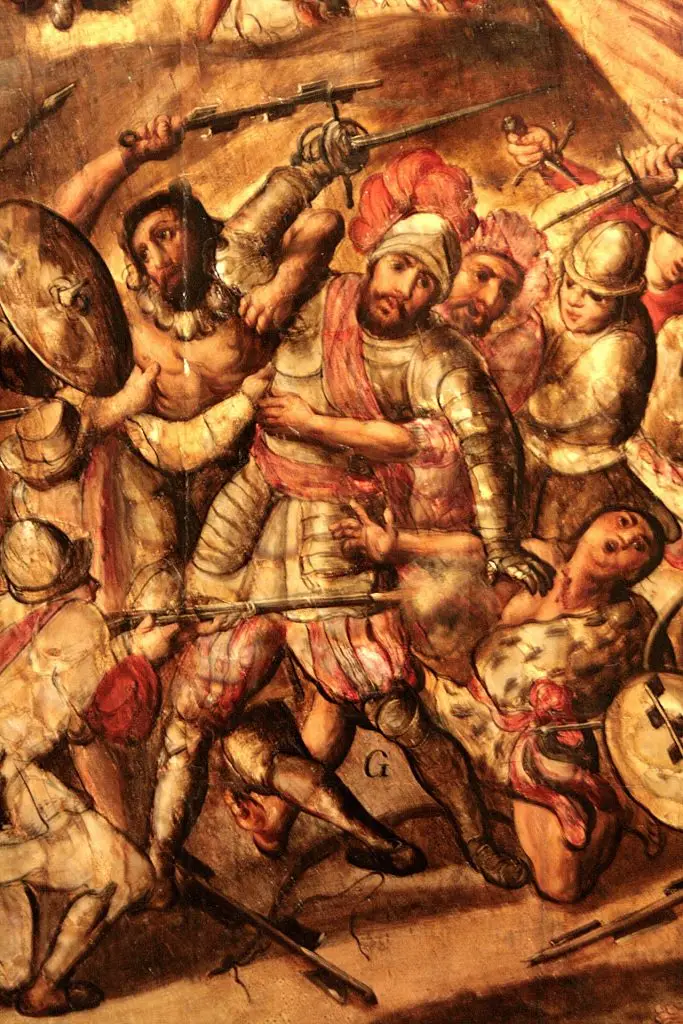
During the siege of Tenochtitlan, Hernan Cortés narrowly escaped capture by Aztec warriors—detail of a painting at the Museo de América, Madrid, Spain (Wiki Image).
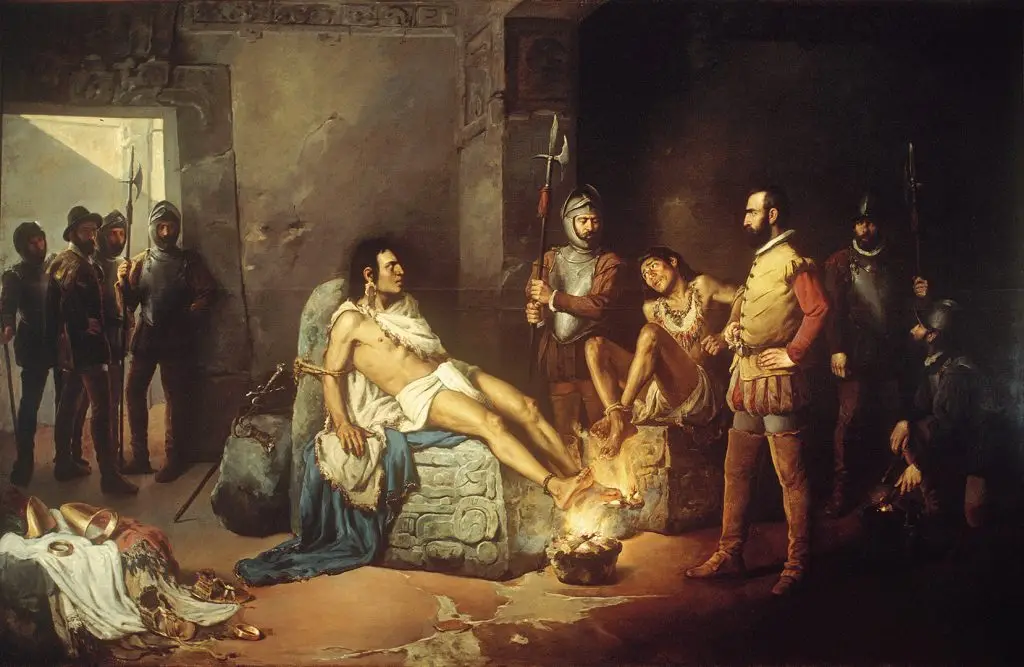
“The Torture of Cuauhtémoc,” a 19th-century painting by Leandro Izaguirre (Wiki Image).
Ten notable quotes:
Here are ten quotes related to the Battle of Tenochtitlán (1521):
- Bernal Díaz del Castillo, a Spanish soldier and chronicler:
“We could not walk without treading on the bodies and heads of dead Indians; I have never seen such a thing before nor heard it spoken of.” - Hernán Cortés, leader of the Spanish conquest:
“We have arrived at the very heart of the enemy’s power, and though it is defended with fury, we shall prevail with God’s grace and our men’s determination.” - Francisco López de Gómara, Spanish historian:
“Tenochtitlán was the greatest city in the world. Its fall was an event unparalleled in human history.” - Aztec account from the Florentine Codex:
“Broken spears lie in the roads; we have torn our hair in our grief. The houses are roofless now, and their walls are red with blood.” - Moctezuma II, before his capture:
“I am no longer the master of myself, nor of my house. I shall never again enjoy the throne of my ancestors.” - Diego Durán, Dominican friar and chronicler:
“The Spaniards came like a plague; they showed no mercy and brought the empire to its knees.” - Cuitláhuac, Aztec ruler, rallying his warriors:
“Brothers, let us not succumb to despair. Let the fury of Huitzilopochtli guide our arms, for we fight not for ourselves but for the gods and the land of our ancestors.” - Cortés, on the Aztec resistance:
“They fought with such valor and resolution, for they preferred to die than see themselves taken alive.” - Ixtlilxochitl, an Indigenous nobleman allied with the Spanish:
“The hour of our ancient enemies has come, and with the help of these foreign lords, we shall reclaim the power that was once ours.” - Father Sahagún, a Franciscan missionary:
“God, in His divine wisdom, chose to cast down the false gods of this land and deliver it into the hands of true believers, though the cost in human life was heavy.”
Casualties
| Forces | Number of Combatants | Casualties (Killed/Wounded) | Prisoners | Ships Involved | Ships Lost |
| Spanish & Tlaxcalan Allies | ~1,500 Spaniards & ~100,000 Tlaxcalan warriors | Spaniards: ~100-200 killed
Tlaxcalans: Thousands killed |
Prisoners: Minimal (Aztec nobility) | 13 brigantines (constructed by the Spanish) | 0 ships lost (brigantines remained intact) |
| Aztec Empire | ~300,000 soldiers & civilians | Casualties: Tens of thousands (combat, disease, starvation) | Prisoners: Emperor Cuauhtémoc captured | Aztec canoes (estimated 4,000) | Most destroyed (in naval combat and sabotage) |
Fall of Tenochtitlan (1521) – Spanish-Aztec War …
The Fall of Tenochtitlan
Tenochtitlan -The Venice of Mesoamerica (Aztec History)
(YouTube video)
The Battle of Tenochtitlán fought in 1521, marked a critical moment in the Spanish conquest of the Aztec Empire. Led by Hernán Cortés, the Spanish forces, alongside their indigenous allies, sought to overthrow the Aztec capital, Tenochtitlán, ruled by Emperor Moctezuma II. This battle was not just a military confrontation but a complex interplay of cultures, politics, and alliances that ultimately led to the fall of one of the most influential civilizations in the Americas.
Background and Context
The early 16th century saw the rise of the Aztec Empire, a dominant force in Mesoamerica. Tenochtitlán, situated on an island in Lake Texcoco, was a magnificent city known for its advanced architecture, extensive trade networks, and vibrant culture. Hernán Cortés arrived in Mexico in 1519 with a small contingent of Spanish soldiers and quickly sought to establish alliances with various indigenous groups discontented with Aztec rule. By leveraging these alliances, Cortés aimed to gather enough forces to challenge the Aztec Empire directly.
Initial Engagements
Cortés’s initial encounters with the Aztecs were fraught with tension. After meeting Moctezuma II, Cortés and his men were welcomed into Tenochtitlán. However, relations soured, and in June 1520, following a series of misunderstandings and confrontations, Cortés was forced to retreat during what became known as the Noche Triste (Sad Night). This retreat resulted in significant losses for the Spanish, as they fled the city, pursued by Aztec warriors. The event highlighted Spanish ambitions’ precariousness and the Aztec resistance’s strength.
The Siege Begins
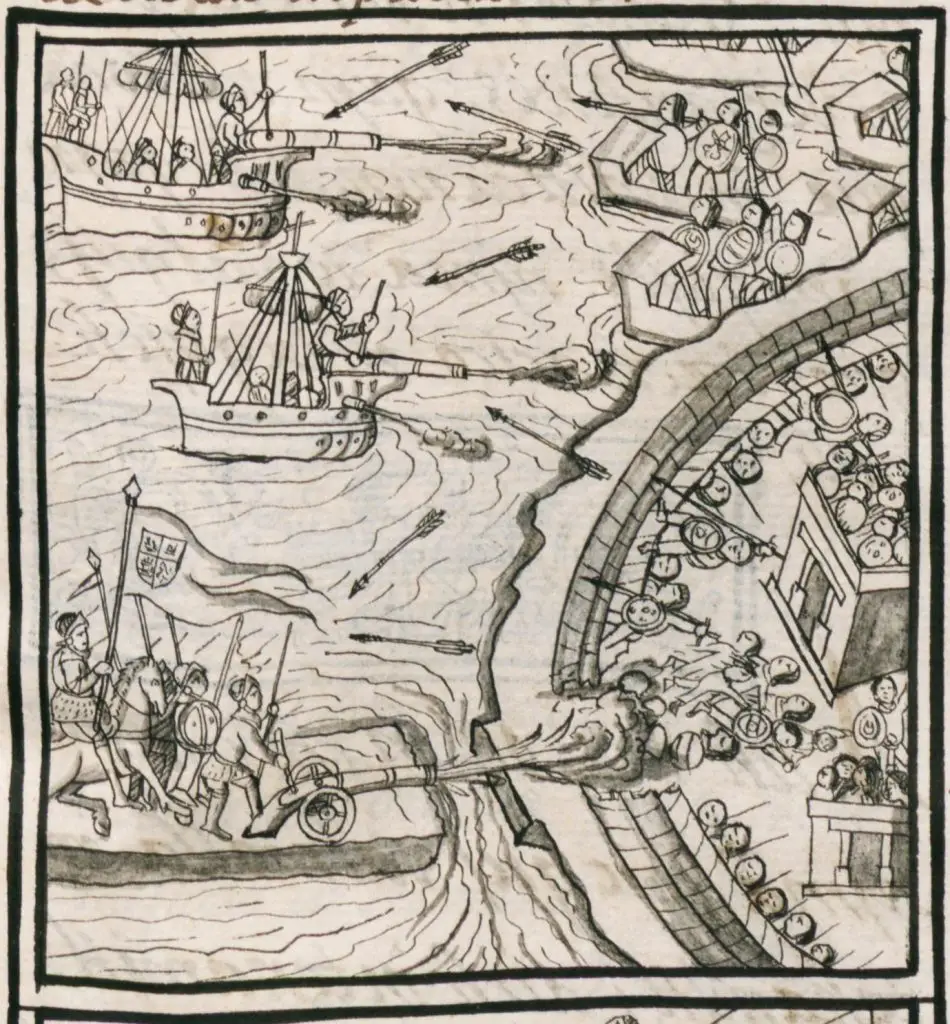
Naval assault upon the city (Wiki Image).
After regrouping and securing additional support from indigenous allies, including the Tlaxcalans, Cortés returned to Tenochtitlán in March 1521. The Spanish forces besieged the city, which the Aztecs had reinforced under the leadership of Cuitláhuac, Moctezuma’s successor. The Spanish strategy involved cutting off supplies and reinforcements to the city using their superior artillery to bombard the Aztec defenses. The siege tactics also included blockading the causeways that connected Tenochtitlán to the mainland.
The Role of Indigenous Allies
Cortés’s campaign relied heavily on the support of indigenous allies, who provided vital manpower and knowledge of local geography. The Tlaxcalans, in particular, played a crucial role, contributing thousands of warriors to the Spanish cause. This collaboration showcased the internal divisions within the Aztec Empire, as many indigenous groups resented Aztec domination and sought to reclaim their autonomy. The alliance between the Spanish and these groups transformed the nature of the conflict, making it not solely a Spanish conquest but also a struggle for liberation for many indigenous peoples.
The Final Assault
The siege culminated in a final assault on Tenochtitlán in August 1521. The Spanish forces, alongside their Indigenous allies, launched a coordinated attack on the city. The Spanish forces breached the defenses by utilizing their firearms, horses, and the advantage of surprise. The fierce urban combat ensued with hand-to-hand fighting and brutal street battles. The Spanish and their allies faced determined resistance from the Aztecs, who fought bravely to defend their city.
The Fall of Tenochtitlán
Despite their fierce resistance, the Aztecs were ultimately overwhelmed by the superior weaponry and tactics of the Spanish forces. After weeks of intense fighting, Tenochtitlán fell on August 13, 1521. The city’s capture marked the end of the Aztec Empire and the beginning of Spanish colonial rule in Mexico. The aftermath of the battle was devastating; many Aztecs died from combat, while others succumbed to famine and disease, including smallpox, which the Europeans had inadvertently introduced.
Aftermath and Consequences
The fall of Tenochtitlán had profound consequences for both the indigenous populations and the Spanish Empire. Cortés established Mexico City on the ruins of Tenochtitlán, transforming it into the capital of Spanish colonial rule in the Americas. The defeat of the Aztecs marked a significant shift in power dynamics in Mesoamerica and set the stage for further Spanish conquests across the continent. The cultural and demographic impact of the conquest would be felt for centuries as indigenous societies faced profound disruptions and transformations.
Legacy of the Battle
The Battle of Tenochtitlán remains a significant historical event, symbolizing the clash of civilizations and the consequences of imperial ambition. It serves as a reminder of the complex interactions between Europeans and indigenous peoples during the Age of Exploration. The narrative of the battle has been subject to reinterpretation, with historians exploring themes of resistance, cultural exchange, and the long-lasting effects of colonization. The fall of Tenochtitlán changed the course of Mexican history and had lasting implications for the Americas and the world, highlighting the intricate web of conquest, survival, and adaptation that defines human history.
Battle of Lepanto (1571, Mediterranean)
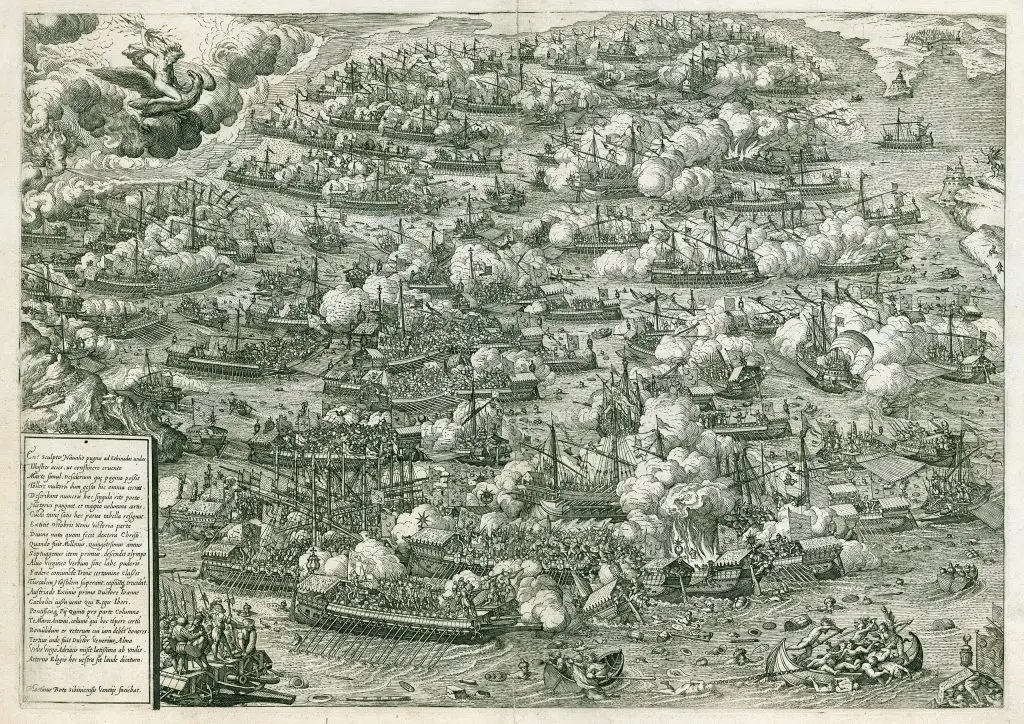
Battle of Lepanto by Martin Rota, 1572 print, Venice (Wiki Image).
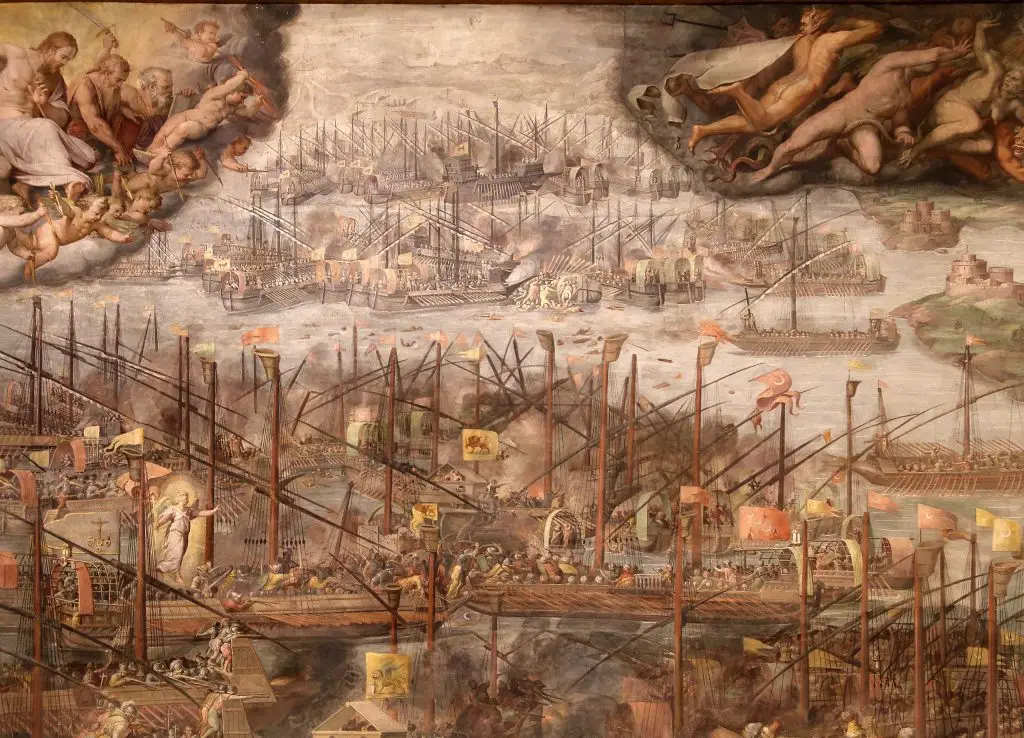
The Battle of Lepanto by Giorgio Vasari (WIki Image).
Ten notable quotes:
Here are ten quotes related to the Battle of Lepanto (1571), a historic naval battle between the Holy League and the Ottoman Empire:
- Miguel de Cervantes (famous author of Don Quixote, who fought in the battle):
- “That day, so happy for Christendom, for all the peoples of the world, and for me, because I was present at the conflict.”
- Pope Pius V (who organized the Holy League against the Ottomans):
- “The Christian fleet has triumphed! Thanks be to God!” (on hearing news of victory)
- John Julius Norwich (historian):
- “Lepanto was a victory of the Cross over the Crescent, a decisive battle that halted the Ottoman advance in the Mediterranean.”
- G.K. Chesterton (poet, from Lepanto):
- “Dim drums throbbing, in the hills half heard, / Where only on a nameless throne a crownless prince has stirred.”
- Philip II of Spain:
- “I sent you out to fight the enemy, not the weather.” (reportedly in frustration over delays due to weather conditions before the battle)
- Ali Pasha (Ottoman admiral before the battle):
- “If Allah is with us, what can men do against us?”
- Venetian chronicler:
- “It was as if the entire sea caught fire.” (describing the intensity of the fighting)
- Cervantes (again reflecting on the battle):
- “The greatest occasion seen for centuries past.”
- Pope Pius V (after the victory):
- “It was not generals, it was not battalions, but the Mother of God who has made us victors.”
- Ottoman soldier’s lament:
- “The infidels overwhelmed us with their strange iron ships and terrible fury.”
Casualties
| Force | Commander | Ships (Start) | Men (estimated) | Killed/Wounded | Prisoners | Ships Lost/Captured |
| Holy League | Don John of Austria | 206 | ~84,000 | 15,000 – 20,000 | 3,500 | 12 lost, 117 captured |
| Ottoman Empire | Uluç Ali Pasha | 230 | ~88,000 | 20,000 – 30,000 | 8,000 | ~210 lost/captured |
Export to Sheets
Battle of Lepanto 1571 – Ottoman Wars DOCUMENTARY
Lepanto 1571: Shattering the Idea of Ottoman Invincibility
Battle of Lepanto, 1571: What REALLY Happened
(YouTube video)
The Battle of Lepanto, fought on October 7, 1571, was a pivotal naval engagement between the Holy League, a coalition of Catholic maritime states, and the Ottoman Empire. This battle marked a significant turning point in the struggle for dominance over the Mediterranean Sea. The Holy League’s victory not only halted the Ottoman expansion into Europe but also had lasting effects on the balance of power in the region.
Background and Context
Under Sultan Selim II’s rule, the Ottoman Empire expanded its influence throughout the Mediterranean during the 16th century. By the mid-1500s, the Ottomans had established control over vast territories, posing a severe threat to Christian states. Pope Pius V called for a coalition of Catholic nations to form the Holy League in response to this encroachment. The League included Spain, the Papal States, Venice, and several smaller Italian states, united by a common cause to repel the Ottoman threat and protect Christendom.
Formation of the Holy League
The formation of the Holy League was a complex and challenging process. It involved negotiations among various powers, each with their agendas and rivalries. The Spanish crown, led by King Philip II, was crucial in assembling the coalition. The Venetians, led by Doge Francesco Venier, were eager to protect their trade routes and territories from Ottoman advances. Despite initial disagreements and conflicts of interest, the coalition was finally formed, with a combined fleet under the command of Don Juan of Austria, half-brother of King Philip II.
The Forces at Lepanto
The fleet of the Holy League comprised approximately 200 ships and around 30,000 men, including soldiers and sailors. The flagship, the Real, was a heavily armed galleass. The Ottoman fleet, commanded by Ali Pasha, was more numerous, consisting of around 330 vessels and an estimated 35,000 to 40,000 men. The Ottomans had a well-established naval tradition, but the quality of their ships and crews varied. The battle’s outcome would depend not only on the size of the fleets but also on tactics, leadership, and the determination of the crews.
The Battle Begins
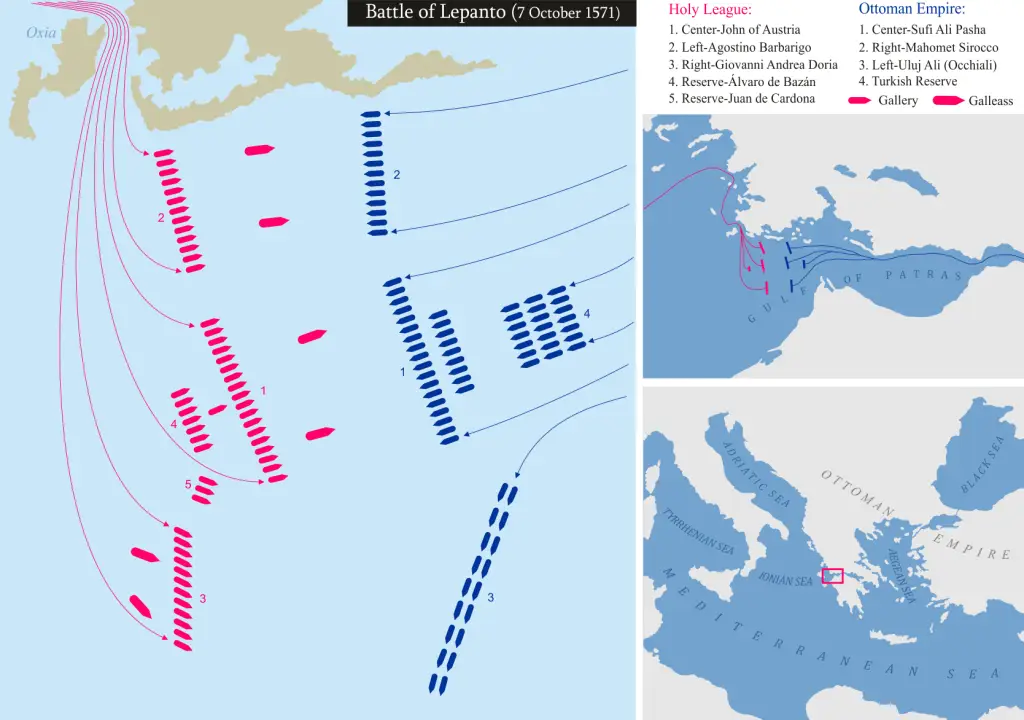
Plan of the Battle (formation of the fleets just before contact) (Wiki Image).
The two fleets met in the Gulf of Patras near the city of Lepanto. Early in the morning, the Holy League initiated the engagement with a powerful artillery bombardment. The Ottomans responded with cannon fire, and the battle quickly descended into chaos as the ships clashed in close combat. The Holy League’s lighter and more maneuverable galleys gained an advantage over the heavier Ottoman ships, which struggled to operate effectively in the confined waters of the Gulf.
Turning Point and Tactics
As the battle raged on, several key factors influenced the outcome. The skillful maneuvering of the Holy League’s galleys allowed them to break the Ottoman line. Don Juan of Austria demonstrated exceptional leadership, coordinating his forces effectively and maintaining morale among his sailors. The use of artillery proved decisive, with the Holy League’s ships equipped with powerful cannons that severely damaged the Ottoman vessels. The Ottomans, facing fierce resistance and high casualties, began to falter.
Ottoman Defeat and Aftermath
The tide of the battle turned in favor of the Holy League, leading to a decisive victory. The Ottomans lost around 200 ships, while the Holy League suffered significantly fewer losses, estimated at about 50 ships. Ali Pasha was killed in battle, and many Ottoman soldiers were captured or drowned as their fleet disintegrated. The victory at Lepanto was celebrated throughout Europe as a triumph for Christendom and marked the beginning of a decline in Ottoman naval power.
Impact on the Mediterranean Balance of Power
The Battle of Lepanto had far-reaching consequences for the Mediterranean geopolitical landscape. The defeat significantly weakened the Ottoman navy, forcing them to adopt a more defensive posture in subsequent years. Although the Ottomans remained a formidable land power, their inability to project naval power effectively limited their influence in maritime conflicts. The victory of the Holy League emboldened Christian states and invigorated their resistance against Ottoman expansion.
Cultural Significance and Legacy
The Battle of Lepanto inspired a wave of cultural and artistic expression. It symbolized the struggle between Christianity and Islam, often depicted in literature, paintings, and even operas. Notable artists, such as El Greco, created works celebrating the victory. The battle’s significance is reflected in its commemoration within the Catholic tradition, with the feast of Our Lady of the Rosary established to honor the triumph attributed to divine intervention. The legacy of Lepanto serves as a reminder of the complex interplay of power, religion, and culture in shaping European history during the Age of Exploration.
In summary, the Battle of Lepanto was a landmark event that marked a turning point in the Ottoman Empire’s naval dominance and had profound implications for the broader geopolitical landscape of Europe and the Mediterranean. The victory underscored the importance of unity among Christian states in the face of a common threat and left an enduring legacy in cultural and religious history.
Spanish Armada (1588, England Channel)
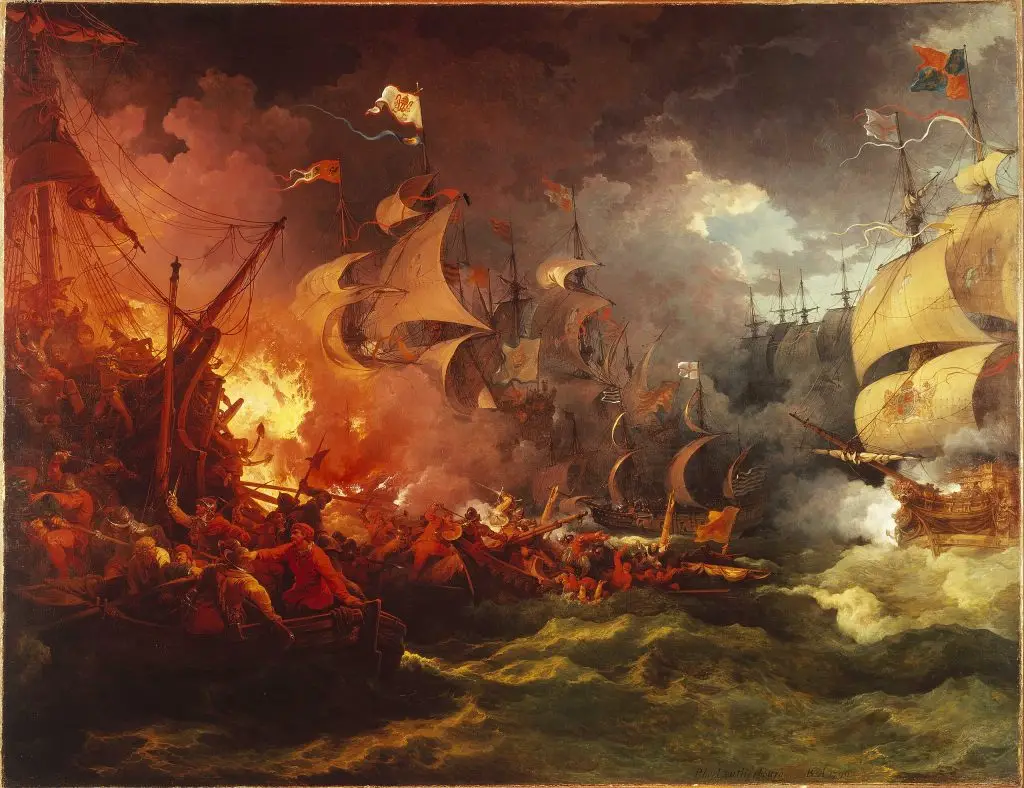
Defeat of the Spanish Armada, 8 August 1588, painted by Philip James de Loutherbourg (1796) (Wiki Image).
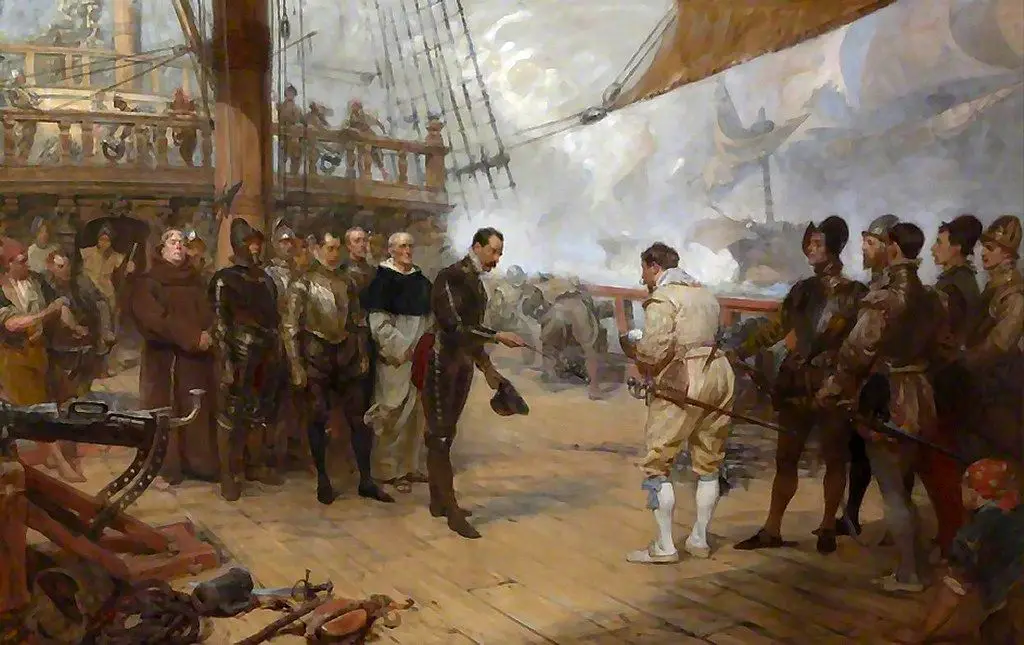
The Surrender of Pedro de Valdés (commander of the Squadron of Andalusia) to Francis Drake aboard the Revenge during the attack of the Spanish Armada, 1588, by John Seymour Lucas (Wiki Image).
Ten notable quotes:
Here are ten quotes related to the Spanish Armada (1588, English Channel), one of the most famous naval encounters between Spain and England:
- Queen Elizabeth I (in her famous speech to the troops at Tilbury):
- “I know I have the body of a weak and feeble woman, but I have the heart and stomach of a king and of a king of England, too.”
- King Philip II of Spain:
- “I sent the Armada against men, not God’s winds and waves.” (after the Armada’s defeat)
- Sir Francis Drake (English admiral, in response to the Spanish approach):
- “There must be a beginning of any great matter, but the continuing unto the end until it be thoroughly finished yields the true glory.”
- Anonymous Spanish officer:
- “The whole bay was on fire like the heavens had rained hell upon us.”
- Sir Walter Raleigh (reflecting on the aftermath):
- “The Invincible Armada had more of the wind and the waves to contend with than the swords of Englishmen.”
- Luis de Córdova (Spanish commander):
- “We fight not only against the English but against the elements themselves.”
- Sir John Hawkins (English commander):
- “God has breathed on them, and they are scattered.” (regarding the storm that helped defeat the Armada)
- Pope Sixtus V:
- “Had I but known that the fleet would be so ruined by winds, I would not have so cheerfully contributed funds for its voyage.”
- Sir Martin Frobisher (English vice admiral):
- “With God’s favor and the skill of our mariners, we have scattered the pride of Spain upon the sea.”
- Contemporary English ballad:
- “With an invincible navy they came, / Threatening fire and the sword, / But by the breath of God they were swept away, / The proud Armada of Spain.”
Casualties
| Forces | Number of Combatants | Casualties (Killed/Wounded) | Prisoners | Ships Involved | Ships Lost |
| Spanish Armada | ~30,000 soldiers & sailors | Casualties: ~20,000 (various causes) | Prisoners: Few survivors captured | 130 ships | 63 ships lost (sunk, wrecked, captured) |
| English Navy | ~15,000 sailors & soldiers | Casualties: ~100 dead, ~400 wounded | Prisoners: N/A | 200 ships (mostly smaller) | 0 ships lost |
History Of Warfare – The Spanish Armada – Full Documentary
The Untold Story Of The Spanish Armada: The Truth Behind …
Spanish Armada: How England Defended Itself – Early …
(YouTube video)
The Spanish Armada, launched in 1588, is one of history’s most famous naval conflicts. It marked a pivotal moment in the struggle between England and Spain during the late 16th century. This colossal fleet, comprising around 130 ships, was sent by King Philip II of Spain to invade England and restore Catholicism after a period of Protestant rule under Queen Elizabeth I. The event is often remembered for its dramatic battles and the shifting tides of power in Europe.
Background
The roots of the Spanish Armada can be traced to the religious and political tensions between Catholic Spain and Protestant England. Elizabeth I’s accession to the throne in 1558 heightened these tensions, mainly as she supported Protestant causes in Europe and authorized raids on Spanish ships and territories. The execution of Mary, Queen of Scots, in 1587 further inflamed Philip II, who viewed Elizabeth as an illegitimate ruler and a usurper of the Catholic faith. Determined to eliminate Protestantism in England and reassert Spanish dominance, Philip prepared a massive fleet for invasion.
The Armada’s Composition
The Armada was an impressive assembly of ships, including galleons, transport ships, and support vessels. It was designed to carry soldiers for the invasion and protect the fleet during its journey. Commanded by the Duke of Medina Sidonia, the fleet aimed to transport about 30,000 troops across the Channel to England, where they would unite with English Catholics to dethrone Elizabeth. However, the Armada was plagued by logistics, supply, and coordination issues, which later contributed to its downfall.
The Initial Plan
The original plan for the Armada involved a coordinated attack on England. The Spanish fleet would sail to the Netherlands, picking up additional troops. From there, the combined forces would invade England. However, the plan quickly ran into complications, including delays due to poor weather and the loss of ships during its assembly. Despite these setbacks, Philip II was determined to proceed, convinced that England’s defeat was imminent.
The Encounter with the English Fleet
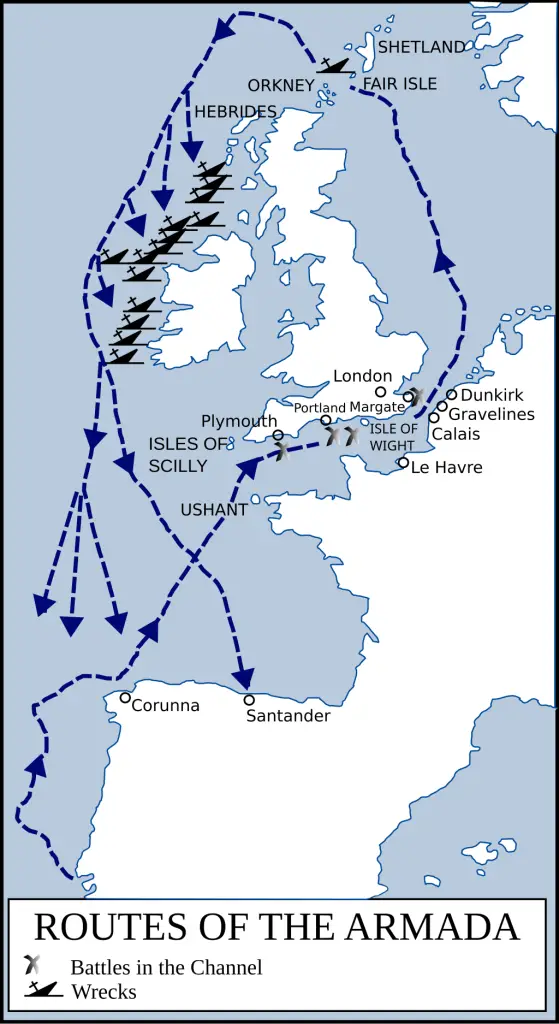
Route of the Spanish Armada (Wiki Image).
The Armada set sail in May 1588. The English, led by Admiral Sir Francis Drake and other naval commanders, were prepared for a confrontation. The English fleet engaged the Spanish in skirmishes using faster, more maneuverable ships. The English ships employed tactics such as “hit-and-run” attacks, targeting the Spanish galleons, which were heavily armed but slower and less agile. This naval warfare demonstrated the effectiveness of the English tactics against the traditional Spanish approach.
The Battle of Gravelines
The most significant clash occurred on July 29, 1588, at the Battle of Gravelines. The English fleet launched a fierce assault on the Armada, employing their superior speed and artillery. The battle significantly damaged the Spanish ships, with several vessels sunk or disabled. The English inflicted heavy casualties, demonstrating their naval prowess and strategic superiority. The Duke of Medina Sidonia faced tremendous challenges maintaining order and coordination among the Armada’s ranks, leading to confusion and disorder.
The Storm and the Retreat
Following the battle, the Spanish fleet faced another disaster: a severe storm that battered their ships as they attempted to return to Spain. Known as the “Protestant Wind,” this tempest wreaked havoc on the already weakened Armada, scattering ships and forcing many to run aground or sink. The storm compounded the losses suffered in battle, further decimating the fleet. By the time the remnants of the Armada returned to Spain, only a fraction of the original fleet remained.
Consequences of the Armada
The defeat of the Spanish Armada had profound implications for both Spain and England. For Spain, it marked the beginning of a gradual decline in its naval power and influence, leading to a shift in the balance of power in Europe. The loss tarnished Philip II’s reputation and diminished Spanish sea dominance. For England, the victory solidified Elizabeth I’s position and bolstered national pride, reinforcing the Protestant cause. It also inspired a new wave of naval exploration and expansion as England emerged as a formidable maritime power.
Historical Legacy
The Spanish Armada remains a symbol of the clash between two powerful empires and the changing dynamics of European politics in the late 16th century. Its legacy continues in discussions of naval warfare, imperial ambition, and religious conflict. The events surrounding the Armada have inspired countless works of literature and historical analysis, serving as a reminder of the complexities of war, strategy, and the unpredictable nature of fortune at sea.
Battles of Saratoga (1777, America)
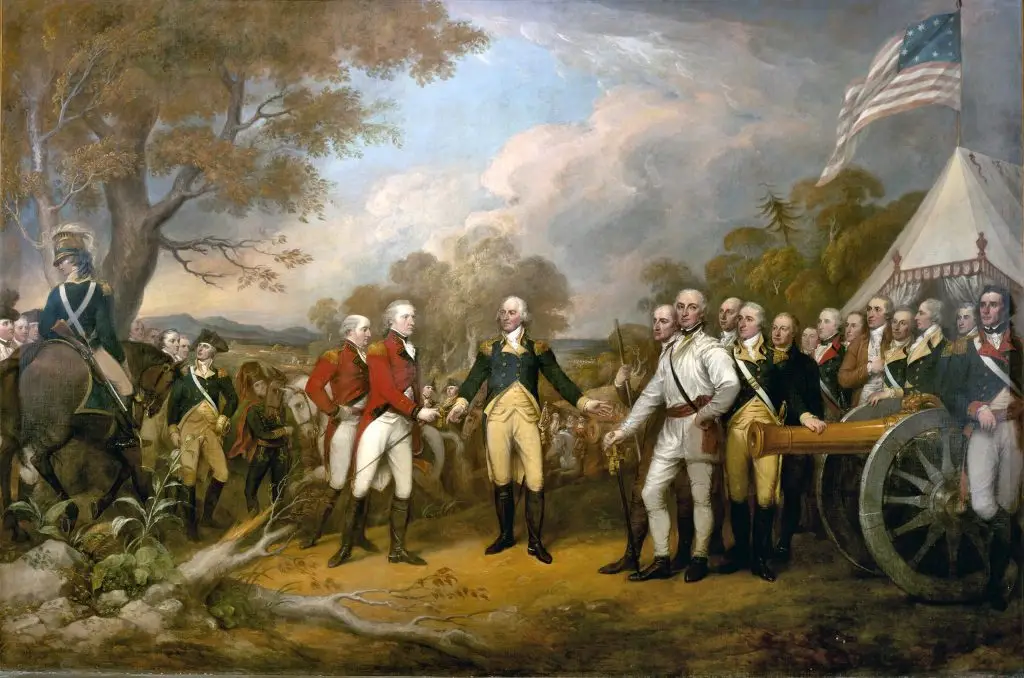
Surrender of General Burgoyne is an 1822 portrait by John Trumbull of a British Army general surrendering to General Horatio Gates, who refused to take his sword. The painting presently hangs in the United States Capitol Rotunda (Wiki Image).
Ten notable quotes:
Here are ten quotes related to the Battles of Saratoga (1777, America), a turning point in the American Revolutionary War:
- General John Burgoyne (British commander, before surrendering):
- “The fortunes of war have made me your prisoner.” (to General Gates after the British defeat)
- General Horatio Gates (American commander):
- “The Almighty has been pleased to grant us another signal victory.”
- General Benedict Arnold (American commander during the battle):
- “Victory or death!” (leading a charge at Bemis Heights)
- Henry Clinton (British general, on the lack of reinforcements):
- “I can do no more. The game is up.”
- American soldier’s diary:
- “The sight of Burgoyne’s army laying down their arms was a noble spectacle indeed, and it made our hearts swell with joy.”
- Benjamin Franklin (on the French reaction to Saratoga):
- “This event will, I hope, encourage our European friends to stand by us with vigor.”
- Sir Henry Clinton (British commander, frustrated by lack of coordination):
- “I could do nothing to assist Burgoyne. His fate was sealed long before we even heard of his needs.”
- Thomas Paine:
- “Saratoga was the turning point of the American Revolution, for it brought France into the war, and with it, victory.”
- King George III:
- “We must be resigned to our misfortune, but I hope it will soon be remedied by the speediest exertions.” (after learning of Burgoyne’s surrender)
- Marquis de Lafayette (French general on the significance of Saratoga):
- “This victory has been the greatest joy for our allies, and it lights the flame of freedom across the seas.”
Casualties
| Forces | Number of Combatants | Casualties (Killed/Wounded) | Prisoners |
| American Continental Army | ~12,000-15,000 | Killed/Wounded: ~500-800 | Prisoners: 0 |
| British Army (incl. German Hessians) | ~8,000 | Killed/Wounded: ~1,200 | Prisoners: ~5,800 (surrendered) |
American Revolution: The Battle of Saratoga, 1777
The Battle of Saratoga and “the Compleat Victory” | Kevin …
Battle of Saratoga: A Turning Point in the Revolutionary War
(YouTube video)
The Battles of Saratoga, fought in September and October 1777, marked a turning point in the American Revolutionary War. Comprising two significant battles—Freeman’s Farm (September 19) and Bemis Heights (October 7)—these engagements were pivotal in securing American victory against British forces. The outcome of Saratoga not only boosted American morale but also garnered crucial international support, particularly from France, ultimately shaping the trajectory of the war.
Background
By 1777, the American Revolutionary War had entered its second year, with the Continental Army facing significant challenges. British General John Burgoyne devised a plan to divide New England from the southern colonies by capturing the Hudson River Valley, a strategic supply route. Burgoyne’s campaign involved moving his army south from Canada through maneuvers designed to isolate and subdue American forces. However, his plan faced complications due to logistical issues and fierce resistance from the American forces.
The First Battle: Freeman’s Farm
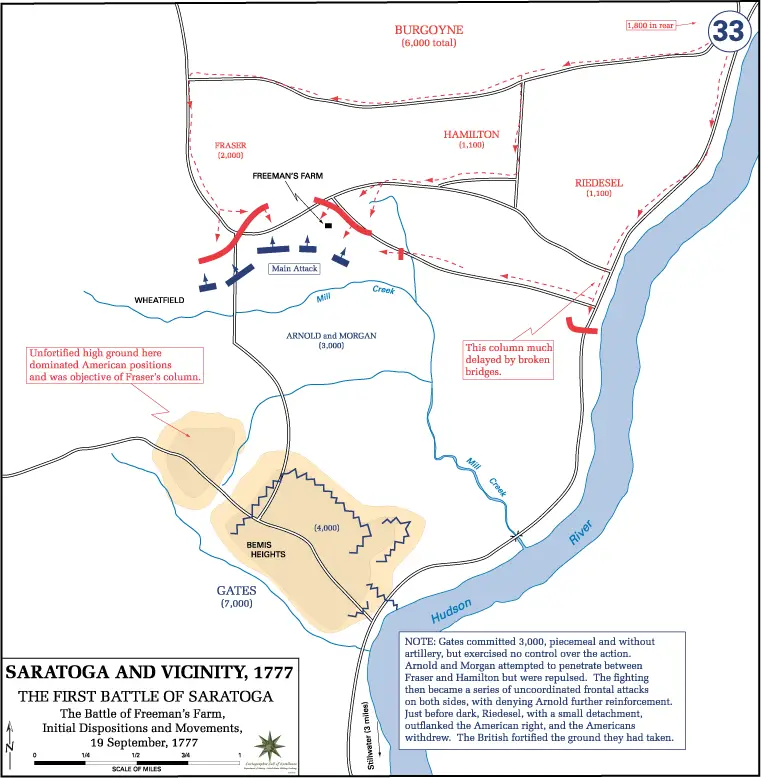
Initial dispositions and movements at the Battle of Freeman’s Farm, 19 September 1777 (Wiki Image).
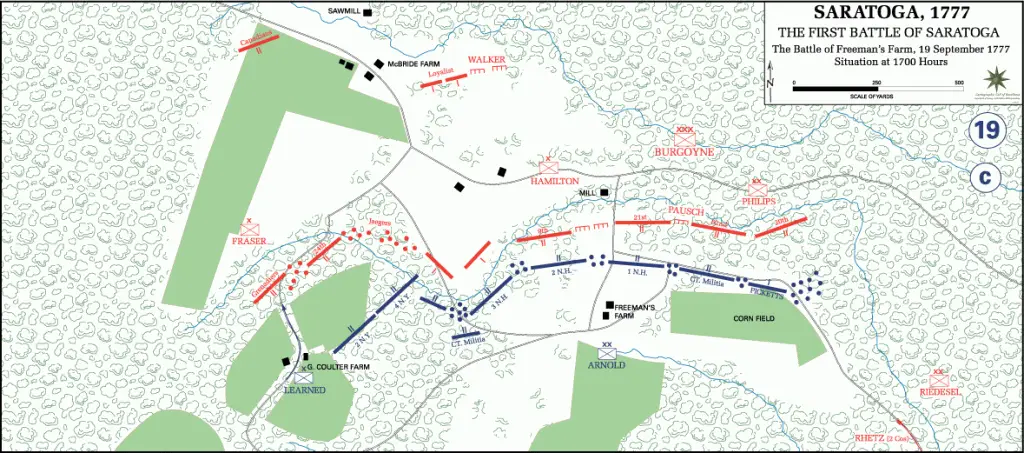
Map depicting the positions at 5:00 pm (Wiki Image).
The first significant confrontation occurred at Freeman’s Farm on September 19, 1777. Burgoyne’s forces clashed with General Horatio Gates, the American commander. The battle was intense and marked by heavy fighting, with both sides suffering casualties. Despite the British gaining ground, they could not secure a decisive victory. The American troops, bolstered by their knowledge of the terrain and fighting for their cause, displayed remarkable resilience, forcing the British to reassess their strategy.
The Second Battle: Bemis Heights
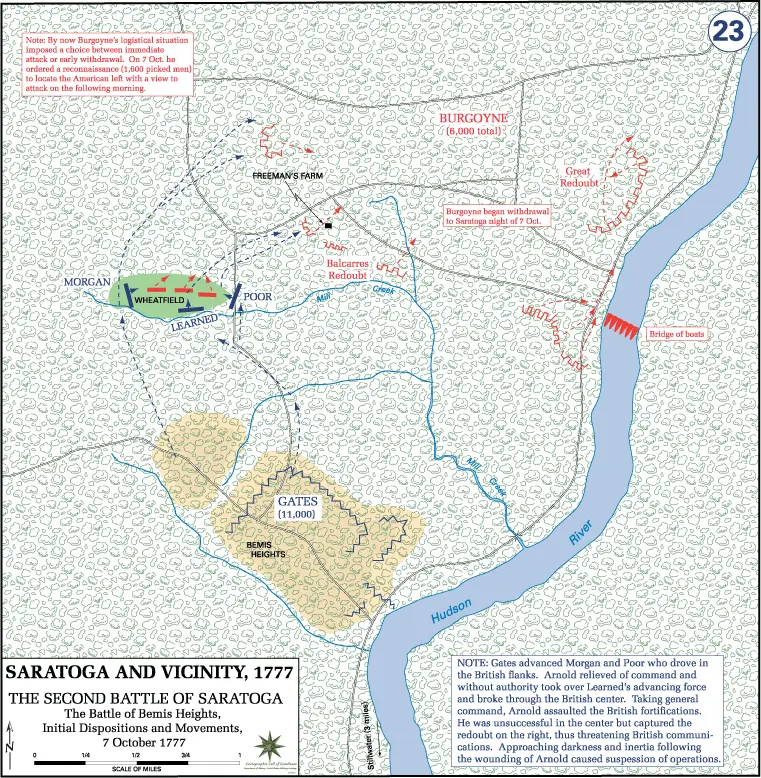
Troop dispositions and initial movements at the Battle of Bemis Heights. The only known contemporary American map showing the positions of the two armies was made by Rufus Putnam, who commanded the 5th Massachusetts Regiment in Nixon’s Brigade (Wiki Image).
The second battle at Bemis Heights took place on October 7, 1777. In a fierce engagement, the Americans, now more organized and determined, launched a series of counterattacks against the British. Key figures such as Benedict Arnold, who played a vital role despite being technically under Gates’ command, led bold assaults that exploited British weaknesses. The Americans managed to encircle Burgoyne’s forces, creating a situation where retreat became impossible.
Turning Point
The outcome of the Battles of Saratoga was a resounding American victory, with Burgoyne ultimately surrendering his army on October 17, 1777. This defeat marked a significant turning point in the Revolutionary War. The victory boosted American morale and demonstrated that the Continental Army could stand up to the British regulars. The news of the American triumph reverberated through Europe, capturing the attention of potential allies.
International Implications
The success at Saratoga played a crucial role in persuading France to formally ally with the American cause. Following the battles, French diplomats and military leaders recognized the viability of the American struggle for independence. The Treaty of Alliance, signed in 1778, committed France to provide the Americans with military assistance, supplies, and naval support. This alliance significantly altered the balance of power in the war, bringing additional resources and troops into the conflict against the British.
Legacy of the Battles
The Battles of Saratoga are often regarded as the “turning point” of the American Revolutionary War. They solidified American resolve and unity, inspiring further enlistment and participation in the struggle for independence. The victories also demonstrated the effectiveness of American military strategy and the importance of leadership on the battlefield. Saratoga’s legacy endures in American history, symbolizing the triumph of perseverance and the impact of strategic alliances.
Aftermath and Continued Conflict
Following the battles, the British shifted their focus to the southern colonies, hoping to rally Loyalist support and regain control. However, the momentum gained from Saratoga fueled the American cause and encouraged further resistance. The war would continue for several more years, with the Continental Army facing numerous challenges, but the spirit ignited by the victories at Saratoga would sustain their fight for independence.
Commemoration and Historical Significance
Today, the Saratoga National Historical Park serves as a reminder of the battles’ significance, honoring the sacrifices made during the conflict. The events of 1777 are studied not only for their military strategies but also for their impact on the broader narrative of American independence. The Battles of Saratoga are a testament to the power of determination, the importance of alliances, and the enduring legacy of those who fought for liberty.
French Invasion of Russia (1812, Russia)
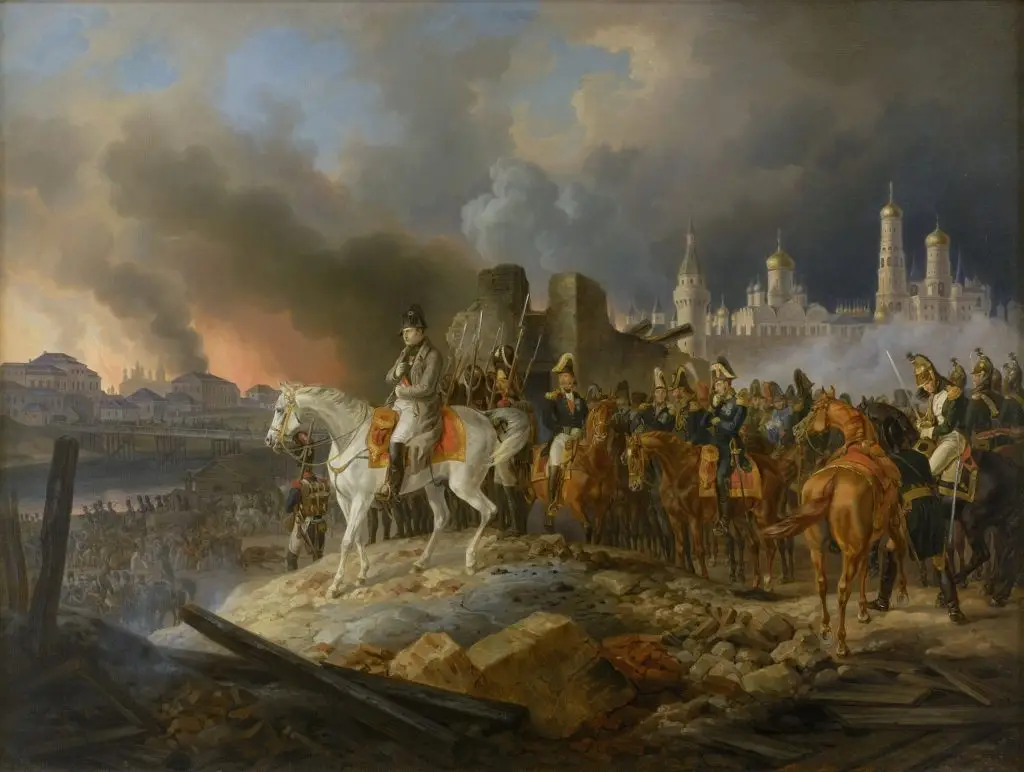
Napoleon watched the fire of Moscow in September 1812 (Wiki Image).
Ten notable quotes:
Here are ten quotes related to the French Invasion of Russia (1812), also known as Napoleon’s disastrous campaign:
- Napoleon Bonaparte (on his ambition before the invasion):
- “Russia is a vast empire, but I shall overrun it in a few months. I am the master of Europe, and soon, I will be the master of the world.”
- Napoleon Bonaparte (reflecting during the retreat):
- “Of the 400,000 men who crossed the Niemen, less than 100,000 returned. My campaign in Russia was the beginning of the end.”
- Count Philippe-Paul de Ségur (French officer describing Moscow):
- “Moscow was not a conquest; it was a trap. The fire consumed not only the city but our hopes.”
- Marshal Michel Ney (French marshal during the retreat):
- “Retreat? Hell, we are not retreating. We are advancing in the opposite direction!”
- Tsar Alexander I (on the scorched-earth strategy):
- “Napoleon will find nothing here but death and destruction. If he wants Moscow, let him have it—but it will be a city of ashes.”
- Leo Tolstoy (in War and Peace, describing the invasion):
- “Napoleon felt the ebb of his power as the Russian winter closed in. Nature itself had risen against him.”
- General Armand de Caulaincourt (French diplomat on the horrors of the retreat):
- “The cold was so intense that men fell asleep and never woke up. Horses collapsed in the snow, and there was nothing to replace them.”
- Russian General Mikhail Kutuzov (on Napoleon’s defeat):
- “The enemy is defeated not by us but by his own hubris and the relentless Russian winter.”
- Napoleon Bonaparte (on the Russian winter):
- “The cold is what killed my army, not the Russian army. It was the cold, the eternal cold.”
- Baron de Marbot (French officer describing the retreat):
- “We were like ghosts, walking on ice. The Emperor was silent, and we followed him like shadows of our former selves.”
Casualties
| Force | Commander | Initial Strength (estimated) | Killed/Died | Wounded | Captured | Total Casualties (estimated) |
| French and Allied Forces | Napoleon Bonaparte | 680,000 – 690,000 | 200,000+ | 150,000+ | 100,000+ | 450,000 – 500,000+ |
| Russian Forces | Tsar Alexander I | 200,000 – 400,000 | 150,000+ | 70,000+ | 40,000+ | 260,000 – 300,000+ |
Export to Sheets
Napoleon’s invasion of Russia visualized
Napoleonic Wars: The Invasion of Russia (All Parts)
Napoleon’s Greatest Failure: A Winter Campaign In Russia
(YouTube video)
The French Invasion of Russia in 1812 was a significant and disastrous military campaign during the Napoleonic Wars. Led by Napoleon Bonaparte, it aimed to compel Tsar Alexander I to rejoin the Continental System and undermine British economic interests. However, the campaign became one of the most catastrophic military failures in history, resulting in heavy losses for the French army and altering the balance of power in Europe.
Background
In the early 19th century, Napoleon sought to expand his empire across Europe, and his Continental System aimed to weaken Britain by enforcing economic blockades. Russia, initially an ally of France, became discontented with the restrictions imposed by the system. Tensions escalated, and in 1811, the relationship deteriorated further as Alexander I withdrew from the Continental System, prompting Napoleon to prepare for an invasion.
The Grand Army
In June 1812, Napoleon assembled an enormous multinational force, the Grande Armée, numbering around 600,000 troops. This army included soldiers from various allied states and represented one of the largest military coalitions in history. Napoleon’s strategy relied on rapid movement and decisive battles to defeat the Russian forces before they could retreat deep into the country’s vastness. The French army crossed the Neman River on June 24, 1812, marking the official beginning of the invasion.
Initial Successes
In the initial phases of the campaign, Napoleon’s forces experienced a series of successes. Under the command of generals like Mikhail Kutuzov, the Russian army employed a scorched earth strategy, retreating and destroying supplies to prevent the French from resupplying. Despite facing a retreating enemy, Napoleon won several battles, including the Battle of Smolensk and Borodino in September 1812. The Battle of Borodino, in particular, was one of the bloodiest encounters of the war, resulting in significant casualties on both sides. Still, it ultimately allowed the French to advance towards Moscow.
The Capture of Moscow
By mid-September 1812, Napoleon’s forces entered Moscow, expecting a decisive victory and a swift resolution. However, the city was largely abandoned, and the Russian army had set fire to many buildings, leaving the French without adequate supplies or shelter for the harsh winter ahead. Napoleon’s hopes of compelling Alexander I to negotiate were dashed, and the French army found itself in a precarious situation, facing dwindling resources and growing discontent among its troops.
The Harsh Winter
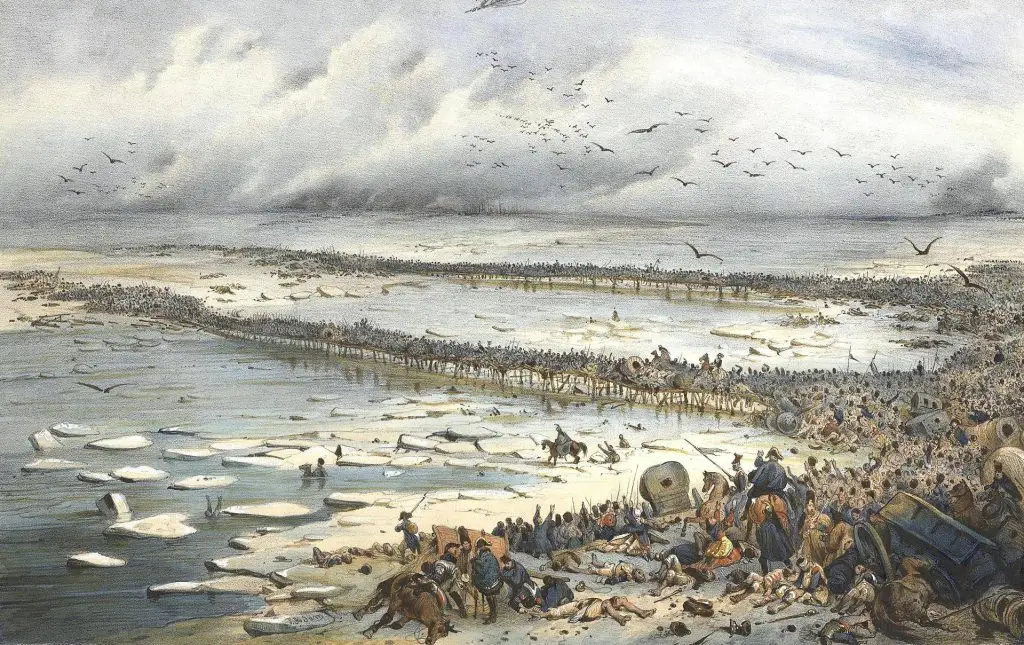
Crossing the Berezina River by Victor Adam (Wiki Image).
As the French army prepared to winter in Moscow, the conditions deteriorated rapidly. The Russian winter is notoriously harsh, and Napoleon had not planned for the extreme cold that set in during late 1812. The soldiers suffered from frostbite, starvation, and disease, and morale plummeted. The once-mighty Grande Armée, weakened and demoralized, was unprepared for the brutal conditions awaiting them.
The Retreat
In late October 1812, after waiting in vain for a response from the Tsar, Napoleon ordered a retreat from Moscow. The retreat was disastrous; the troops faced relentless attacks from Russian forces, who exploited the French’s weakened state. The scorched earth tactics continued, leaving the retreating army without sufficient food or shelter. The brutal combination of starvation, exposure to the cold, and constant harassment led to the destruction of much of the Grande Armée.
Aftermath and Consequences
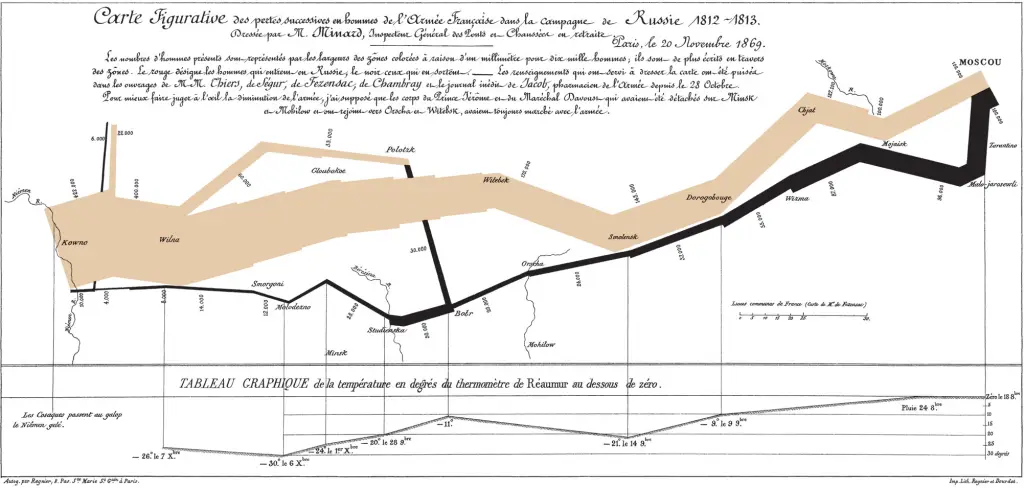
Minard’s Map of French casualties also shows Attrition warfare against Napoleon (Wiki Image).
By the time the remnants of the French army crossed back into friendly territory, they had suffered catastrophic losses. Estimates suggest that only around 100,000 soldiers returned from the original force of 600,000. The failed invasion marked a turning point in the Napoleonic Wars. The weakened state of France emboldened its enemies, leading to a coalition of European powers that would ultimately defeat Napoleon in subsequent campaigns.
Legacy of the Invasion
The French invasion of Russia remains a significant historical event, illustrating the perils of overextension in military campaigns and the harsh realities of warfare in extreme conditions. It also had lasting impacts on European politics, leading to Napoleon’s eventual downfall and reshaping the continent’s balance of power. The campaign is often studied as a classic example of military strategy, logistics, and the human cost of ambition in war, serving as a cautionary tale for future military leaders.
Battle of Little Bighorn (1876, America)
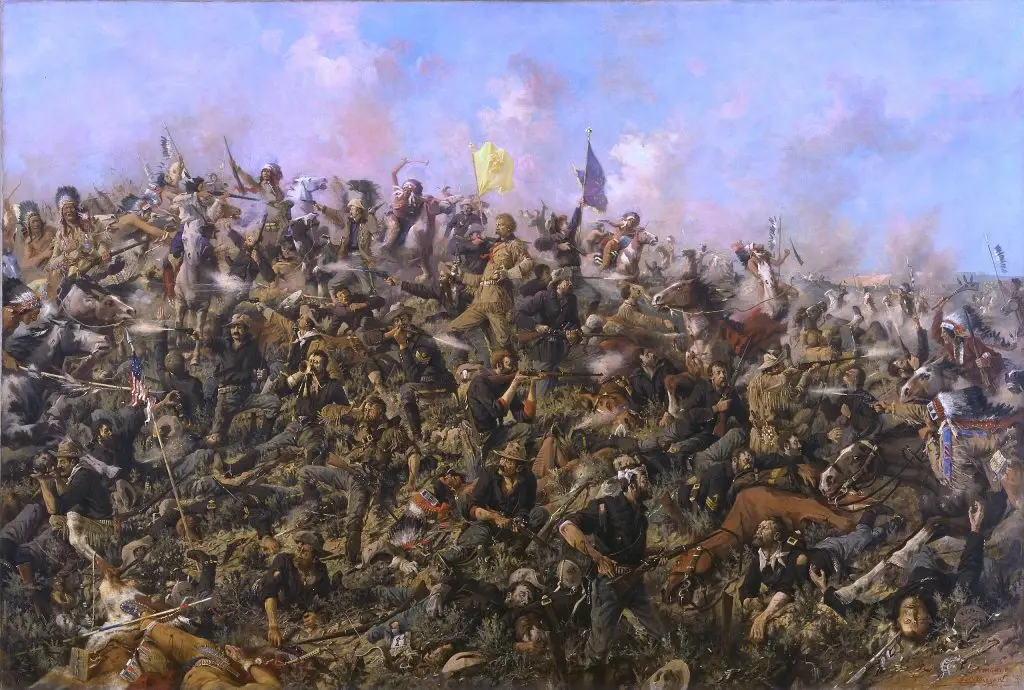
Custer’s Last Stand by Edgar Samuel Paxson (Wiki Image).
Ten notable quotes:
The Battle of Little Bighorn (June 25-26, 1876), also known as “Custer’s Last Stand,” was a major confrontation between the U.S. 7th Cavalry and the combined forces of the Lakota Sioux, Cheyenne, and Arapaho tribes. These quotes capture the drama, heroism, and tragedy of the battle:
- Sitting Bull, Lakota leader, reflecting on the battle:
“I am tired of fighting… Hear me, my chiefs! I am tired. My heart is sick and sad. From where the sun now stands, I will fight no more forever.”
Chief Joseph of the Nez Perce said this later, but it reflects the sentiment of many Native leaders after the long struggles against U.S. forces. - Chief Gall, Hunkpapa Lakota warrior, on the overwhelming victory:
“We circled around them like water around a stone.”
Gall’s description of their encircling strategy illustrates the tactical brilliance of the Native forces. - Lieutenant Colonel George Armstrong Custer, before the battle:
“Where did all these Indians come from? This is the biggest Indian village I’ve ever seen.”
Custer’s surprise highlights his underestimation of the Native coalition’s strength. - Rain-in-the-Face, Lakota warrior, describing the moment of victory:
“I killed a man with my lance… and I was glad, for it was a good day to die.”
This powerful statement reflects the warrior culture and the sense of destiny in battle for the Native tribes. - General Alfred Terry, after discovering Custer’s defeat:
“Custer has been overwhelmed, but the disaster is as yet beyond belief.”
Terry’s shock captures the magnitude of the loss for the U.S. Army. - Crazy Horse, Lakota military leader, rallying his warriors:
“Hokahey! It is a good day to die!”
Crazy Horse’s battle cry echoes his fierce determination to fight against overwhelming odds. - Elizabeth Custer, widow of George Custer, defending her husband’s legacy:
“He died as he had lived, a soldier devoted to his cause.”
This quote shows Elizabeth’s loyalty and her efforts to preserve Custer’s image as a hero despite the catastrophic defeat. - Two Moons, Cheyenne chief, recounting the final moments of Custer’s forces:
“The soldiers were so brave, but they fell one by one, like buffalo before the hunters.”
Two Moons’ reflection emphasizes the courage of Custer’s men even in the face of inevitable defeat. - Red Horse, Sioux warrior, describing the battle’s carnage:
“There was not a white man alive when the fighting was over.”
This stark statement captures the totality of the Native victory and the devastating losses for the U.S. Army. - A U.S. cavalry survivor recalling the intensity of the battle:
“The air was thick with bullets, and the yells of the Indians surrounded us. There was no escape.”
This conveys the terror and confusion experienced by the U.S. soldiers during the battle’s most desperate moments.
Casualties
| Force | Commanders | Strength (estimated) | Killed in Action | Wounded |
| US 7th Cavalry | Lt. Col. Custer † | 647 | 268 | 55 |
| Custer’s Battalion | Custer † | 210 | 210 | – |
| Reno’s Battalion | Major Reno | 140 | 58 | – |
| Benteen’s Battalion | Captain Benteen | 125 | 0 | – |
| McDougall’s Detachment | Captain McDougall | 172 | 0 | – |
| Lakota, Northern Cheyenne, and Arapaho | Sitting Bull, Crazy Horse | 1,500-2,500 | 31-100 | 160+ |
Export to Sheets
Battle of the Little Bighorn – Custer’s Last Stand | History |
Battle Of The Little Bighorn | Custer’s Last Stand | Sitting Bull …
Battle of the Little Bighorn, Custer’s Last Stand
(YouTube video)
The Battle of Little Bighorn, fought on June 25 and 26, 1876, was a significant conflict between the United States Army and a coalition of Native American tribes, primarily the Lakota Sioux and Northern Cheyenne. This battle is often remembered as a pivotal moment in the Indian Wars and exemplifies the intense struggles between the U.S. government and Native Americans over land and sovereignty.
Background
The battle was set against the backdrop of increasing tensions between Native Americans and settlers encroaching on their lands in the West. Following the discovery of gold in the Black Hills of South Dakota, the U.S. government sought to assert control over these territories, guaranteed to the Lakota through the Treaty of Fort Laramie in 1868. The U.S. Army aimed to suppress Native resistance and force tribes onto reservations, leading to rising hostilities.
The Great Sioux War
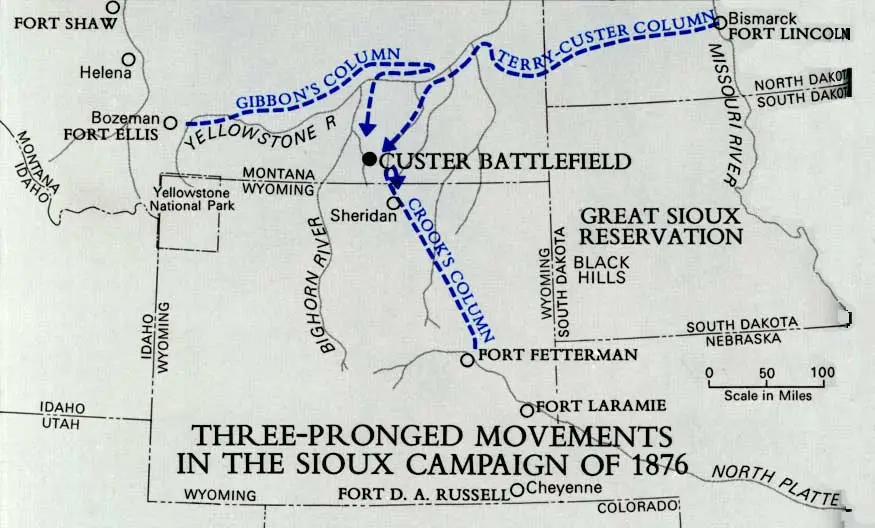
1876 US Army campaign against the Sioux (Wiki Image).
The Little Bighorn battle was part of the larger Great Sioux War of 1876, a series of battles and negotiations between the U.S. government and various Native American tribes. In response to the government’s failure to uphold treaties and the influx of settlers, the Lakota, under the leadership of Sitting Bull, and the Cheyenne, led by Crazy Horse, united to resist U.S. military encroachment. The tribes aimed to protect their land and way of life, culminating in confrontations.
Custer’s Last Stand
The U.S. Army, commanded by Lieutenant Colonel George Armstrong Custer, was tasked with subduing the Native American resistance. Custer led the 7th Cavalry into the Little Bighorn Valley, believing he could defeat the scattered tribes quickly. However, he underestimated the size of the Native American force, which was much larger than he anticipated. The tribes had gathered an estimated 2,000 to 3,000 warriors at the Little Bighorn River, ready to defend their territory.
The Battle
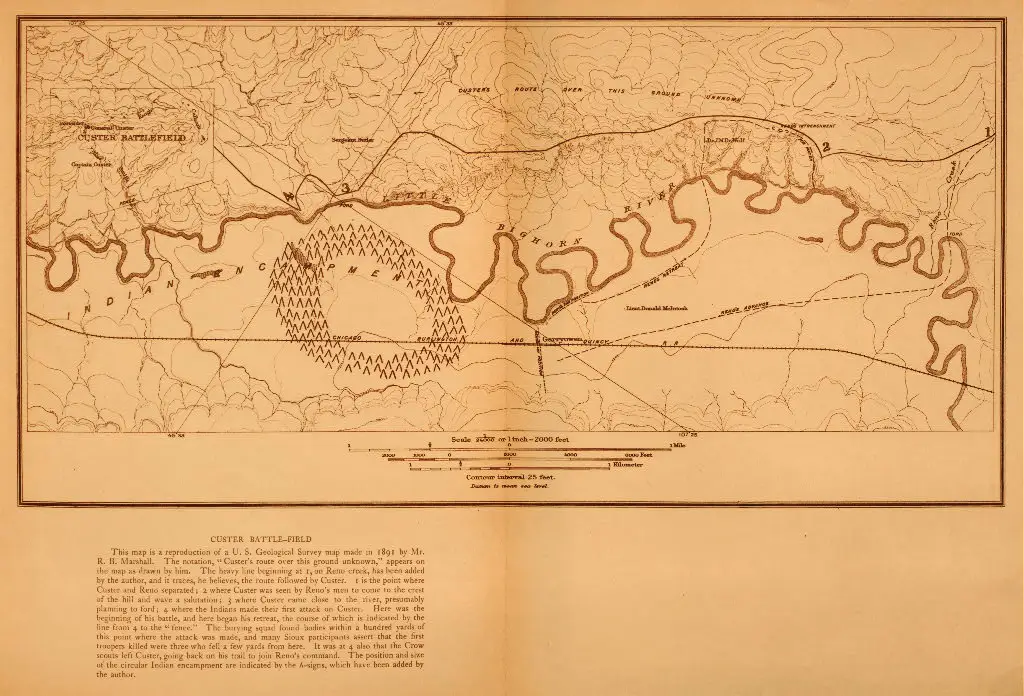
Custer’s route over the battlefield, as theorized by Curtis. (Credit: Northwestern University Library Edward S. Curtis’s The North American Indian, 2003) (Wiki Image).
On June 25, 1876, Custer divided his forces into three battalions to attack the encampment. As he advanced, he encountered fierce resistance from the united Native American warriors. The battle quickly turned chaotic as Custer and his men found themselves surrounded. Despite their superior firepower, the cavalrymen faced overwhelming numbers and fierce combat from the warriors defending their homeland. Within a few hours, Custer and his entire battalion were killed, marking a devastating defeat for the U.S. Army.
Aftermath of the Battle
The defeat at Little Bighorn shocked the United States and prompted a massive military response. The government dispatched additional troops to the region, determined to suppress the Native American resistance. Despite the victory at Little Bighorn, the Native Americans were unable to sustain their defense against the overwhelming U.S. military might. By the end of 1876, most tribes had been forced onto reservations, and the U.S. government increased efforts to control the region.
Custer’s Legacy
Custer’s Last Stand became a significant part of American folklore, shaping perceptions of the Indian Wars. Custer, a controversial figure, was both celebrated as a national hero and criticized for his aggressive tactics and failures. The battle was portrayed in various media, contributing to a complex legacy that included themes of bravery, tragedy, and the moral dilemmas of westward expansion.
Historical Interpretation
The Battle of Little Bighorn has been reinterpreted over the years, with increasing emphasis on the Native American perspective. Historians and scholars have worked to provide a more nuanced understanding of the battle, recognizing the cultural significance of the conflict for the Lakota and Cheyenne. The battle is often seen as a symbol of Native American resistance against colonial encroachment and an expression of their struggle for sovereignty and recognition.
Conclusion
The Battle of Little Bighorn is a powerful reminder of the conflicts between the United States and Native American tribes during westward expansion. It serves as a testament to the resilience and bravery of the Native Americans who fought to protect their lands and way of life. The battle’s legacy continues to resonate, highlighting the complex history of the American West and the ongoing struggles for indigenous rights and recognition.
Battle of Isandlwana (1879, South Africa)
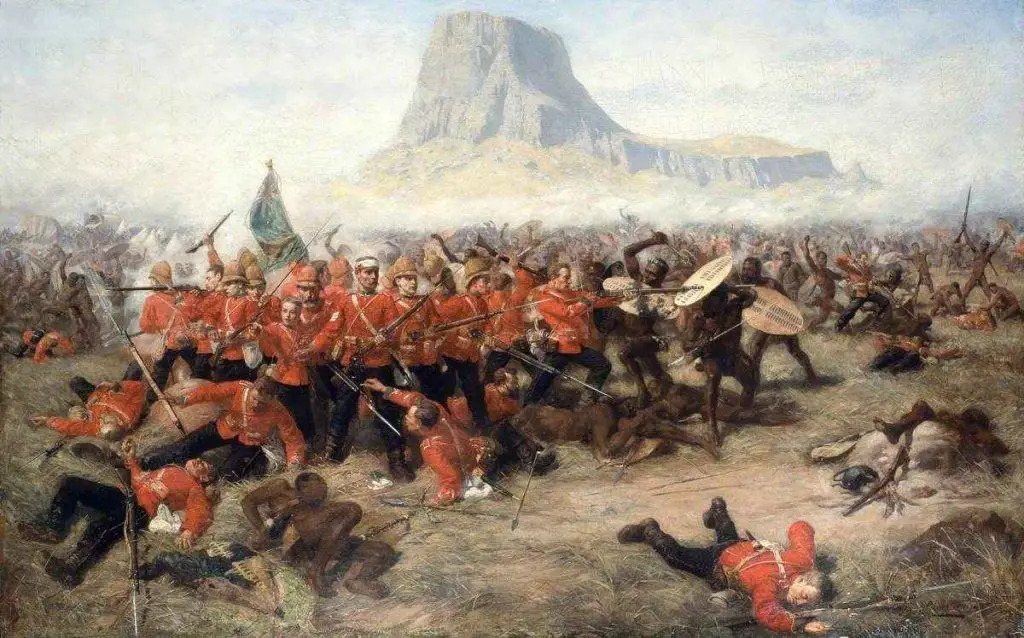
The Last Stand at Isandlwana (Charles Edwin Fripp) (Wiki Image).
Ten notable quotes:
The Battle of Isandlwana (January 22, 1879) was pivotal during the Anglo-Zulu War, where Zulu forces achieved a decisive victory against the British Army. The following quotes capture the intensity, shock, and impact of this battle:
- King Cetshwayo kaMpande, leader of the Zulus, upon hearing of the victory:
“Take nothing that is not yours. When you kill, you must not mutilate the bodies of the dead.”
This reflects his disciplined and principled approach to warfare, even in victory. - British Lieutenant Colonel Henry Pulleine, in his final orders to his men:
“Stay where you are and defend your positions.”
Pulleine’s last command epitomizes the desperate defense the outnumbered British forces attempted. - Zulu warrior, on the battle’s unexpected outcome:
“We could hardly believe the British would be so easy to defeat.”
This conveys the surprise felt by the Zulu warriors after overcoming the British, who were considered formidable. - Sir Bartle Frere, British High Commissioner in South Africa:
“The disaster at Isandlwana was one of the most humiliating defeats ever suffered by a British army.”
Frere’s reflection highlights the scale of the defeat and its blow to British pride. - Lord Chelmsford, British commander, upon discovering the extent of the loss:
“I shall not forget this day. It is a day of humiliation and sorrow.”
Chelmsford’s realization of the disaster shows his personal and military devastation. - Zulu Commander Ntshingwayo kaMahole, recounting the strategy:
“We came like the wind, and they could not stop us.”
This quote expresses the speed and tactical brilliance of the Zulu army in overwhelming the British. - British soldier, a survivor of the battle:
“The sky was black with spears… I could see no way out. It was death all around.”
This vivid account captures the overwhelming ferocity of the Zulu attack. - Frederic Thesiger, 2nd Baron Chelmsford, reflecting after the battle:
“I underestimated the Zulus… We must never again take them lightly.”
This shows the realization that the British severely underestimated the Zulu military capabilities. - Zulu impi warrior, reflecting on the aftermath:
“The ground was soaked with their blood, and still, we pushed forward.”
This evokes the determination and sacrifice of the Zulu fighters during the battle. - British soldier’s letter to his family:
“We fought as best we could, but they kept coming. The end was inevitable.”
A poignant reflection on the hopelessness of the British position during the battle’s final moments.
Casualties
| Force | Commander | Men (estimated) | Killed | Wounded | Prisoners |
| British Army | Lt. Col. Henry Pulleine | 1,800 | ~1,300 | ~50 | Few |
| Zulu Army | Ntshingwayo kaMahole Khoza | 20,000 | ~1,000 – 2,000 | Unknown | None |
Export to Sheets
The Battle of Isandlwana: From above
The Battle of Isandlwana | Zulus Vs British | Total War …
The Battle of Isandlwana: One of The Worst Defeats of The …
(YouTube video)
The Battle of Isandlwana, fought on January 22, 1879, during the Anglo-Zulu War, is one of the most significant military engagements between British colonial forces and the Zulu Kingdom. It is particularly noted for the catastrophic defeat of British troops, which marked a turning point in the conflict and had lasting implications for British imperial ambitions in southern Africa.
Background
The battle occurred in the context of British colonial expansion and the desire to assert control over the Zulu Kingdom, which was seen as a significant obstacle to British dominance in southern Africa. The British sought to annex Zululand following tensions over border disputes and the Zulu refusal to accept British authority. The Anglo-Zulu War was declared in January 1879, with the British government underestimating the military capabilities and resolve of the Zulu warriors.
The Forces Involved
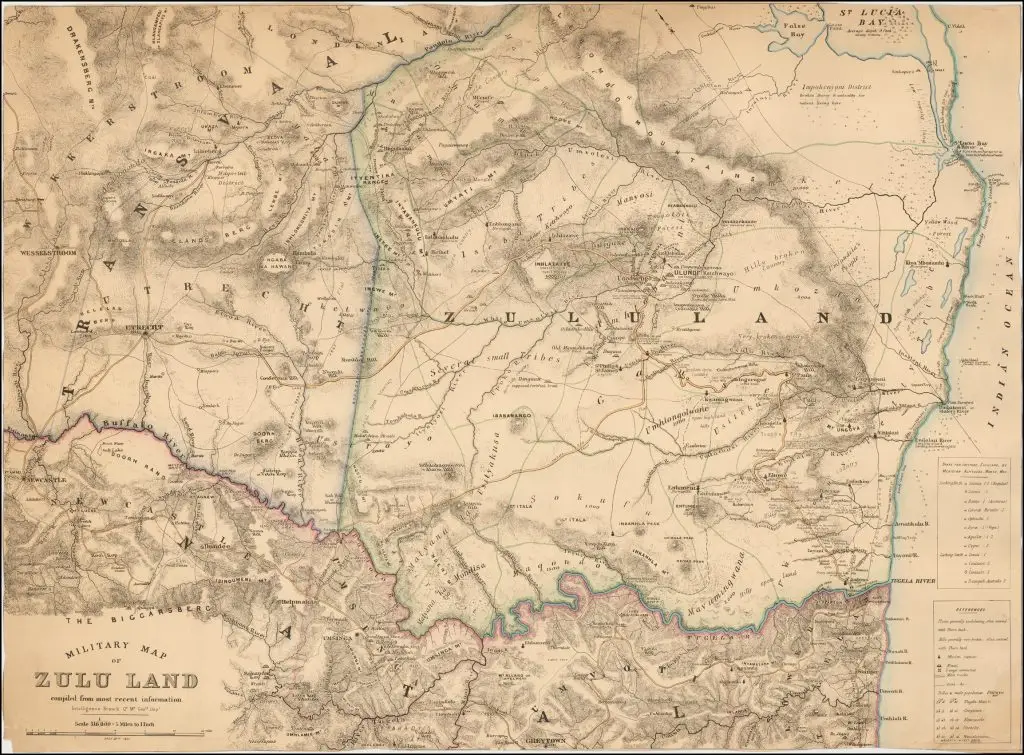
British Army, “Military Map of Zulu Land,” 1879. Rorke’s Drift converges the red, green, and blue border lines, and Islandlwana is slightly to the right (Wiki Image).
At Isandlwana, the British forces comprised approximately 1,800 troops, including regular soldiers, colonial infantry, and auxiliaries. Lieutenant Colonel Henry Pulleine led them. In contrast, the Zulu forces, estimated to be between 20,000 and 30,000 warriors, were commanded by Chief Cetshwayo and utilized traditional warfare tactics. The Zulu army was organized into regiments, with experienced fighters trained in combat who possessed a deep understanding of their terrain.
The Lead-Up to Battle
Before the engagement, British intelligence failed to assess the size and readiness of the Zulu forces adequately. British scouts reported Zulu sightings on January 22, but the warning was not taken seriously. The British forces established their camp on a hill near the Isandlwana River, believing they were safe from attack. However, they did not adequately fortify their position or prepare for a potential Zulu assault.
The Attack
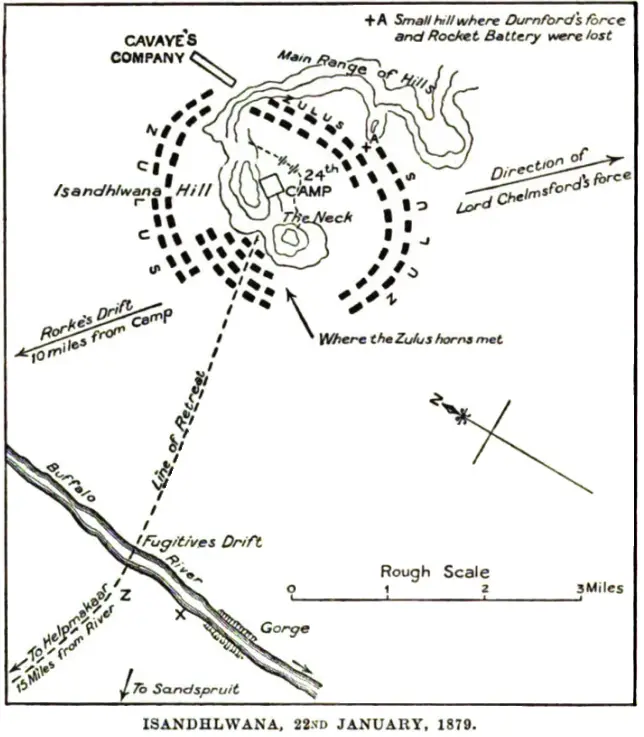
Drawing of the Battle of Isandlwana, by General Sir Horace Smith-Dorrien (1925) (Wiki Image).
Around midday, the Zulu army launched a surprise attack on the British camp. Utilizing a combination of speed and stealth, the Zulu warriors advanced in large formations, encircling the British position. The British forces were initially taken by surprise. As the Zulu warriors charged, they encountered a level of resistance that would soon falter under the overwhelming numbers of the attackers. The battle became chaotic as British soldiers struggled to maintain formation while facing fierce close-quarters combat.
The Collapse of British Defenses
The British defenses began to collapse as the Zulu forces pressed their advantage. With unprepared artillery pieces and infantry units fragmented, British troops were outflanked and outnumbered. The Zulu utilized their traditional fighting tactics, including the “horns of the buffalo” formation, effectively surrounding and overwhelming the British soldiers. By the end of the day, the British forces suffered catastrophic losses, with around 1,300 men killed, while the Zulu casualties were significantly lower.
Aftermath and Consequences
The defeat at Isandlwana sent shockwaves through the British Empire and led to a reevaluation of military strategy in the region. It was one of the most significant defeats for the British in their colonial campaigns and temporarily halted their advance into Zulu territory. In response to the loss, the British government dispatched reinforcements. It launched a campaign to regain control, culminating in the eventual British victory at the Battle of Ulundi later that year.
Historical Significance
The Battle of Isandlwana has been remembered as a symbol of Zulu’s bravery and resilience against colonial forces. It highlighted the limitations of British military strategy and the complexities of fighting against indigenous armies with deep knowledge of their terrain and combat tactics. The battle is also significant for its impact on British public opinion regarding the war and the portrayal of colonial conflicts in subsequent historical narratives.
Conclusion
The Battle of Isandlwana remains a pivotal moment in the history of the Anglo-Zulu War and British colonialism in southern Africa. It serves as a reminder of warfare’s unpredictability and the importance of respecting Indigenous forces’ capabilities. The battle’s legacy continues to resonate, reflecting the ongoing dialogue about colonialism, resistance, and the complexities of historical memory.
Battle of Tannenberg (1914, East Prussia)
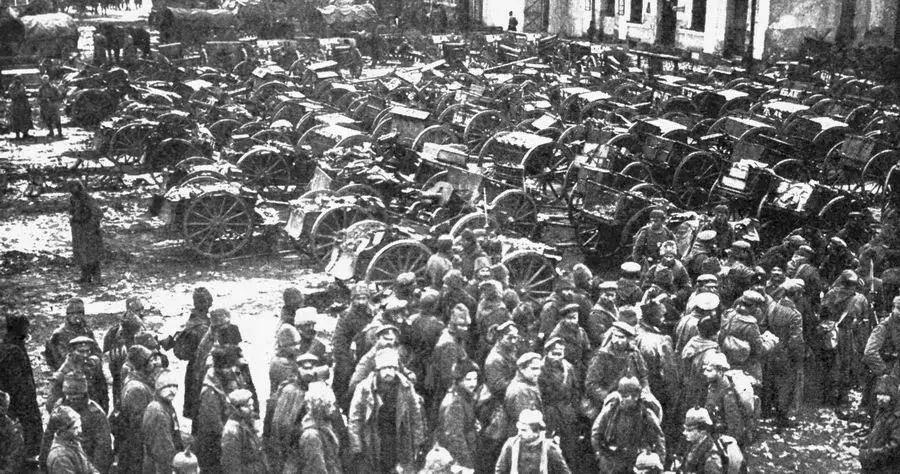
Russian prisoners of war after the battle (Wiki Image).
Ten notable quotes:
Here are ten notable quotes about the Battle of Tannenberg (1914, East Prussia):
- Paul von Hindenburg (German Commander):
- “At Tannenberg, we annihilated an entire army. It was a victory which will remain famous in the history of this war and in the annals of Germany.”
- Erich Ludendorff (German Chief of Staff):
- “The destruction of the Russian Army was complete. We had regained the initiative, and the Tannenberg victory opened the path for further advances.”
- Alexander Samsonov (Russian Commander):
- “I must die.” (Reported last words before his suicide following the defeat.)
- Winston Churchill (British Statesman):
- “The Battle of Tannenberg was to prove one of the most devastating defeats of the war, shaping the course of the Eastern Front for years to come.”
- Max Hoffmann (German Officer):
- “The Russians had practically thrown themselves into our arms. They walked right into the trap.”
- General Francois (German Officer):
- “It was a masterpiece of military art, orchestrated through perfect coordination and with an understanding of terrain, communication, and timing.”
- Anonymous Russian Soldier:
- “We marched forward, but our legs felt heavier with every step. We were lost, in the forests, in our thoughts.”
- Sir John Keegan (Military Historian):
- “Tannenberg was the most spectacular and complete German victory of the First World War, erasing the shame of earlier defeats at the hands of the Russians.”
- Richard Hovannisian (Historian):
- “The battle of Tannenberg was more than a victory; it became a symbol of German military prowess and resilience.”
- German Official Report:
- “The Russian Army ceased to exist as an organized force. The victory was absolute and decisive.”
Casualties
| Side | Forces Engaged | Casualties | Prisoners |
| Germany | 166,000 | 13,873 | N/A |
| Russia | 206,000 | ~78,000 (killed or wounded) | 92,000 (captured) |
The Battle Of Tannenberg (WWI)
The Battle of Tannenberg (1914) – How Russia was Crushed …
1914-19 Battle of Tannenberg August 26th 1914
(YouTube video)
The Battle of Tannenberg was fought between August 26 and August 30, 1914, in East Prussia during the early weeks of World War I. It was a pivotal battle on the Eastern Front, marking a decisive victory for the German Empire over the invading Russian forces. The battle is notable for the scale of Russian losses and the strategic brilliance of German commanders Paul von Hindenburg and Erich Ludendorff. It also cemented their reputations as military leaders and significantly affected the war in the East.
Background and Strategic Context
At the outset of World War I, Russia, as part of the Entente powers, launched an offensive against Germany to relieve pressure on the Western Front. The Russian Empire planned to invade East Prussia with two armies: the First Army, under General Paul von Rennenkampf, and the Second Army, commanded by General Alexander Samsonov. Adhering to the Schlieffen Plan, Germany had concentrated most of its forces on the Western Front against France, leaving only the Eighth Army under General Maximilian von Prittwitz to defend East Prussia—the Russian strategy aimed to overrun this region, which was seen as a vulnerable flank.
Russian Offensive and Initial Movements

Movements of 23–26 August 1914, with Germans in red and Russians in blue (Wiki Image).
The Russian offensive began in mid-August, with Rennenkampf’s First Army defeating a smaller German force at the Battle of Gumbinnen on August 20. However, the two Russian armies were not well-coordinated. Rennenkampf’s army moved slowly, and communication between the Russian commanders was poor. Samsonov’s Second Army, advancing from the south, was separated from Rennenkampf by a wide gap, leaving it vulnerable to isolation. This lack of coordination set the stage for the German counterattack.
Hindenburg and Ludendorff Take Command
In response to the Russian invasion, the German high command replaced General Prittwitz with General Paul von Hindenburg, a retired officer, and his chief of staff, Erich Ludendorff. Upon arriving, they devised a daring plan to encircle Samsonov’s Second Army by exploiting the gap between the Russian forces. Using intercepted Russian radio transmissions, which were sent without encryption, the Germans clearly understood the Russian positions and intentions. Hindenburg and Ludendorff decided to engage Samsonov’s isolated army before it could link up with Rennenkampf.
Encirclement and Destruction of the Russian Second Army
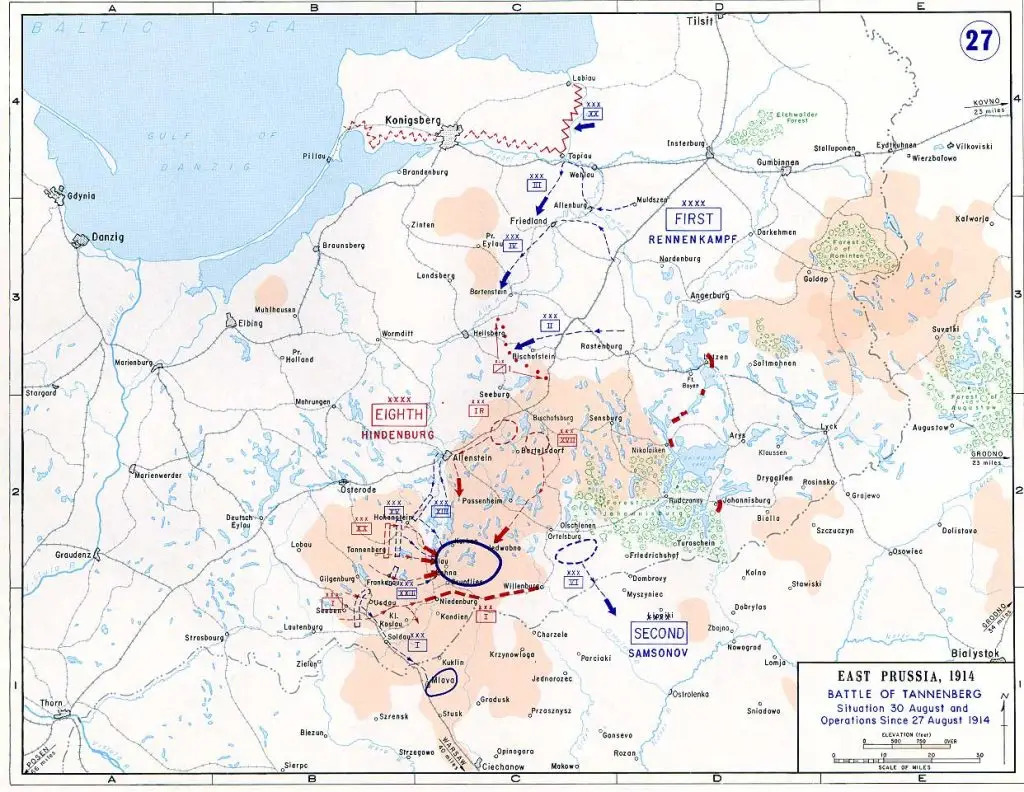
Movements of 27–30 August (Wiki Image).
The Germans quickly redeployed their forces using East Prussia’s efficient railway network, catching Samsonov’s Second Army off-guard. By August 26, the Germans engaged the Russians at the village of Tannenberg. Despite being outnumbered, the German Eighth Army executed a brilliant double envelopment, surrounding Samsonov’s forces on three sides. Over the next few days, the Russians, lacking proper supplies and cut off from reinforcements, were systematically crushed. By August 30, the encirclement was complete, and the bulk of the Russian Second Army was destroyed.
Samsonov’s Despair and Death
The Russian Second Army suffered devastating losses, with around 50,000 men killed and 90,000 taken prisoner. General Samsonov, overwhelmed by the scale of the disaster, wandered into the woods after the defeat and committed suicide on August 29, unable to face the humiliation of the defeat. His death became symbolic of the catastrophic failure of Russian command and coordination during the battle. Rennenkampf’s First Army, meanwhile, failed to advance in time to relieve Samsonov’s forces, allowing the Germans to focus all their attention on the isolated Second Army.
German Victory and Aftermath
The victory at Tannenberg was a massive morale boost for Germany, especially in light of the grim situation on the Western Front. The Germans suffered around 13,000 casualties, a fraction of the Russian losses. Hindenburg and Ludendorff were hailed as national heroes, and the victory secured East Prussia, temporarily halting the Russian advance. Although the Germans did not have enough forces to launch a full counteroffensive into Russia, the Battle of Tannenberg reshaped the Eastern Front and put the Russians on the defensive.
Long-Term Consequences
While the Battle of Tannenberg was a significant victory for Germany, it did not decisively change the overall course of the war. Though humiliated, the Eastern Front remained active, and the Russian Empire continued to fight for several more years. The battle, however, had lasting psychological and symbolic significance. It destroyed much of the Russian Second Army, weakened Russian morale, and exposed severe flaws in Russian military strategy. It also cemented Hindenburg and Ludendorff’s positions as key military figures, eventually leading them to more prominent roles in the war effort.
Legacy of Tannenberg
The Battle of Tannenberg is often considered one of the most remarkable German victories of World War I. It demonstrated the effectiveness of modern warfare tactics, such as railways for rapid troop movements and the interception of enemy communications. The battle also had deep historical resonance for the Germans. It was fought near the 1410 Battle of Grunwald (Tannenberg) site, where the Teutonic Knights suffered a significant defeat. In contrast, the 1914 battle was framed as a triumph, with Hindenburg’s victory restoring German pride and military prestige.
Battle of France (1940, France)
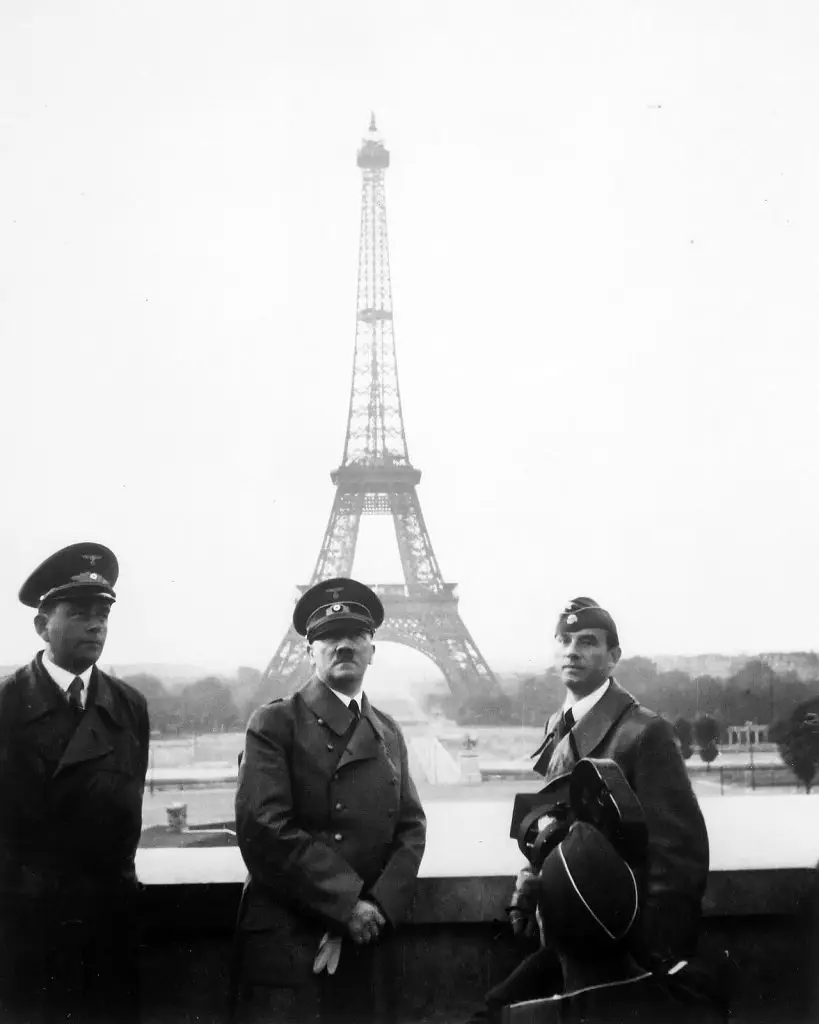
Hitler tours Paris with architect Albert Speer (left) and sculptor Arno Breker (right), 23 June 1940 (Wiki Image).
Ten notable quotes:
- Winston Churchill:
“The Battle of France is over. I expect that the Battle of Britain is about to begin.”
(In a speech to the House of Commons on June 18, 1940, following the fall of France.) - General Charles de Gaulle:
“France has lost a battle. But France has not lost the war.”
(From his famous radio address to the French people from London on June 18, 1940.) - Adolf Hitler:
“The war is won in the West. Now, we turn our attention to England.”
(Comment made after the successful conclusion of the French campaign.) - Marshal Philippe Pétain:
“It is with a heavy heart that I tell you today we must cease fighting.”
(From his speech announcing the French government’s request for an armistice on June 17, 1940.) - Winston Churchill:
“We shall go on to the end, we shall fight in France, we shall fight on the seas and oceans, we shall fight with growing confidence and growing strength in the air.”
(From his famous “We shall fight on the beaches” speech, June 4, 1940, after the Dunkirk evacuation.) - General Heinz Guderian:
“Manstein’s plan succeeded brilliantly. I am only a small cog in the machine of Blitzkrieg, but we played our part.”
(Reflecting on the German breakthrough in the Ardennes during the battle.) - French Prime Minister Paul Reynaud:
“We are beaten; we have lost the battle.”
(In a letter to Winston Churchill on June 13, 1940, as French defenses crumbled.) - Adolf Hitler:
“The armistice will be signed in Compiègne. It will be a perfect symbol of our victory.”
(Referring to the symbolic choice of the railway car at Compiègne, where Germany signed the 1918 armistice in defeat.) - Field Marshal Erwin Rommel:
“The French campaign is the most glorious in history. We have gained a hundredfold with only a fraction of the forces.”
(Rommel’s assessment of the lightning-fast German victory over France.) - General Maxime Weygand:
“The enemy broke through our lines like a knife through butter.”
(On the stunning effectiveness of the German Blitzkrieg tactics in France.)
Casualties
| Category | Allies | Axis |
| Forces | ||
| Total Personnel | ~3,300,000 (France, UK, Belgium, Netherlands, Poland) | ~2,450,000 (Germany, Italy) |
| Divisions | 136 (France, UK, Belgium, Netherlands) | 157 (Germany) |
| Tanks | ~3,383 (France, UK, Belgium, Netherlands) | ~2,445 (Germany) |
| Aircraft | ~4,360 (France, UK, Belgium, Netherlands) | ~3,270 (Germany) |
| Casualties | ||
| Killed & Missing | ~160,000 (France), ~68,000 (UK), ~2,000 (Belgium), ~1,000 (Netherlands) | ~27,074 (Germany) |
| Wounded | ~250,000 (France), ~192,000 (UK) | ~111,034 (Germany) |
| Prisoners | ~1,800,000 (France), ~65,000 (UK), ~22,000 (Belgium), ~9,000 (Netherlands) | ~1,200 (Germany) (mostly paratroopers) |
| Equipment Losses | ||
| Tanks | ~1,800 (France), ~400 (UK) | ~600-1,000 (Germany) |
| Aircraft | ~1,274 (France), ~959 (UK) | ~1,636 (Germany) |
| Ships | ||
| Major warships | 26 (Allied) | 10 (German) |
Export to Sheets
Battlefield S1/E1 – The Battle of France
038 – Blitzkrieg in the West – The Invasion of France – WW2 …
Battle of France in 44 seconds
(YouTube video)
The Battle of France (May 10 – June 25, 1940) was the German invasion of France and the Low Countries during World War II, resulting in one of the most decisive military campaigns in history. This battle demonstrated the effectiveness of the German Blitzkrieg (“lightning war”) strategy and ended with the fall of France, fundamentally altering the course of the war.
Background and Strategic Context
Following the German invasion of Poland in 1939 and the subsequent declaration of war by Britain and France, the Western Front remained largely inactive for several months, a period often referred to as the “Phoney War.” Both sides prepared for an eventual confrontation. However, French and British forces, assuming that Germany would attempt a direct attack through Belgium (as in World War I), heavily fortified the Maginot Line along the French-German border. Meanwhile, Germany’s Manstein Plan aimed to bypass these defenses and strike through the Ardennes, a region the Allies believed to be impassable for a large army.
German Blitzkrieg Strategy

Map of German panzer divisions attacking The Netherlands, Belgium and France, May 1940 (Wiki Image).
The German invasion began on May 10, 1940, with a coordinated attack on the Netherlands, Belgium, and Luxembourg to draw Allied forces northwards. While the Allies rushed to meet the Germans in Belgium, the main thrust of the German attack came through the Ardennes forest, catching the Allies off guard. Panzer divisions, led by General Heinz Guderian, swiftly advanced through the weakly defended region, crossing the Meuse River and breaking through the French defenses at Sedan on May 13. This breakthrough allowed German forces to rapidly push westward, encircling the bulk of the Allied forces in northern France and Belgium.
Fall of the Low Countries
The Netherlands and Belgium were attacked first as part of the German plan to divert Allied attention. Despite fierce resistance, the Dutch forces were overwhelmed by German paratroopers and air raids, notably the devastating bombing of Rotterdam on May 14, which forced the Netherlands to surrender. Belgium fared slightly better but was also forced to capitulate by the end of May, with German forces advancing quickly and encircling British and French troops to the north.
Dunkirk Evacuation
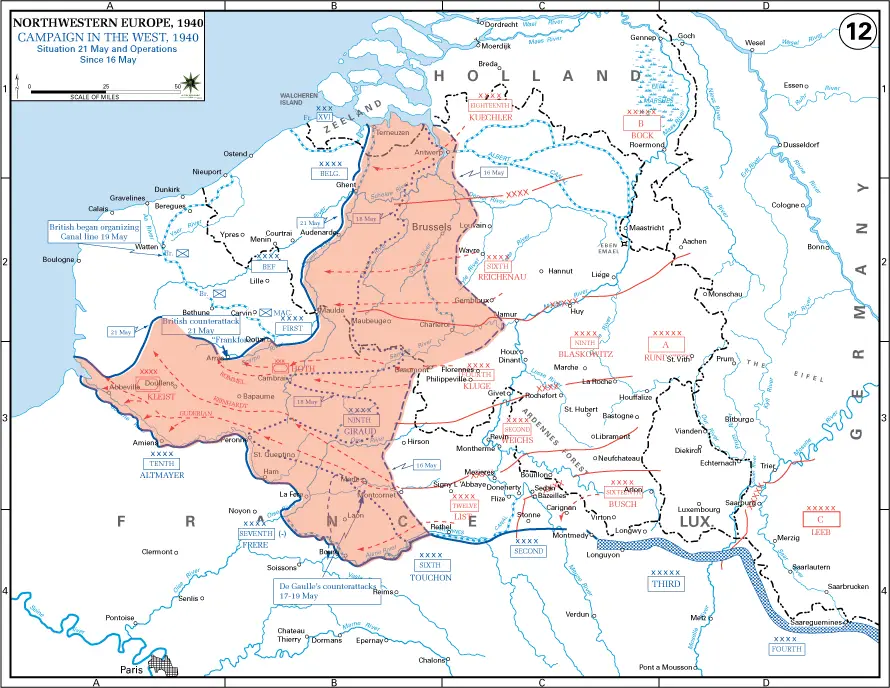
The German advance up to 21 May 1940 (Wiki Image).
As the German forces encircled the Allied armies in northern France, they pushed them toward the coast, trapping the British Expeditionary Force (BEF), along with French and Belgian troops, near Dunkirk. Recognizing the dire situation, the British launched Operation Dynamo, a massive evacuation effort from May 26 to June 4, 1940. Despite being under constant attack from the German Luftwaffe, over 330,000 Allied troops were successfully evacuated across the English Channel to Britain. While a significant portion of the army was saved, most of their heavy equipment was left behind, and the operation was a retreat rather than a victory.
The Fall of Paris
With the northern flank devastated and the BEF evacuated, France faced collapse. German forces continued their rapid advance southward, bypassing the Maginot Line and taking advantage of their superior mobility and coordination. On June 10, the French government fled Paris, declaring it an open city to avoid its destruction. German forces entered the French capital on June 14, further demoralizing the French resistance. By this point, the French military was in disarray, and any hope of a counterattack had evaporated.
French Surrender
Faced with the overwhelming strength of the German forces, the French government, led by Marshal Philippe Pétain, sought an armistice. On June 22, 1940, France officially surrendered to Germany. The armistice was signed in the same railway carriage in Compiègne, where Germany had surrendered in World War I, a symbolic moment that humiliated the French. Under the terms of the armistice, France was divided into two zones: the northern part, including Paris, was occupied by the Germans, while the southern part, known as Vichy France, remained nominally independent but collaborated with the Nazis.
The Role of Airpower
The Battle of France highlighted the importance of air superiority. The German Luftwaffe was crucial in supporting ground forces by providing close air support and disrupting Allied supply lines. Although not insignificant, the Germans outclassed the French and British air forces in terms of both numbers and tactics. The Luftwaffe’s dominance in the skies contributed to the speed and effectiveness of the German Blitzkrieg, allowing for rapid advances and overwhelming Allied forces before they could regroup.
Aftermath and Consequences
The defeat of France shocked the world and marked a dramatic turning point in World War II. With the fall of France, Germany solidified its control over Western Europe, leaving Britain to stand alone against the Axis powers. The swift and decisive nature of the German victory shattered the myth of French military superiority and exposed weaknesses in Allied strategy and coordination. The Battle of France also led to the rise of Charles de Gaulle, who fled to Britain and became the leader of the Free French forces. For Germany, the victory emboldened Hitler’s ambitions, leading him to pursue further expansion in Eastern Europe and ultimately to the invasion of the Soviet Union in 1941.
Battle of Stalingrad (1942-1943, Russia)
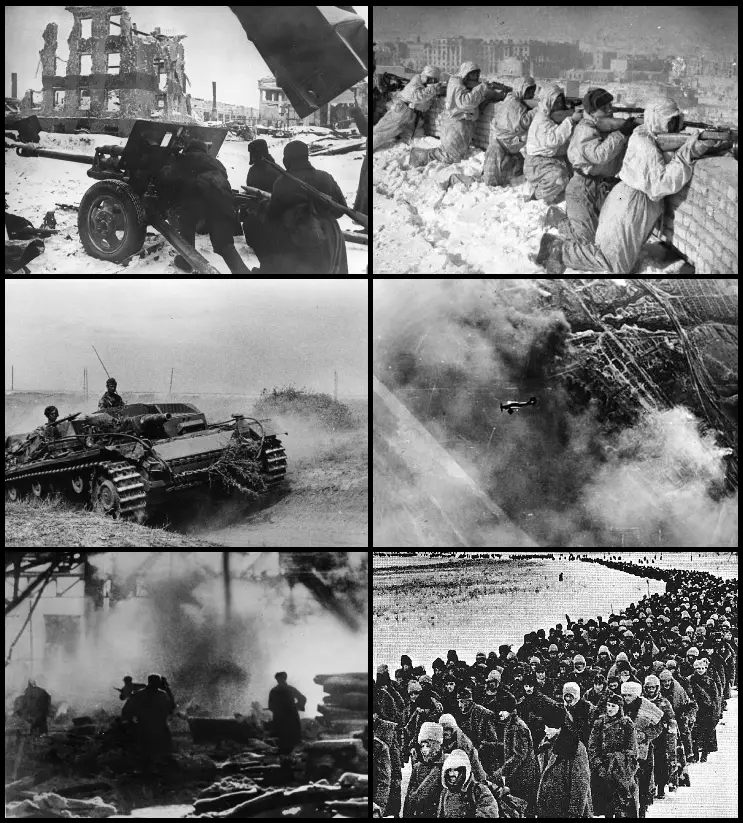 Top to bottom, left to right:
Top to bottom, left to right:
- 76.2 mm ZiS-3 field gun, operated by the Soviet Red Army
- Soviet soldiers fighting on the roof of a house
- Ju 87 of the German Luftwaffe after a dive bombing
- Axis prisoners of war (Germans, Italians, Romanians, Hungarians)
- Soviet troops fighting in a destroyed workshop
- Sturmgeschütz III, operated by the German Wehrmacht
- Wiki Image
Ten notable quotes:
The Battle of Stalingrad is remembered not only for its scale and brutality but also for the countless personal stories that arose from it. The following quotes capture the desperation, courage, and devastation experienced by those involved.
- General Vasily Chuikov, Soviet commander at Stalingrad, famously said:
“There is no land for us beyond the Volga.”
These words reflected the Soviet defenders’ determination to hold their ground, no matter the cost. - A German officer, writing in his diary as the battle turned against the Axis, lamented:
“We are no longer living but being dragged into death.”
This bleak sentiment illustrated the sense of hopelessness that gripped German soldiers as they faced encirclement and starvation. - Adolf Hitler, stubborn in his refusal to allow retreat, declared:
“Surrender is forbidden. The 6th Army will hold their positions to the last man and the last bullet.”
His insistence on no retreat sealed the fate of thousands of soldiers trapped in the city. - Field Marshal Friedrich Paulus, commander of the German 6th Army, after his surrender:
“I have no intention of shooting myself for this Bohemian corporal.”
By referring to Hitler in this derogatory manner, Paulus expressed his disillusionment with the Nazi leadership. - A Soviet soldier recalled the grueling urban warfare:
“It was not a city any longer. It was a vast furnace, a giant torch. Only the dead were still there.”
His description captures the apocalyptic landscape of the ruined city. - From the diary of a German soldier, reflecting the harsh winter conditions:
“The cold is unbearable. We’re running out of food and ammunition. There is no hope.”
This encapsulated the suffering of the encircled German troops. - Joseph Stalin, in his directive to his commanders:
“Not a step back! This is the hour of our greatest challenge.”
His famous order underscored the political and symbolic significance of holding Stalingrad. - Soviet pilot Nikolai Gerasimovich recounts his perilous missions to supply the defenders:
“Flying over the Volga was like threading a needle through fire. But we had to bring them what they needed—hope, ammunition, and sometimes a letter from home.” - A German private, surrounded by death and defeat, wrote in a letter home:
“Mother, if you get this, know that I did my duty. The end is near, but I will see you again in a better place.”
His words offer a haunting farewell, knowing the hopeless situation. - Soviet journalist Vasily Grossman, witnessing the turning tide of battle, observed:
“The Germans came as conquerors, and now they leave as shadows, broken and beaten.”
This quote captures the reversal of fortune and the immense cost of the German defeat.
Casualties
| Category | Axis | Soviet Union |
| Forces | ||
| Total Personnel | ~1,040,000 (Peak Strength, including German, Romanian, Italian, Hungarian, and Croatian forces) | ~1,143,000 (Peak Strength) |
| Divisions | ~270 (Throughout the battle) | ~300 (Throughout the struggle) |
| Tanks | ~600 (Initial) | ~400 (Initial) |
| Aircraft | ~1,200 (Peak Strength) | ~1,000 (Peak Strength) |
| Casualties | ||
| Killed & Missing | ~400,000 – 850,000 (Includes all Axis forces) | ~478,000 – 1,100,000+ |
| Wounded | ~650,000 (Includes all Axis forces) | ~1,677,000+ |
| Prisoners | ~91,000 (Primarily Germans) | ~107,800 |
| Equipment Losses | ||
| Tanks | ~1,500 | ~4,341 |
| Aircraft | ~900 | ~2,769 |
Export to Sheets
The Battle of Stalingrad was doomed from the start, and here’s …
The Battle of Stalingrad: Jul 1942 – Feb 1943 | World War II …
Battle of Stalingrad 1942-1943 – World War II DOCUMENTARY
(YouTube video)
The Battle of Stalingrad (August 23, 1942 – February 2, 1943) was one of the largest and bloodiest battles in history, marking a critical turning point in World War II. Fought between Nazi Germany and its Axis allies against the Soviet Union for control of the city of Stalingrad (now Volgograd) in southern Russia, the battle resulted in a devastating defeat for Germany. It significantly altered the course of the war on the Eastern Front.
Strategic Importance
Stalingrad was a key industrial city located on the western bank of the Volga River and held strategic importance for both sides. For Adolf Hitler, capturing Stalingrad was essential for two reasons: it was a symbolic victory as the city bore the name of Soviet leader Joseph Stalin, and it was a gateway to the oil-rich Caucasus region, which Germany desperately needed for its war machine. Conversely, Stalin viewed the city’s defense as a matter of national pride and survival, and he ordered the city to be held at all costs.
The German Offensive
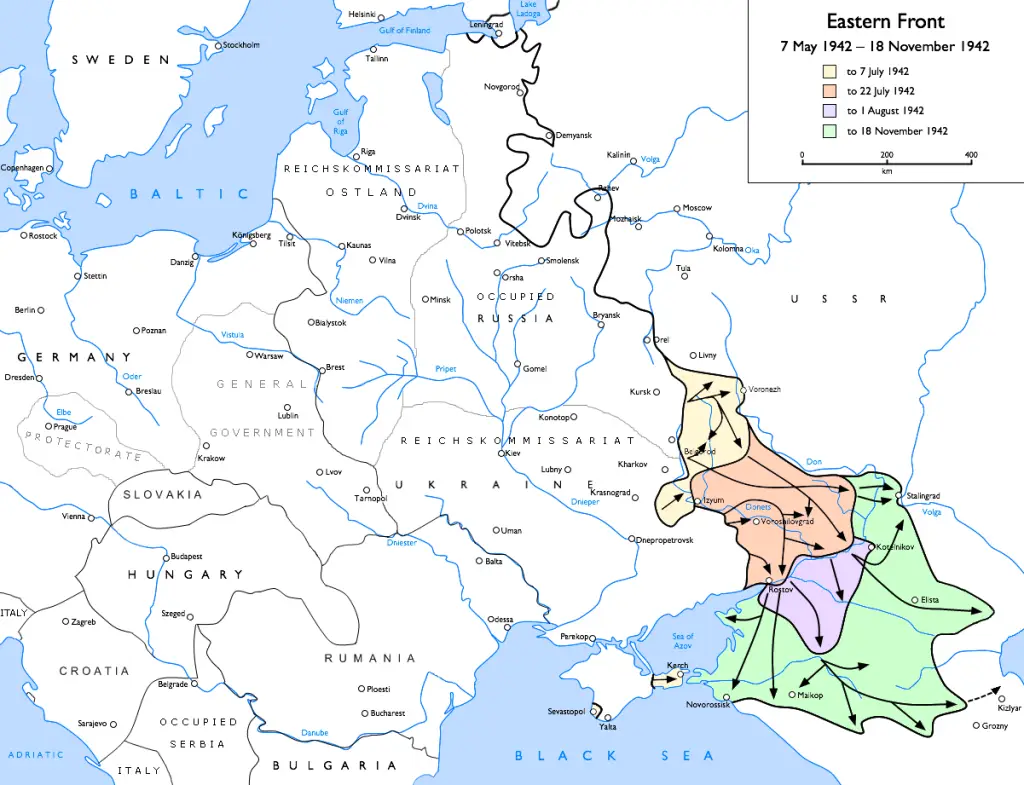
(Wiki Image).
The German offensive, codenamed Operation Blau, began in the summer of 1942. Hitler diverted a significant portion of his forces to the southern front, focusing on taking the Caucasus oil fields. The 6th Army, commanded by General Friedrich Paulus, was tasked with capturing Stalingrad, supported by the 4th Panzer Army elements. The Germans rapidly progressed, pushing Soviet forces back toward the Volga River.
In August 1942, German bombers reduced much of the city to rubble. The Luftwaffe’s air superiority allowed them to carry out devastating air raids, turning Stalingrad into a vast, desolate battlefield. However, the city’s destruction did not hinder Soviet resistance but instead provided them with defensive strongholds amid the ruins.
Urban Warfare and Soviet Resistance
The Battle of Stalingrad soon degenerated into brutal urban combat. The Germans expected to capture the city quickly. Still, the Soviet defenders, under General Vasily Chuikov, adopted a “hugging” tactic, engaging the Germans at close quarters to negate their artillery and air support. The fighting occurred street by street, building by building, often with hand-to-hand combat in factories, apartment blocks, and even sewers. The battle became known for its ferocity and the high casualties.
Despite being outnumbered and outgunned, Soviet forces held on, bolstered by reinforcements from across the country. The Volga River was a crucial lifeline, allowing supplies and reinforcements to reach the city, even as German artillery tried to cut off access.
Operation Uranus: The Soviet Counteroffensive
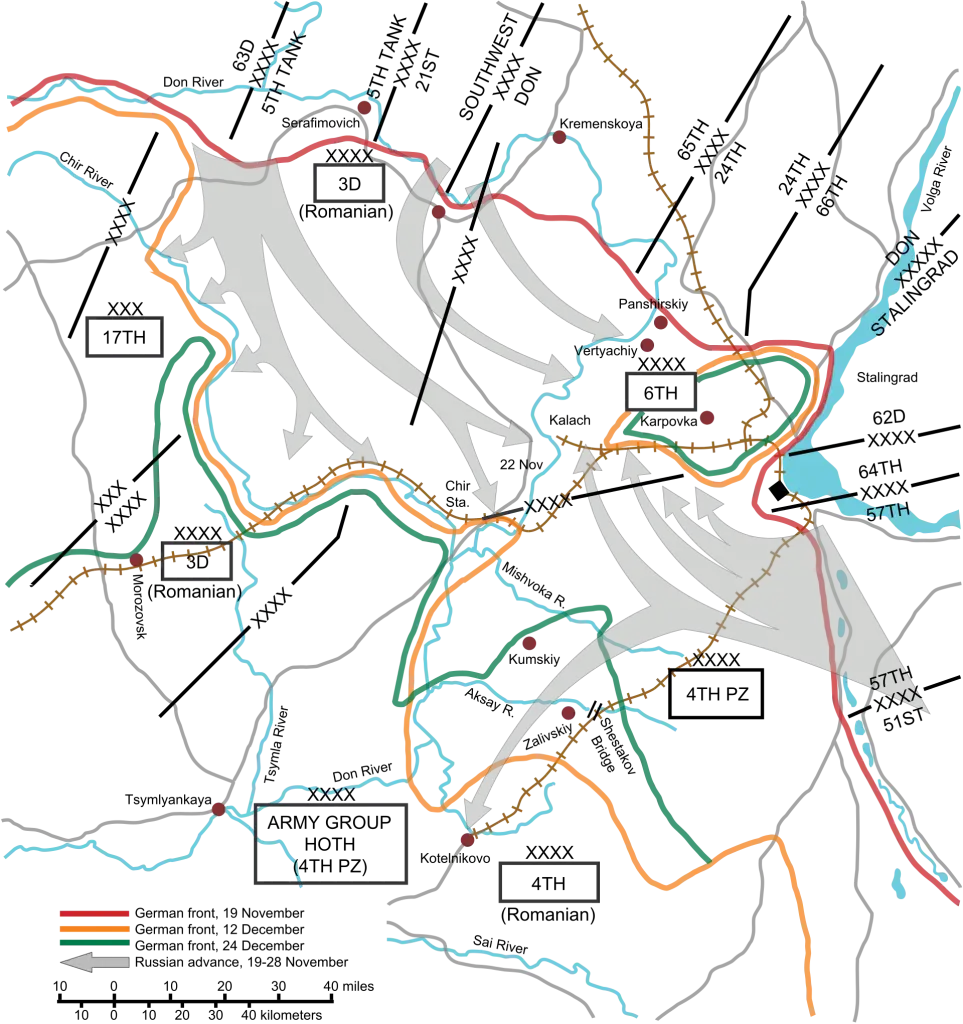
The Soviet counter-attack at Stalingrad (Wiki Image).
In November 1942, the Soviets launched a massive counteroffensive known as Operation Uranus. Instead of attacking the heavily fortified German positions inside the city, the Soviet plan involved encircling the German 6th Army by attacking the weaker Romanian, Hungarian, and Italian units guarding the flanks of the German forces. The plan was brilliantly executed, and within days, the Soviet forces had encircled Stalingrad, trapping around 300,000 Axis troops inside.
The encirclement shocked the German High Command. Hitler ordered Paulus to hold the city and refused any attempts at retreat, promising that the Luftwaffe would resupply the encircled forces by air. However, the airlift effort failed, as the Luftwaffe could not deliver the required supplies due to the harsh winter conditions and Soviet air defenses.
The German Collapse and Surrender
As winter set in, conditions inside the German pocket deteriorated rapidly. Soldiers faced extreme cold, starvation, disease, and relentless Soviet attacks. Morale plummeted, and many Axis soldiers died from exposure and malnutrition. The once-formidable 6th Army was reduced to a fraction of its strength, with Paulus unable to mount any meaningful counteroffensive.
In late January 1943, the situation became untenable for the Germans. Soviet forces tightened the noose around Stalingrad, pushing deeper into the city. On January 31, 1943, Paulus, who had been promoted to Field Marshal (in a symbolic attempt by Hitler to prevent him from surrendering, as no German Field Marshal had ever been captured alive), surrendered to the Soviets. The remaining German forces surrendered on February 2, 1943.
Casualties and Aftermath
The Battle of Stalingrad was one of the deadliest battles in history, with estimates of total casualties ranging from 1.8 million to 2 million. The Axis forces suffered around 800,000 casualties, including killed, wounded, and captured. The Soviet Union also paid a high price, with more than 1 million soldiers and civilians killed or wounded. The scale of destruction in Stalingrad was immense, with much of the city reduced to rubble.
The Soviet victory at Stalingrad marked the beginning of a series of successful Soviet offensives that would eventually lead to the liberation of Eastern Europe and the defeat of Nazi Germany. The battle was a psychological blow to Hitler and the Nazi regime, shattering the myth of the invincibility of the German army.
Strategic and Symbolic Victory
Stalingrad was a military victory and a symbolic triumph for the Soviet Union. It demonstrated the resilience and determination of the Soviet people and army, rallying them to continue the fight against the invaders. For Hitler, the loss of an entire army, coupled with his refusal to allow Paulus to retreat, was a strategic disaster from which Germany would never fully recover.
Legacy
The Battle of Stalingrad is remembered as one of the most important turning points of World War II. It changed the momentum of the war in favor of the Allies and became a symbol of Soviet resolve and heroism. The city of Stalingrad (now Volgograd) remains a site of national pride and commemoration in Russia, with numerous memorials and tributes to the soldiers who fought and died there.
Stalingrad remains an enduring reminder of the horrors of war and the devastating human cost of total conflict.
Similarities between the Sicilian Expedition (415-413 BC, Silicy), Battle of Cannae (216 BC, Italy), Teutoburg Forest (9 AD, Germany), Battle of Red Cliffs (208 AD, China), “Kamikaze” or Divine Wind (1274 & 1281, Japan), Battle of Agincourt (1415, France), Battle of Tenochtitlán (1521, Mexico), Battle of Lepanto (1571, Mediterranean), Spanish Armada (1588, England Channel), Battles of Saratoga (1777, America), Battle of Little Bighorn (1876, America), Battle of Isandlwana (1879, South Africa), Battle of Tannenberg (1914, East Prussia), Battle of France (1940, France), Battle of Stalingrad (1942-1943, Russia)
These historical battles and campaigns, ranging from ancient to modern times, share several similarities despite their geographical differences, periods, and participants. Here are some key similarities:
Catastrophic Defeats for a Major Power:
- Each of these battles or campaigns resulted in a devastating defeat for a significant power, often altering the course of history.
- Sicilian Expedition (415-413 BC): Athens’ disastrous defeat weakened its position in the Peloponnesian War.
- Battle of Cannae (216 BC): A catastrophic Roman loss, considered one of the worst in their history.
- Teutoburg Forest (9 AD): Rome’s expansion into Germany was permanently halted after this defeat.
- Spanish Armada (1588): Spain’s navy’s defeat marked its decline as a dominant world power.
- Battle of France (1940): The swift and overwhelming defeat of France by Nazi Germany shocked the world.
Key Turning Points in Larger Conflicts:
- These battles represented major turning points in larger wars or conflicts:
- Battle of Cannae: Marked the height of Hannibal’s invasion of Italy, though Rome eventually turned the tide.
- Red Cliffs (208 AD): Shifted the balance of power in the Three Kingdoms period of China, limiting Cao Cao’s expansion.
- Saratoga (1777): Turning point in the American Revolution, which led to French intervention and American victory.
- Battle of Stalingrad (1942-43): Marked the beginning of Nazi Germany’s retreat on the Eastern Front in World War II.
Underestimation of Opponents:
- In many of these battles, the losing side underestimated the abilities or resolve of their enemy:
- Teutoburg Forest: The Romans underestimated the Germanic tribes’ ability to organize an ambush.
- Agincourt (1415): The French nobles underestimated the effectiveness of the English longbowmen.
- Little Bighorn (1876): Custer greatly underestimated the strength and coordination of Native American forces.
- Isandlwana (1879): The British, confident in their firepower, underestimated the Zulu forces.
Importance of Geography and Terrain:
- The outcome of these battles was often heavily influenced by the use of terrain or geography:
- Teutoburg Forest: The dense forest allowed the Germanic tribes to effectively ambush the Roman legions.
- Red Cliffs: The Yangtze River was crucial in the naval battle.
- Agincourt: Muddy terrain made it difficult for heavily armored French knights to move, contributing to their defeat.
- Stalingrad: The urban environment of Stalingrad was crucial in the Soviets’ defense and counterattack.
Involvement of Superior Technology or Tactics:
- Many of these battles involved the use of superior technology or innovative tactics:
- Cannae: Hannibal’s double envelopment tactic is studied as one of the greatest military maneuvers.
- Red Cliffs: The Allied fire attack on Cao Cao’s fleet turned the tide in favor of the smaller force.
- Agincourt: English longbows decimated the French knights from a distance.
- Lepanto (1571): The Christian coalition’s superior galleys and naval tactics defeated the larger Ottoman fleet.
Disastrous Overreach or Overconfidence:
- Overconfidence or overextension led to many of these defeats:
- Sicilian Expedition: The Athenians overreached by sending a massive force far from home, leading to its destruction.
- Spanish Armada: The Spanish fleet was overconfident in its ability to invade England, underestimating the English navy.
- Custer at Little Bighorn: Custer’s overconfidence in his small cavalry force led to their annihilation.
- Napoleon in Russia (1812): Napoleon’s overconfidence in invading Russia led to disastrous losses due to the harsh winter and Russian tactics.
Significant Political and Social Consequences:
- These battles often had major political or social ramifications:
- Teutoburg Forest: Halted Roman expansion into Germany, shaping the future of European borders.
- Tenochtitlán (1521): The fall of the Aztec capital to the Spanish marked the beginning of European dominance in the Americas.
- Saratoga (1777): Secured French support for the American Revolution, turning the tide against Britain.
- Stalingrad: Cemented Soviet resistance, playing a major role in the eventual defeat of Nazi Germany.
Asymmetric Forces or Smaller Armies Prevailing:
- In many cases, smaller or seemingly inferior forces won against larger or more powerful enemies:
- Agincourt: The outnumbered English defeated a much larger French force.
- Red Cliffs: A smaller coalition decisively defeated Cao Cao’s larger fleet.
- Saratoga: The American rebels, while outnumbered, managed to defeat British forces.
- Stalingrad: The encircled Soviet forces prevailed against a much larger and better-equipped German army.
These battles highlight recurring themes in military history: the role of leadership, the importance of terrain and geography, the dangers of overconfidence, and how underestimating an opponent can lead to devastating losses. Each battle marked a significant shift in its respective historical context, shaping the nation’s future.
Differences between the Sicilian Expedition (415-413 BC, Silicy), Battle of Cannae (216 BC, Italy), Teutoburg Forest (9 AD, Germany), Battle of Red Cliffs (208 AD, China), “Kamikaze” or Divine Wind (1274 & 1281, Japan), Battle of Agincourt (1415, France), Battle of Tenochtitlán (1521, Mexico), Battle of Lepanto (1571, Mediterranean), Spanish Armada (1588, England Channel), Battles of Saratoga (1777, America), Battle of Little Bighorn (1876, America), Battle of Isandlwana (1879, South Africa), Battle of Tannenberg (1914, East Prussia), Battle of France (1940, France), Battle of Stalingrad (1942-1943, Russia)
The battles and military campaigns you’ve listed span different periods, regions, and contexts, leading to notable differences in strategy, technology, leadership, and outcomes. Here are some key differences between them:
Periods and Technological Contexts:
- These battles span from ancient (Sicilian Expedition, Battle of Cannae) to medieval (Battle of Agincourt, Battle of Lepanto) to modern warfare (Tannenberg, Battle of France, Stalingrad).
- Ancient battles like Cannae (216 BC) and the Sicilian Expedition (415-413 BC) involved infantry-based armies with relatively simple weaponry, while modern battles like Stalingrad (1942-43) employed tanks, aircraft, and heavy artillery.
- Naval technology also varied greatly, from the wooden triremes in the Battle of Red Cliffs (208 AD) to the galleys in Lepanto (1571) and the steel warships and submarines during the Battle of France (1940).
Nature of Combat (Land vs. Naval):
- Land battles like the Battle of Cannae (Italy), Teutoburg Forest (Germany), and Stalingrad (Russia) were fought between infantry, cavalry, and later mechanized forces.
- Naval engagements like the Battle of Red Cliffs and the Battle of Lepanto focused on controlling waterways with fleets. The Spanish Armada was another key naval engagement, where weather and naval tactics led to a decisive English victory.
- Some battles were mixed: Tenochtitlán was a siege on both water and land, with Spanish ships supporting the attack on the Aztec capital.
Tactics and Strategies:
- The Battle of Cannae is renowned for Hannibal’s strategic envelopment, one of the greatest tactical maneuvers in military history. In contrast, the Teutoburg Forest was a well-executed ambush by Germanic tribes using the dense forest to trap Roman legions.
- The Sicilian Expedition involved a prolonged siege, while the Battle of Agincourt was a decisive open-field confrontation where the English longbow played a key role.
- Red Cliffs relied on naval fire attacks and weather conditions, while battles like Stalingrad involved urban warfare, snipers, and the attrition of both Soviet and German forces.
Leadership and Command:
- Leaders like Hannibal at Cannae, Napoleon in the Russian campaign, and Cao Cao at Red Cliffs are renowned for their strategic acumen or overreach.
- The Teutoburg Forest saw a failure of Roman leadership, with Varus losing three entire legions to a Germanic coalition led by Arminius.
- In contrast, George Washington and the American commanders during the Battles of Saratoga displayed adaptability, while Custer’s leadership at Little Bighorn was marked by overconfidence and miscalculation.
- The Battle of France (1940) showcased the superiority of German Blitzkrieg tactics under commanders like Erwin Rommel, while French commanders struggled with outdated strategies.
Motivations and Contexts:
- The Sicilian Expedition was part of Athens’ imperialistic aims during the Peloponnesian War, while the Spanish Armada was driven by religious conflict (Catholic Spain vs. Protestant England) and geopolitical rivalry.
- Red Cliffs was fought during China’s Three Kingdoms period, involving complex internal power struggles, while Tenochtitlán was a conquest battle in the context of European colonialism.
- The Battles of Saratoga and Stalingrad were pivotal moments in wars of independence and global struggle (American Revolution, World War II), each critical to the future of their respective nations.
- The Kamikaze (Divine Wind) refers to natural typhoons that destroyed Mongol invasion fleets against Japan in 1274 and 1281, illustrating divine protection narratives. Other battles, such as Isandlwana and Little Bighorn, involved native forces defending against imperial expansion.
The Scale of Conflict:
- Ancient and medieval battles like Agincourt, Cannae, and Red Cliffs involved fewer troops compared to modern warfare.
- World War II battles, such as Stalingrad and the Battle of France, involved millions of troops, tanks, and aircraft, with massive logistical challenges, attrition warfare, and civilian casualties.
- The Spanish Armada and Lepanto also involved large fleets, but on a naval scale, whereas battles like Saratoga and Little Bighorn were relatively smaller engagements with fewer combatants.
Terrain and Environment:
- Teutoburg Forest and Isandlwana took place in rugged, natural environments (dense forests, open savannas), giving an advantage to forces familiar with the terrain.
- Weather conditions (the latter by mud) influenced the Sicilian Expedition, the Battle of Agincourt, and the Kamikaze winds destroyed the Mongol fleets off the coast of Japan.
- Stalingrad occurred in a heavily urban environment, where every street became a battleground. In contrast, Red Cliffs occurred on the water, and the Battle of France featured Blitzkrieg across varied terrain (forests, plains, and rivers).
Consequences:
- The consequences of these battles were vastly different. Stalingrad led to the downfall of Nazi Germany on the Eastern Front, while the Sicilian Expedition crippled Athens and led to its eventual downfall.
- The defeat of the Spanish Armada marked the rise of English naval dominance. At the same time, Tenochtitlán resulted in the collapse of the Aztec Empire and the start of Spanish colonial rule in the Americas.
- The Battle of Little Bighorn was a temporary victory for the Lakota and Northern Cheyenne, but it led to increased U.S. military campaigns and eventual Native American defeat.
- The Battle of France ended in a quick and decisive victory for Germany, leading to the occupation of France and the formation of the Vichy regime.
Involvement of External Factors (Weather, Allies):
- Weather played a critical role in several battles, such as the Divine Wind in Japan and the mud at Agincourt, which bogged down French forces.
- Alliances were crucial in battles like Saratoga, where the American victory led to French support, and Red Cliffs, where a smaller coalition managed to defeat Cao Cao’s larger fleet.
These differences highlight the varying scales of conflict, motivations, technological advancements, and leadership that shaped these battles’ outcomes and historical significance across millennia.
Here is a comparative table for the battles and military campaigns you mentioned:
| Battle/Campaign | Date | Location | Key Participants | Result/Outcome | Significance | Casualties |
| Sicilian Expedition | 415-413 BC | Sicily, Mediterranean | Athens vs. Syracuse, Sparta | Decisive defeat for Athens | Weakened Athens, a turning point in the Peloponnesian War | Athens: ~40,000 lost (men and ships) |
| Battle of Cannae | 216 BC | Cannae, Italy | Carthage (Hannibal) vs. Rome | Decisive Carthaginian victory | Hannibal’s tactical genius, one of the greatest encirclements in military history | Rome: ~50,000-70,000; Carthage: ~6,000 |
| Teutoburg Forest | 9 AD | Teutoburg Forest, Germany | Germanic tribes vs. Roman Empire | Decisive Germanic victory | Halted Roman expansion into Germany | Romans: ~20,000-25,000 |
| Battle of Red Cliffs | 208 AD | Yangtze River, China | Cao Cao vs. Liu Bei and Sun Quan | The decisive defeat of Cao Cao | Major events in the Three Kingdoms period reshaped China | Cao Cao: estimated tens of thousands of losses |
| Kamikaze (Divine Wind) | 1274 & 1281 AD | Japan, Sea of Japan | Japan vs. Mongol Empire | Mongol fleets destroyed by typhoons | Ended Mongol attempts to invade Japan | Mongols: ~100,000 lost in 1281 expedition |
| Battle of Agincourt | 1415 | Agincourt, France | England (Henry V) vs. France | Decisive English victory | Highlighted the power of English longbowmen, a key victory in the Hundred Years’ War | French: ~6,000-10,000; English: ~400 |
| Battle of Tenochtitlán | 1521 | Tenochtitlán (modern-day Mexico City) | Spanish (Cortés) & Tlaxcalans vs. Aztecs | Spanish victory, fall of Tenochtitlán | End of the Aztec Empire, the beginning of Spanish colonial rule in the Americas | Aztecs: ~100,000+; Spanish: ~100 |
| Battle of Lepanto | 1571 | Mediterranean Sea, near Greece | Holy League vs. Ottoman Empire | A decisive victory for the Holy League | Marked the decline of Ottoman naval dominance | Ottoman: ~20,000 killed, 137 ships lost; Holy League: ~7,500 casualties |
| Spanish Armada | 1588 | English Channel | Spain vs. England | Decisive English victory | Ended Spain’s attempt to invade England, rise of British naval power | Spain: ~15,000-20,000 killed, ~60 ships lost |
| Battles of Saratoga | 1777 | Saratoga, New York, USA | American Colonists vs. British | American victory | The turning point of the American Revolution led to French support | British: ~6,000 surrendered; American: ~800 |
| Battle of Little Bighorn | 1876 | Montana, USA | Lakota Sioux, Cheyenne vs. U.S. Army (Custer) | Decisive Native American victory | Temporary Native American success led to an increased U.S. military response. | U.S.: 268 dead, 55 wounded; Native: ~60-100 casualties |
| Battle of Isandlwana | 1879 | South Africa | Zulu Kingdom vs. British Empire | Zulu victory | Major defeat for the British in the Anglo-Zulu War | British: ~1,300; Zulu: ~1,000 |
| Battle of Tannenberg | 1914 | East Prussia (now Poland) | Germany vs. Russia | Decisive German victory | Crippling defeat for Russia in World War I | Russia: ~170,000 killed/captured; Germany: ~20,000 |
| Battle of France | 1940 | France | Germany vs. France, UK, Belgium | German victory | This led to the fall of France beginning of the Nazi occupation | Allies: ~2,250,000 casualties; Germany: ~156,000 |
| Battle of Stalingrad | 1942-1943 | Stalingrad, Soviet Union | Germany vs. Soviet Union | Soviet victory | Turning point on the Eastern Front in World War II | Germany: ~750,000+; Soviets: ~1.1 million casualties |
This table overviews the significant battles and military campaigns across various periods, locations, and contexts. Each battle played a pivotal role in shaping the course of history, with varying scales of casualties, leadership, and outcome.



